Immortal: The Invisible War by Halloween Jack
Introduction
Original SA post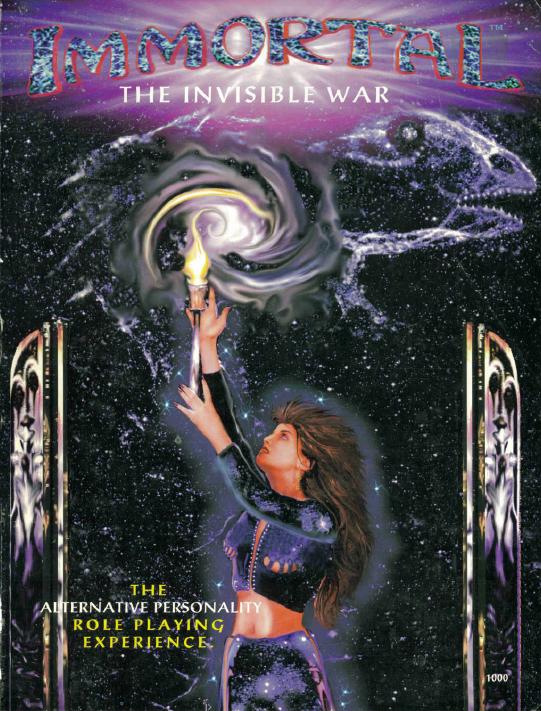
Now that this thread has seen the likes of Kult, SLA Industries, Fading Suns, Amber, and RIFTS, I think it’s time to do a game that out-90s all of them. If Vampire: the Masquerade is the quintessential 90s game, then Immortal: the Invisible War is as if someone deliberately tried to cram all of the most eye-rolling stereotypes of 90s game design into a single game in an attempt to create a deliberate caricature. Let me put it this way: If 90s games were French cuisine, Vampire would be cassoulet, and Immortal would be some kind of terrine made of baby duckling eyeballs.
In order for any of the above paragraph to make much sense, it’s necessary to answer a question which has been asked in this thread but never conclusively discussed: What is “90s game design?” I’ve thought about it a bit, and come up with the following:
”Simulationist” system : There are certainly some exceptions, but as Ron Edwards would later point out, most of these games’ rules were more-or-less based on trying to simulate the game world in terms of things like Strength attributes and handgun damage, rather than fully embracing “story game” rules.
Pretension : Attempts to insist that this is not just a game, no seriously, guys. Trying to elevate the medium with the insistence that roleplaying (at least the way this game does it) is legitimately theatre or a tool for personal spiritual development.
Narrative Worldbuilding : These games were all about developing their setting, often with very long descriptions of historical epochs, settings, and major NPCs--often at the expense of remembering to build in handholds for PCs to latch onto.
Metaplot : Plenty of these games had a setting which continued to develop (or at least to have its secrets revealed) along with the supplements. Again, whether or not the changes were relevant to the PCs, or the PCs could actually influence them instead of getting a telegram that a major NPC had done it, was a secondary concern.
With the possible exception of the first one, and a quintuple heaping helping of the second, Immortal has these in spades.
isildur posted:
I wanted to like Immortal so much. I kept feeling like my inability to comprehend any of it was somehow my fault. Like I wasn't good enough for it.
So here’s my personal history with Immortal: I found a copy in a hobby shop when I was a teenager, but my Dad wouldn’t let me buy it--after my parents got me a copy of Vampire for Christmas, they realized what they’d gotten themselves into and decided these creepy weird books might make me worship Satan. But at the time, Precedence, the game’s publisher, had a pretty detailed website about it, and I pushed my dialup connection to the limit reading stilted scraps of Immortal’s bizarre and very detailed setting. When I found a hardcopy in an underground comic shop several years ago, I laughed, bought it, leafed through it, and promptly forgot about it--so a lot of what we read will be a surprise to me as well.
Now that I’ve really oversold it, let’s get started.
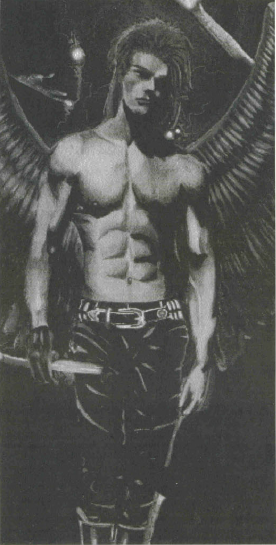
Don’t cry, angel goth. It can’t rain all the time.
On its Credits page, Immortal reminds us that it’s a work of fiction, “another rendition of history and mythology,” and that people who can’t distinguish fantasy from reality shouldn’t play it. So if you’re schizophrenic or you think Reagan was a good president, leave this one alone, okay?
The first page of actual content is a “Translator’s Note” by Jonathan of Masada--yep, it looks like there’s a halfhearted attempt to present the rulebook as an occult text on the secrets of the Immortals. Jonathan, whoever he is, tells us that he’s italicized all the Immortalish jargon and put it in sidebars, that this book is a compilation of efforts by “twilights” and immortals alike, that he hopes the “prides” will listen to something called “Radio Eternity,” and thanks those who gave him information and “conundrum shards” for his work.
Okay.
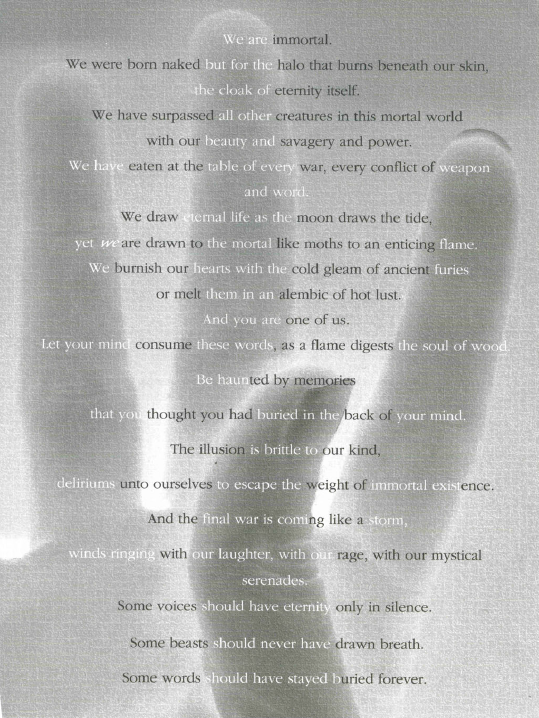
We are Jack’s creative writing class.
A Brief Chronology of the Immortals
”Time is a rare and precious animal. Immortals have learned to let it live forever, but humankind chases it always, then kills it when they discover it cannot be caged. If we have enemies among the twilights, they will suicide themselves with the rope of eternity long before they learn to weave from it an existence like ours.”
--Minerva, Behind Caligula (whoever that is), explaining that time is an animal that is also a rope that is also some kind of cloth.
65 million BC : The Sanguinary appears from the Crucible and shatters into shards, called conundrum.
62 million BC : The conundrum shards join with various reptilian species, making them immortal. These immortals, the Abzulim, drive all other dinosaurs to extinction.
60 million BC : The Sunedrion, a tree with roots reaching into the Crucible, becomes sentient and spreads seedlings throughout the Dominions, whatever those are.
50 million BC : The Tautha and Morrigan prides, whoever they are, are founded.
22 million BC : The height of the Abzulim empire.
19 million BC : The Arachne, whoever they are, take control of the Hive, whatever that is, and become a pride, whatever that is.
18.5 million BC : “The Abzulim Samael engenders the Anopheles.”
7 million BC : The Abzulim war with the Primals, whoever they are. The reign of the Abzulim ends.
6.5 million BC : The Anopheles, whoever they are, summon the Trine (The Rukshasa, Dracul, and Leviathan, whatever they are) from the Crucible to protect themselves.
5 million BC : Pride Peri, whoever they are, is founded.
400,000 BC : The Shattering: The Anopheles oppose the Sanguinary’s forces and destroy the Malice Shard, whatever that is. The mortal Habitat and Immortal Dominions are separated.
370,000 BC : First contact with the Bete Noire, which are animals controlled by the Sanguinary.
320000 BC : Humans destroy the Red Shard, the primary conundrum storing the Sanguinary’s intelligence. The Sanguinary survives by fleeing into the realm of mortal dreams, which becomes the Morpheum. (This wins the prize for best-explained entry.)
300,000 BC : The discovery of religarum, the process in which mortal beliefs force immortals to change form according to mortal superstitions.
144,000 BC : Pride Nimrod is created in the Garden, whatever that is.
99,000 BC : Pride Terat emerges from the Underworld, whatever that is.
65,500 BC : The prides Magdalen and Eremite appear. The entity called Solitaire, whoever that is, builds Atlantis as a haven for wayward immortals.
65,200 BC : Beginning of the Shouting War, whatever that is, which lasts 50,000 years. A magical disease called The Lash is created as a result of using serenades, whatever those are.
[50,000 BC : The Perishing. The Lash is at its peak, killing over 80% of immortals in the Dominions.
40,000 BC : Appearance of The Dust, an avatar of the Sanguinary.
28000 BC : A twilight group called the Apocrypha break free of Magdalen control and form the first Quiet Culture, whatever that is.
10,200 BC : End of the Shouting War. Nimrod emerges as the victorious pride, and imprisons all the others in Sheol, whatever that is.
7000 BC : Pride Banjax escapes Sheol, and invents a rite called lethe to help mortals blend in with humanity.
6000 BC : Something called the Stratagem is invented to prevent further war. Things called Callings are invented to help out with that. Something called The Jury is formed.
5900 BC : The Mingling: All prides abandon identity politics (seriously) to live at peace in Atlantis.
4735 BC : Atlantis is destroyed and Solitaire is assassinated. Immortals flee back into the Habitat, which I gather is our mortal Earth.
3720 BC : Pride Morrigan attempts to flood the entire Mediterranean, “but is stopped.”
2850 BC : The Dracul creates a pride named after itself.
2500 BC : The Horned Lord, whoever that is, creates Pride Phoenix in Troy.
1480 BC : The Femme Darkle, a vampiric relic, is created from an ancient Abzulim’s brain .
625 BC : D’arcade, an immortal organized crime ring, is created.
338 BC : Alexander the Great is made an Immortal of Pride Phoenix.
146 BC : The Eremites destroy
61 BC : The Magdalens back Julius Caesar.
68 AD : The Eremites burn Rome.
410 AD : The Morrigan war with the Sanguinary. King Arthur is crowned.
542 AD : The Dust arises from Egypt, spreading a plague that would go on to kill 100 million mortals.
1118 AD : Pride Phoenix infiltrates the Knights Templar and makes them into a Quiet Culture.
1212 AD : The Children’s Crusade. Pride Peri makes many of the dying children immortal to save their own fading pride.
1258 AD : The Dracul assassinate Kublai Khan.
1503 AD : Nostradamus takes control of the Apocrypha.
1585 AD : The Magdalen support Shakespeare, who later tries to escape their influence.
1666 AD : The Great London Fire is started to destroy The Dust. The Exodus, whatever that is, begins.
1789 AD : A mysterious artifact starts the French Revolution.
1838 AD : Springheels Jack, a Magdalen experiment, wreaks havoc in London.
1912 AD : The Titanic is sunk by the Leviathan. (As an aside, this book fucking loves the passive voice.)
1919 AD : The Tryst Migration begins, allowing immortals to control the Habitat. This somehow causes the Roaring 20s. My grandfather is born.
1925 AD : The Silhouette, current avatar of the Sanguinary, appears.
1939 AD : A power struggle within the Eremite pride results in WWII.
1948 AD : Ghandi, an Eremite, is killed by supporting a splinter group, the Celestials.
1963 AD : JFK is assassinated as a byproduct of an Arachne plot.
1970 AD : The Silhouette kills 50,000 in Pakistan.
1977 AD : The Silhouette causes the New York Blackout.
1990 AD : The Femme Darkle is stolen. The Invisible War, whatever that is, begins.
1994 AD : End of the Exodus, whatever that was. The Waking Age, whatever that is, begins.
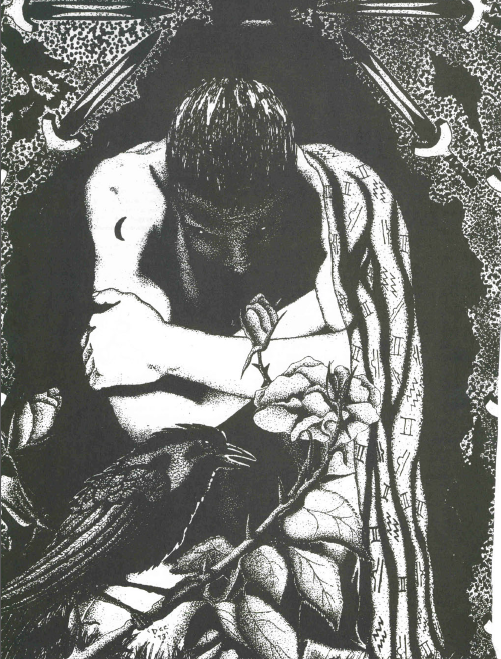
Most of the interior art is greyscale, like my soul
Next time, on Immortal : Fiction and sidebars full of jargon. You all wonder what I’m smoking.
livingplural.tumblr.com
Original SA post Immortal: The Invisible War, Part 2: livingplural.tumblr.com”Glimpse”
After the chronology, we get some in-character fiction, which we all know is always good for a laugh. The unnamed narrator is an immortal clinging to the steeple of a rain-drenched church. He’s probably wearing a trenchcoat and facepaint and thinking that he looks just like Brandon Lee, but it doesn’t say.
An immortal named Rhavi warned the narrator about his Taint. Rhavi told him that Taint was “a cloud of malice that destroys by instinct,” “float[ing] in tiny barbs of darkness, disembodied cells moving about on their tentacle-like cilia.” Taint is the parasite of Immortals, clinging to their Halos (whatever those are). It keeps Immaculum (whatever that is) from flowing from the Cruicible and into Immortals. It’s also the reason mortals grow old and die.
The narrator breaks into the church, noting that his uncontrollable taint was leeching colour out of the frescoes, and cracking the plaster of the walls everywhere he goes.For his taint is “a hungry albatross.” An albatross that is a parasite that is also an angry cloud that is also some kind of jellyfish.
The narrator sees a priest in the church--he looks on him as prey. He wants to kill the man and steal his Immaculum to heal his own wounds. He’s worried because he’s not a good killer, and he was confronted by another Immortal earlier that night, and had to use a Serenade to escape. He’s afraid that the Serenade caused a Ripple which other immortals can detect. Then he goes on a paragraphs-long rant to the effect that he knows immortals of many prides are hunting him, he’s a renegade, the Nimrod wants to imprison all immortals in other dimensions called Mantles, he wonders if the Sanguinary everyone’s so afraid of really still exists, and he’s really hungry and wounded and wants to eat this priest.

The “glowing Play-Doh” filter didn’t make it out of Photoshop 1.0
But wait! One of his “Avatars” named Menes speaks up, a voice inside his head telling him not to kill the priest. Menes was a king, but apparently this “Lethe” thing is something he did to forget who he was and escape from his enemies. Our Narrator has multiple personality disorder, it seems, and Menes wants to be in charge again. The narrator tells Menes to shut the fuck up--his personality emerged when the Banjax attacked them, and he caused the Taint by fucking up a Serenade.
The narrator decides to talk to the priest and start spilling a bunch of nonsense about immortals, mantles, and the Sanguinary. He is almost as confused as I am reading this. Finally, we learn the narrator is a woman named Camille. Her Avatars start arguing over what to do about the priest. Camille admits that her parents with her powers when she awoke from Lethe. Then she scares the priest by briefly turning into her “Himsati” form, a green-eyed cat.
Let me interject something here: Immortal was ten years ahead of its time as a game where you can play a magic furry otherkin vampire having conversations with your “headmates.”
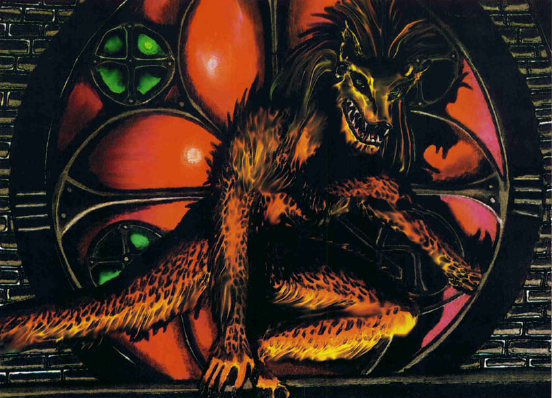
Trigger warning: And on the eighth day, God yiffed.
Camille’s oldest Avatar, Aznen, takes control. Aznen entered Lethe to escape the Sanguinary, creating the Menes personality, and Menes created Camille (or some other link in the chain) when he entered Lethe to escape his enemies. Aznen basically does the same thing, babbling a bunch of irritating stupid nonsense about the Sanguinary and Mantles and Dominions and Nimrod and she’s getting ready to kill him and steal his Immaculum.
Suddenly, she feels the priest’s Immaculum converge, and he blasts her with hellfire! But it doesn’t work, and it seems the projected Immaculum alleviates her taint. It turns out the priest is secretly a member of the Apocrypha, and some immortals taught him “Attentions,” whatever those are. Basically, he played a serenade like immortals do, but fucked it up.
Camille takes control again, and decides not to kill the priest. But it’s too late, as the cathedral door bursts open and some strange shadow creatures drift in--the Nimrod have come for her!
Fin.
That was fucking agonizing.
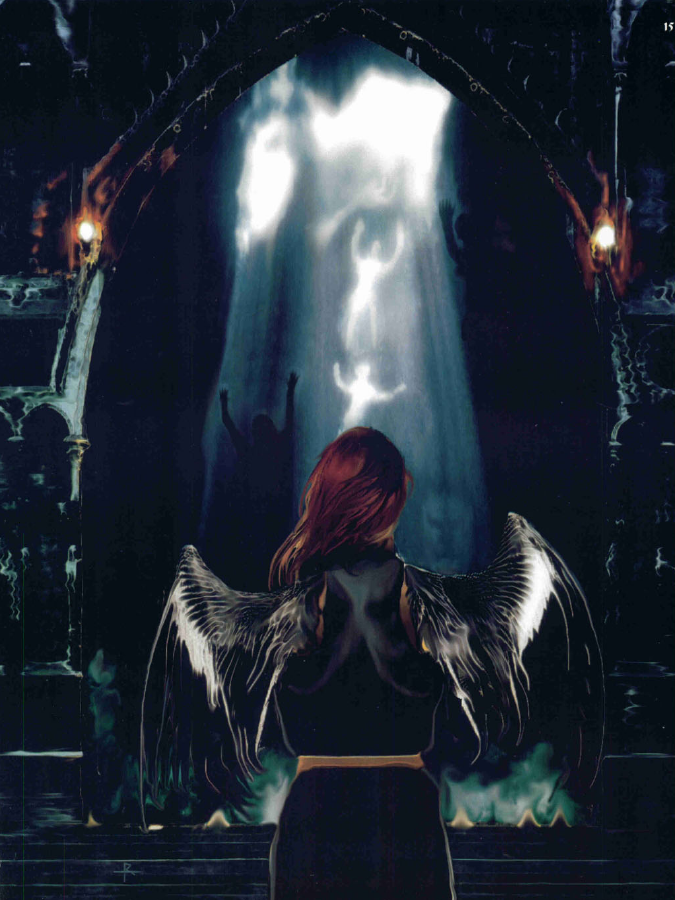
At this point, the book starts its lexicon--a running lexicon. Immortal has so many Randomly Capitalized Jargon Words that it can’t list them al in one place. At the bottom of most of the pages from here on out, there’s a bar explaining a handful of terms. In addition to making the formatting of the book look like utter shit, it keeps up the ongoing theme of “casually throwing around jargon that won’t be explained for a hundred pages.” I’ll be ending each update with the terms covered in the pages thus far.
Aart : Meditation used to keep Avatars from emerging and taking control. This can be used to engage in venery (cannibalizing an avatar’s Immaculum) or freeing the avatar, creating a Scion.
Abbadon : “The black ally,” an aspect of Immaculum used to wield destructive forces.
Abzulim : The first immortal race, created by conundrum shards merging with reptiles at the end of the Cretaceous period. Until recently, believed extinct.
Admah : Lost capitol city of the Banjax, destroyed by the Sanguinary.
Adoil : Archaic name for the Cruicible, from which all things in the universe emerged.
Adze : A splinter of the Anopheles tribe; their himsatis are swarms of colored light.
Al-Sirat : A state where an immortal’s immaculum and taint are perfectly balanced, so they cannot affect or be affected by anything except serenades. Immortals perceive this as a bridge between the Habitat, the Blue Air (whatever that is) and the Crucible.
Ammut : The paragon (whatever that is) of pride Terat, once enslaved by the Nimrod.
Anath : A human immortal whom the Anopheles convinced to produce the Anathasians by breeding with the Rukshasa.
Anathasians : The children of Anath who eventually split into the Eremites and Magdalen.
Ancien Regime : Immortals who’ve never entered Lethe. I suppose they must be incredibly badass, what with having literally millions of years of experience.
Anopheles : A pride produced by Samiel, one of the Abzulim. They are sensualists who manipulate mortals’ desires. Most have reptile himsatis, though some are black leopards.
Ante Bellum : Historical records predating the Shouting War.
Apep : The Banjax’s name for the Leviathan.
Apocrypha : A cult of mortal sorcerers who wish to subjugate all immortals and thus control the world.
Arachne : A pride who led the revolt of the Hive against the Abzulim. Their himsatis are spiders and carnivorous insects.
Ark : A place where an immortal can store Immaculum, and can heal their wounds or revive themselves from death.
Atlantis : Solitaire’s city, which became a safe haven for immortals. It was destroyed in an upheaval of “scions” who turned against their “savants.”
Attentions : Awareness of “specific vibrations of the cosmos that permeates matter and energy.” Attentions are the basis of all immortals’ supernatural powers, including their “serenades.”
Audience : Immortal term for twilights (Christ, can’t they just say “mortal?”) who know about immortals.
Avatar : The separate personalities that form within an immortal when they enter Lethe and mature as a mortal. All avatars are prone to delusions of memory from their first life.
Azeman : A “tryst race,” whatever that is, of Anopheles who have vampire bat himsatis. They suffer a “taboo” which prevents them from entering a doorway with a broom propped over it.
By the way, reading that fiction was so fucking painful I was hard-pressed to summarize it with any shred of coherence. Reproducing the whole thing here would defeat the point, but I want to include a few choice sentences so you can see what I’m up against. The general writing style is “Abominably shitty Anne Rice parody” wherein the protagonist can’t walk across the room without talking about how the wallpaper pattern is so agonizingly beautiful it makes him want to weep, and compares the 60-watt bulb in the floor lamp to the tenuousness of the human experience. Believe me when I say that context doesn’t improve any of the following:
I wondered if anyone heard the cracking of plaster as the thorns of my taint slashed out with my swift passing, or if they saw the color bleed away from the victimized frescoes.
Twilights rarely give me a glance, too enamored with the mirage of their own existence to peer a little deeper, to see what walks along the sidewalks with them.
As for me, I am too luminous at night, a beacon that scorches the night with my beauty.
It was a Banjax that confronted me tonight. I barely escaped with my life. There is a racism even in the surreal world of the immortal.
He was small, the type that has silence stitched onto the soles of his feet.
I felt like weeping myself for the beauty of these faded seraphs.
Saliva was flowing so copiously in my mouth that I thought I’d drown in it. With great effort I gathered my taint together and tethered it above my head so that the beautiful wood I sat on wouldn’t crack under its ministrations.
At the mention of my slain mortal parents I gripped the pew in mental anguish...I lost control of the taint. It spit a viral tendril wheeling away from the rest of the mass, covered with serrated spines and murdered the flame of a candle. The light was torn apart, I could hear the sound of the fire dying. The wax gave up its form and bled over the altar.
“We’ve frozen the world with the lash of them. Now we tread lightly, masked by the din of your Habitat. Now do you believe me?”
My wounds still wept red tears.
Next time, on Immortal: Christ I don’t even know
Elfgame of Thrones
Original SA post
Immortal: The Invisible War, Part 3: Elfgame of Thrones
Did I mention that this book is not divided into separate chapters in any meaningful or clearly marked fashion? Because it isn’t.
The next section is confusing in a new and different way: It’s a communique from the Nimrod agent who captured Camille to her superior, discussing the interrogation of Camille as well as the phenomenon of ingenues--immortals who entered lethe, lived one or more mortal lives, and are now remembering their immortal nature, along with the superpowers and dissociative identity disorder that entails.
This section starts using sidebars as well as the bottom-bars (is there a better word for that?) to explain key concepts of Immortal. Half of them are in the form of quotes, thus mostly defeating the purpose. Meanwhile, all these jargon words are bolded and italicized in the body of the main text, which conflicts with the idea of this being a secret letter. Remember, this is a roleplaying manual, pretending to be a secret letter, pretending to be part of a compendium of immortality put together by “Jonathan of Masada,” so we’re dealing with layers of conceit here, none of which we can readily puzzle out.
The Nimrod agent, Lady Seana, has learned from Camille’s interrogation why thousands of immortals disappeared after the battle in 1666 which resulted in the Great London Fire and the destruction of The Dust: they entered lethe en masse. You see, when its avatar The Dust was destroyed, the Sanguinary survived by fleeing into the realm of dreams. Immortals sleep, but they don’t dream--unless they enter lethe, forget their identities, and become effectively mortal. They entered lethe so that they could scout the enemy without even realizing it, and be armed with that knowledge when they reawoke.
(How exactly this transition takes place isn’t adequately explained. Camille mentions that she might have been a changeling, switched in a hospital bed with someone else’s child, but that doesn’t answer how she physically transformed into an infant. She also implied the possibility of living several mortal lives without reawakening as an immortal, which doesn’t answer the obvious question of how one grows old and dies several times. Since immortality has a physical component, the conundrum shard, reincarnation seems out.)
That’s not all! Seana has an intriguing theory--she’s been investigating a connection between the emerging ingenues and this so-called “role-play game” subculture. These “gamers,” she finds, are more intelligent and creative than the average person, and gather together in small groups of close friends to assume imaginary roles, including creatures like vampires and werewolves! When they sent some agents to investigate a group of roleplayers, they generated a “religarum” that forcibly reverted the immortals to their animal forms. Some of the ingenue have even infiltrated roleplaying game companies!
So there you have it, dear reader. You, the person reading this forum post, are secretly a millions-years-old immortal that was born when a magic crystal infected an animal’s brain. This has great implications for something called the “strategem.”
Following this is a brief transcript of Camille being interrogated. She insists that the immortals who vanished after the last battle with the Dust were not casualties, but entered lethe en masse, and she can tell that her interrogator, something called a “scourge,” knows this. Soon after she lapsed into a coma and was moved to a secure facility.
I’ve noticed that Immortal doesn’t necessarily have any more jargon or setting-specific terms than, say, Vampire or Mage, except that what Vampire would’ve spread across several supplements, Immortal insists on wedging into the corebook. Hereafter, I’ll italicize the jargon words that seem actually important for a player to know.
Babbler : Immortals have a highly-developed corpus callosum. Sometimes this results in a phenomenon wherein conscious and subconscious merge, and the immortal becomes completely delusional, entering ennui and allowing another avatar to take control of the body.
Babel : A dominion, former capitol of the Anopheles, destroyed by the Anathasians. (See? This game thinks that cities destroyed millions of years ago need to be included in the glossary.)
Babylon : One of the Nimrod’s three cities.
Bad Spill : When an immortal is slain and his taint spills out, infecting the area with his “taboos,” whatever they are.
Ban : The curse the Nimrod placed on the Magdalen using the Femme Darkle; it prevents them from taking immaculum from willing immortals, forcing them to “Sin.” (For comparison, imagine if every Clan Weakness in Vampire had a name that had to be included in its glossary.)
Banjax : One of the prides; they were originally generals blamed for the Shouting War, but they freed themselves and the other prides from Sheol.
Ennui : When the delusional symptoms of different avatars struggling for control become too much, the immortal enters a comatose state. Compare to Vampire’s torpor.
Highbinder : Mentioned, but not defined.
Himsati : An immortal’s original, native form. Usually an animal, but some immortals were created by conundrum shards merging with plants, minerals, or even air and light.
Odyssey :A drug that makes you temporarily forget important memories, then relive them as if for the first time when they reemerge. Increasingly popular with both mortals and immortals.
Pride : The different factions of immortals, mostly divided based on their himsati forms. Compare to Vampire’s clans.
Probe : Mentioned, but not defined.
Religarum : Mortal beliefs and superstitions have the power to induce forced shapeshifting in immortals, based on those beliefs. Over time, this is what caused all immortals to adopt a human form.
Solitaires : Mentioned, but not defined.
Stratagem : Mentioned, but not defined.
Next time, on Immortal : Thirty pages in, we kinda, sorta, begrudgingly tell you what this game is and what it's about.
Who is your daddy, and what does he do?
Original SA post
Immortal: The Invisible War, Part 4: Who is your daddy, and what does he do?
This seems to be as close as Immortal ever gets to a “what this game is and what it is about” section.
And I remember...
In typically overwrought and roundabout language, we are told that immortals are the inspiration for all mythology--what we call mythology are the scraps of truth they left behind for us to find, intentionally or otherwise. Immortality gave them intelligence above and beyond what evolution and natural selection required of them, and immortality itself freed them from the need to struggle to survive like other living creatures. Since eternal life and virtual invincibility tend to rob you of a sense of urgency and meaning, they became fascinated with the mortals, and allowed human civilization to develop beyond their ability to control and enslave mortals, even if they wanted to--and they don’t, since they don’t need to fight over resources, and meddling with civilization would spoil the show.
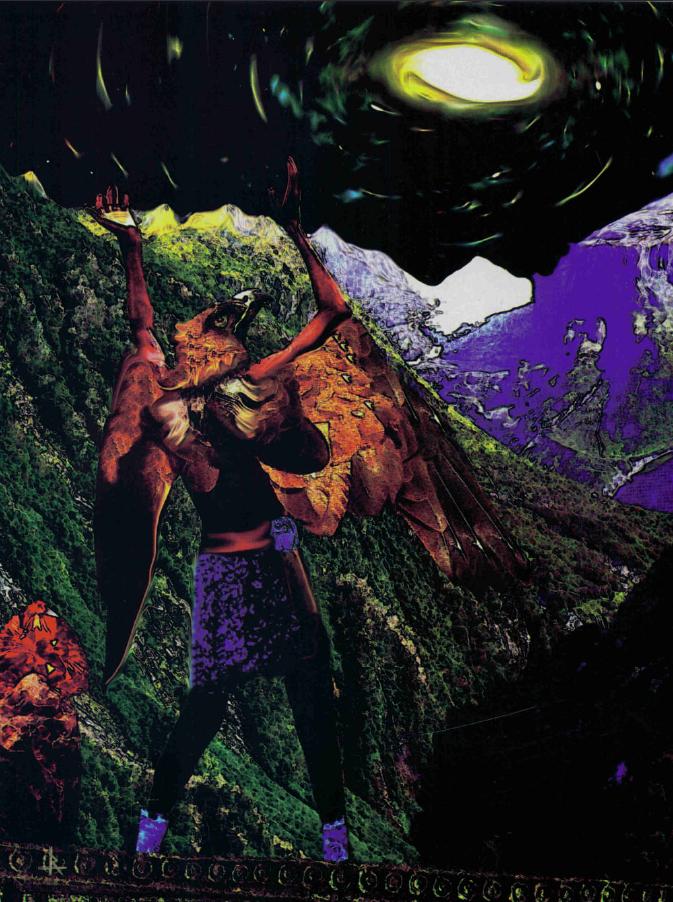
I’ll see you...in Zoobilee Zoo
So, it turns out you’re an immortal ingenue. Your fellow immortals thought you died in the battle of 1666, but you entered lethe because you knew that being reborn as a human was the only way to figure out what the Sanguinary was doing, hiding in human dreams. If the other immortals blame you for what you did, it’s because they don’t understand. Or maybe the wiser immortals knew what was up all along, and the status quo is just a farce.
Immortal: The Invisible War is “more than a role-play game. It is an experience which transcends the limitations imposed by era, genre, culture, and gender,” which is why it comes across as a painfully dated pander to the New Age Young Adult market.
So, about your being an ingenue: You performed the ritual of lethe, which caused you to forget your perhaps tens of millions of years of memory, appear human, and even die and be reborn as a human several times. Being human allowed you to dream, because while immortals do sleep, they don’t dream--they could, but they risk being possessed by the Sanguinary. Although you lived several lifetimes without realizing you were immortal, you’ve always been a dreamer, drawn to the arts and “those things that mock the dullness of the world.” In other words, if you’re reading this book, you must secretly be an immortal because you’re a sensitive special snowflake.
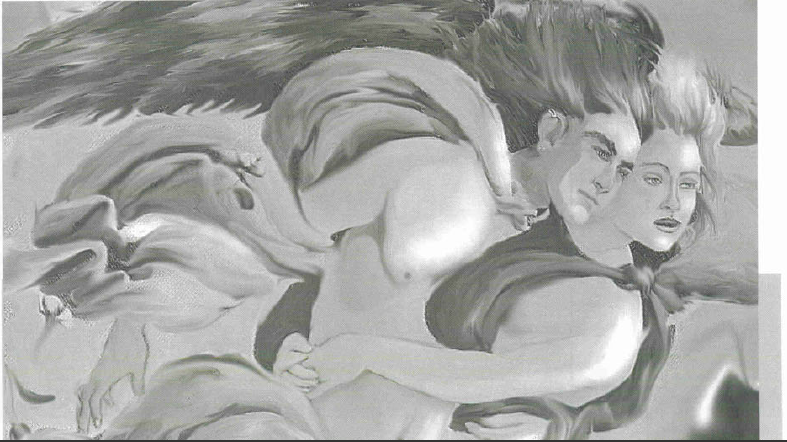
And Icarus flew ever higher, saying, “Look, I can see my house from here.”
Immortal is a “retro-mythic experience,” we are told. Although it has rules that involve character sheets and ten-sided dice, don’t worry about that! Invite some friends over and just start roleplaying as immortals. This is, of course, totally impossible as we don’t even fully understand the premise yet and the setting and rules info is tangled together like two slugs fucking.
Back to the ingenue again. Immortal players assume the roles of ingenue, who are beginning to emerge from lethe in greater and greater numbers in the early 90s. The ancient prides are beginning to realize that the ingenue are probably the last best hope in the war against the Sanguinary. The “Perpetual Society” will try to fit them into the politics of that “stratagem” thing that still hasn’t been defined. The “solitaires,” whoever they are, will try to set them up as leaders to challenge the authority of the ancient immortals. The Sanguinary’s goons will try to kill them for fucking with it.
PCs can discover their abilities as they go--on the fly, the Narrator can ask the player how good he thinks his character is, and the player can spend memory points to make that happen. (We haven’t been told what memory points are, or what stats we’ll be spending them on.) Oh, and you’re encouraged to bring across characters--sorry, personas --from other roleplaying games as past lives of your Immortal PC! Isn’t that fun?
Immortals are banded together into cadres --groups of immortals who entered lethe together, and were drawn to one another in their subsequent mortal lives.
Bassarab, Vlad Drakul : A Wallachian who was recruited into the Drakul pride, and acquired a vampiric reputation because of his Adze minions. His dynasty fell a few years before the battle of 1666. I don’t know why that’s important either.
Hush-hush : The “dark place where the [Sanguinary] thrashes in its own nightmares.” A Good Name.
Religarum : Already defined in the footnotes, but brought up again in a sidebar. Intense human beliefs create a vibration similar to immortal serenades. Immortals can’t manipulate these vibrations, and become hypnotized by them, and then start to change form to mirror the mortal’s beliefs.
Sanguinary : A godlike creature which emerged from the Crucible, the source of all existence, and split into many conundrum shards when it crash-landed on earth. It’s endlessly malevolent, and wants to possess all immortals and reconstitute its body in the physical world. It’s like Sauron, and unfortunately, the magic rock in your brain that makes you an immortal is also a bit of its One Ring.
Eternity
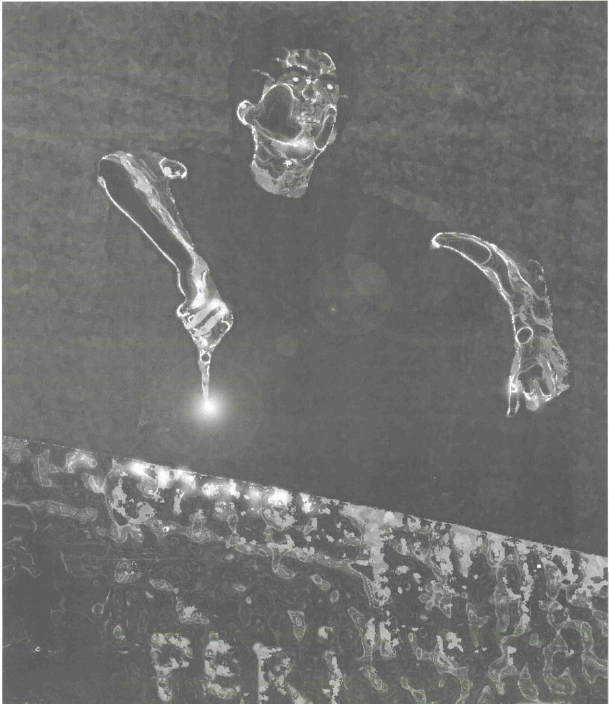
Daniel-san is gonna get it.
And now a bit of actual, lucid setting history: The first immortals were created about 65 million years ago, when the Sanguinary crashed into Earth and shattered into fragments. These fragments bonded with some animals and gave them immortality and the spark of sentience, while the ash and dust kicked up by the Sanguinary’s impact killed a great deal of life on earth.
The premier immortals were the Abzulim, immortal reptiles and dinosaurs. They were smart and powerful, but had a penchant for enslaving the immortal mammals and insects and birds and suchlike. When they became complacent and reliant on the slave society they’d created, the younger prides overthrew them in a bloody revolution.
When the mysterious beings who live in the Crucible exiled the Sanguinary, it created a rent which allowed immaculum, pure lifeforce, to flow into the universe. Immortals can sense and harmonize with these cosmic vibrations, which forms the basis for all their powers. The flow of immaculum caused plant life to feed on it and merge with it, creating the immortal Sunedrion tree. The wording is very vague, but it seems that the Sunedrion is a sort of metaphysical World Tree reaching from our universe to the Crucible.

fuck you im a dargon
Even though immortality granted intelligence and self-awareness in simple birds and reptiles, their basic fight-flight-hunt-kill-fuck instincts didn’t just vanish. All those irrational instincts got shunted into the himsati form. The himsati isn’t just an animal (or plant, or cloud) form you can shapeshift into, it’s the part of the immortal mind and soul that rejects sentience and intelligence in favour of mindless instinct and violence. Oh, and the fragment of the Sanguinary’s intelligence that lives inside you, wanting to rejoin it? The himsati is where it lives, so think twice about literally going apeshit on someone.
All immortals can assume human form, in order to blend in. It’s hard to study immortal anatomy, since they disintegrate when killed. Gruesome vivisections have taught them that the conundrum shards reside mainly in the brain, giving immortals of all species a highly developed corpus callosum which is part of their ability to perceive the “music of the spheres,” so to speak. Immortals perceive the laws of physics and natural phenomena as music, and when they use supernatural powers to alter the universe, they do it by literally speaking and singing. Their vocal chords, which are also altered by the conundrum, are called vox.
In an irrelevant aside, we’re told that immortals, whose human forms are shaped by human expectations, are usually beautiful and are distinguished by “vividly bright” or “broodingly dark” eyes, and luminescent blood. Here, have your Mary Sue badge.
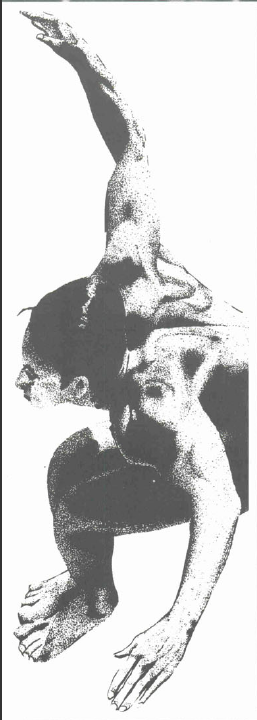
Alfalfa goes for the somersault pike
The downside of the immortals’ hyperevolved brain is a phenomenon called the babbler, a perpetual voice in their head that takes the form of logic vs. intuition. In extreme cases, it causes mental illness and sensory deprivation. Dreaming can alleviate it, but immortals choose not to dream, because it can allow the Sanguinary to possess them.
Immortals consider humans (I refuse to keep typing “twilights”) a precious resource and find them endlessly fascinating, but the fact that the Sanguinary is currently hiding out in human dreams contaminates their relationship with humans. Even without religarum, immortals are prone to becoming vain and affected in an attempt to live up to their own legend.
Immortals enter lethe in order to forget their past and be able to approach life with a fresh perspective. The problem with lethe is that every time they enter or remerge from lethe, their mortal and immortal identities don’t integrate, but join a chorus of separate personalities called avatars. Sometimes one avatar even tries to take over as the dominant personality. Immortals can allow an avatar to take over temporarily, even shapeshifting their apparent age, race, and sex to match the avatar, but eventually the avatar becomes exhausted and needs to sleep. A well-balanced immortal will only encounter his avatars in passing when he needs to let them emerge. (So, not Camille.)
Strengths and Weaknesses
An immortal’s body is just a shell for his “halo,” some kind of spiritual aura that hasn’t been defined yet. Since immortals are constantly echoing cosmic vibrations that protect them from entropy, they recover very, very quickly from wounds--falling off a skyscraper or being hit by a truck is just a momentary inconvenience. The exception to this is when someone else is close enough for their halos to overlap, which fucks up their healing ability--so guns are almost useless against immortals, but hand-to-hand combat? There Can Be Only One.
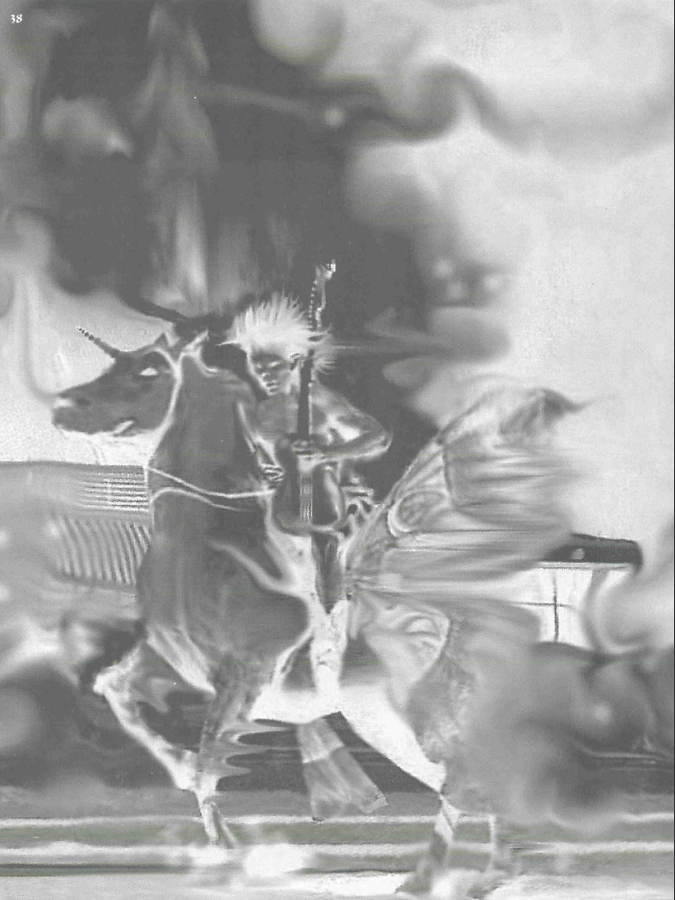
Would you pay $30 for this Tarot deck?
Poison is a unique mortal weakness--they don’t metabolize toxins well. An immortal whose been poisoned can suffer its painful symptions for hundreds or even thousands of years. Only a rare element called palladium, which is solidified immaculum, can cure a poisoned immortal.
As said before, immortals are vulnerable to religarum, a process wherein mortals with strong beliefs unwittingly force the immortal to shapeshift to match their expectations. Immortals also become infected with Taint when they fuck up a serenade--they accidentally draw energies from the Dominions into themselves, which darkens parts of their halo, making them weak and unusable. Immortals are forbidden from stealing immaculum from mortals to heal Taint, but “the practice of Lullaby goes mostly unchecked,” whatever that is.
More on immortals suffering Taint: It causes animals who resemble your himsati form to hate you, and be drawn to you from miles around. These animals are, quite counterintuitively, called companions. So if your himsati form is a tiger, felines will hate you and maybe even attack you. Any wounds inflicted by a companion are automatically one wound rank higher, take twice as long to heal, and afterward, if you even see an image of a companion, you suffer a “red pain hostile.” (Nevermind that we haven’t seen any of the rules yet, much less comabt and damage.) If your himsati is something more exotic, like a pillar of fire or mass of metal, you might take damage from sunlight or silver, like a vampire.
In order to (mostly) kill an immortal, you have to stop their vox by severing their head. You may be able to recover their vox, but that’s up to the narrator’s discretion. It’s considered profane to rip out an immortal’s vox and own it, but a vox is nearly as valuable as an unmerged conundrum itself. When removed, it appears to be a glowing crystal reed.
So, when an immortal bites it, their immaculum spills out in a phenomenon known as a “Spill.” god, this game loves its pointless jargon. Nearby immortals can absorb some of it. The himsati is freed from the body, and will either go looking for immaculum to absorb, or retreat into a sort of afterlife dimension called the Blue Air, wandering about as a ghostlike spirit. The danger of remaining in the mortal world as a himsati is that it’s very easy for the Sanguinary to detect you and send its minions after you. The Blue Air is a peaceful-sounding “ocean of atmosphere” that you can wander around for hundreds or thousands of years; the problem being that you’re kinda stuck there for hundreds or thousands of years.
A himsati can become a familiar to a mortal, doing things for the mortal in exchange for immaculum that will eventually allow it to restore itself. Immortals also maintain things called arks (which were first mentioned 20 pages ago when it wasn’t relevant). Arks are, quite frankly, a save point. You make a place a battery of immaculum, and if there’s enough in the tank, you’ll reform there if you get killed. You can save up immaculum and then dump it in your ark, or better yet, you can get help from a “quiet culture” ( what the fuck are these? ) who will set up your ark as a shrine or temple and contribute their own lifeforce to the ark.
Fuck you, Ghost Dad
Immortals doing immortal-ish stuff generates a Ripple in the cosmic vibrations, which can be detected by other immortals--and if it’s strong enough, by the Sanguinary. The most powerful immortals generate a noticeable ripple everywhere they go, and all immortals make a ripple when they play serenades. “The Silence” is the immortal law that forbids playing serenades on each other; every big shitstorm in immortal history involved powerful ones having pissing contests with their kewl magik powerz. The Perpetual Society--we still don’t know what that is, either--has sanctioned the Nimrod pride to be the enforcers of the Silence. There are some immortals who’d rather call out the Sanguinary and fight it in the open, but most are afraid that another war of serenades would lead to another outbreak of the Lash, which could drive immortals and mortals to extinction.
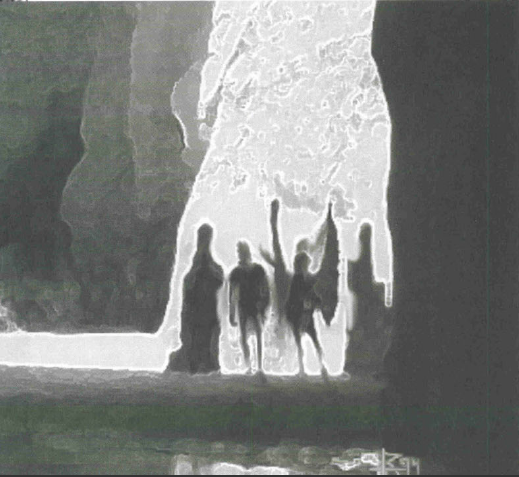
Jonathan of Masada’s Allegory of the Cave
Immortals don’t naturally belong in the Habitat. (That’s Earth, remember?) They spent millions of years living in the dominions, alternate dimensions branched off from the Habitat. Unfortunately, they were magnificent shitwizards and turned the dominions into barren, Lash-ravaged wastelands. When an immortal’s Taint is greater than the amount of immaculum in their halo, they cross over to the dominions. They’re really, really afraid of this, so in order to remain in the mortal world, they have to take immaculum from immortals. This can happen willingly, in which case, no problem--obviously losing too much immaculum will fuck you up, but giving immaculum to an immortal is better than any acid trip Roger Sterling ever had. It’s easier for immortals to just steal immaculum--it’s called sinning, and there’s a law against it which is virtually unenforced. Sinning is its own punishment, though. It’s traumatizing for the mortal, and causes a burst of religarum that results in a “psychic albatross” called a “taboo.” I’m sure we’ll find out what that is in a hundred pages or so.
Beheading : The only reliable way to (mostly) kill an immortal. It works by separating the connection between the brain and vox. When you behead an immortal, their immaculum spills out, the himsati is let loose, and the himsati soul either goes to some place called the “Blue Air” as a “Gossamer” or remains in the living world to try to absorb immaculum and reform itself.
Believers : Mortals who help immortals, usually because they don’t fit into normal society. Believers are the basis of the “quiet cultures,” whatever they are.
Benendanti : A renegade member of the Apocrypha who, after being imprisoned in Sheol, helped the Banjax liberate the immortals. He was rewarded with immortality and started the first quiet culture, whatever that is.
Benison : An immortal holiday that commemorates the founding of Atlantis.
Bete Noire : Animals possessed by the Sanguinary.
Highbinder : One of the “callings,” whatever they are. Bounty hunters working for their pride.
Next time, on Immortal : Rules! Actual, possibly even decipherable rules!
Calling a Rabbit a Smeerp
Original SA post
Immortal: The Invisible War, Part 5: Calling a Rabbit a Smeerp
”The sleep of your people is with open eyes; it is the sleep of the dreamless on high. Better for heaven to have your eyes, but not your enemies.”
-- Dante the Raven Scepter, AD 1307 , reminding me how much I prefer the Dead Can Dance lyrics quoted in White Wolf books.
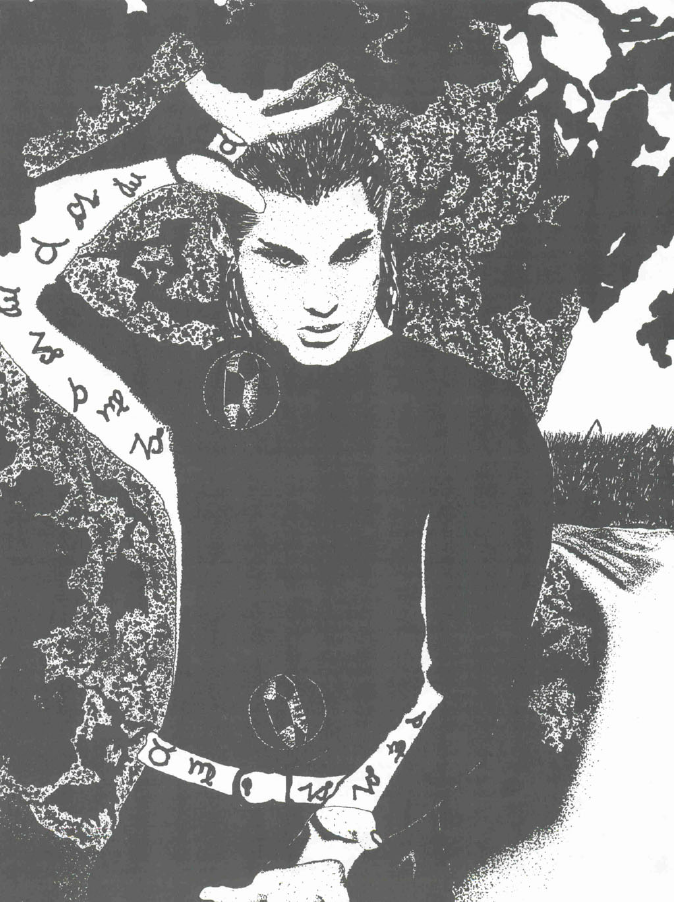
Did you know that Tears for Fears went Satanist? I didn’t know that.
When necessary, Immortal uses combat rounds with a three-step resolution process. In or out of combat, however, Immortal uses a one-roll system that is “simple and universal,” “as realistic as possible,” and “designed to be balanced.” They should have named this game Immortal: Every Universal Game System Ever or Immortal: Dungeons and Dragons Fifth Edition.
Pink and Orange and Yellow and Green, the Colours of my Dice
Immortal combat (it keeps describing its system as regards combat) uses 6 ten-sided dice for all tasks, in six different colours: red, orange, yellow, green, blue, and violet. They don’t explain why. For warps, a certain type of serenade, you also need a black, grey, and white die. They don’t explain why.

The art in this chapter really conveys the feel of trying to read it.
The die that you roll represents a hostile , a term meaning the challenge that is interfering with your attempts to do something--pain, darkness, unstable terrain, whatever. The more of these factors are present, the more hostile dice you roll. So if we’re challenging...whatever the colour orange represents, and you’re trying to do... something orangey on a tightrope in the dark while wounded, you actually need to roll multiple orange dice. Then you...add them? Take the highest or lowest? Try to get over or under your...orangeness? They haven’t told us what the character stats are, what their number range is, or how they correspond to the dice.
Ah, an example! “Awareness” is a blue characteristic. When your awareness is challenged, you roll a blue die. If you were injured, you’d also roll a red pain hostile at the same time. You have to succeed against every hostile die to pass the test. Any time you roll a 0 (or 10, I suppose) on the hostile die, it’s a null, or automatic failure. Multiple nulls cause dramatic failure, and when playing serenades, nulls cause Taint. (So a normal, unmodified roll by a superhuman immortal has a 10% chance of automatic failure? Neat.)
Okay! All living creatures have an aura called a halo , which is perceptible to Immortals as both light and sound. It’s the lifeforce energy that measures how strong, smart, fast, etc. you are. Someone who has high Awareness has lots of Immaculum in the blue part of their halo--that’s why Immortal measures attributes in terms of colour and (needlessly I think) insists on using differently coloured dice for different rolls.
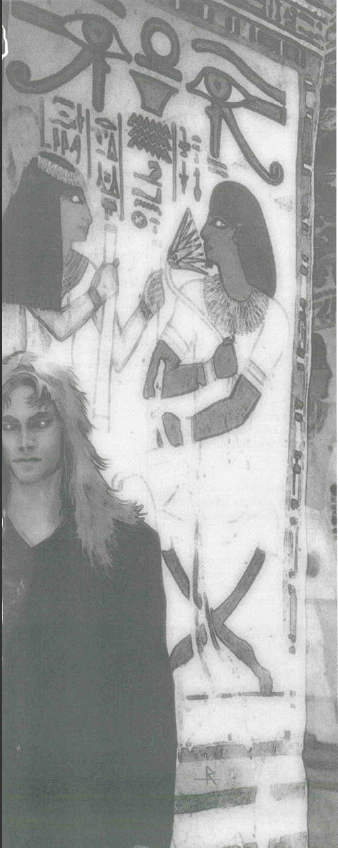
Nefertari never got tired of the “Got your nose” gag.
Immortal uses the term motes to denote “the number of points you have in something.” The normal human range is from 0 (children, elderly, disabled) to 5 (human maximum) with Immortals having attributes as high as 15. The characteristics are as follows:
 Red (Resolve): Intelligence and willpower. Used to resist domination, pain, and mental challenges, and to block avatars from taking over.
Red (Resolve): Intelligence and willpower. Used to resist domination, pain, and mental challenges, and to block avatars from taking over.
 Orange (Force): Strength, including encumbrance, grappling, hand-to-hand damage. Also used to extend the duration of serenades.
Orange (Force): Strength, including encumbrance, grappling, hand-to-hand damage. Also used to extend the duration of serenades.
 Yellow (Expertise): Agility and coordination. Examples of use include off-hand fighting and fighting in cramped quarters.
Yellow (Expertise): Agility and coordination. Examples of use include off-hand fighting and fighting in cramped quarters.
 Green (Movement): Movement rate, as well as dodging and accurately hitting a target that’s small or undercover. Also used to target individuals in a crowd with serenades.
Green (Movement): Movement rate, as well as dodging and accurately hitting a target that’s small or undercover. Also used to target individuals in a crowd with serenades.
 Blue (Awareness): Senses and attention to detail.
Blue (Awareness): Senses and attention to detail.
 Violet (Resilience): Endurance and toughness, as well as resisting fatigue, discomfort, and poisons.
Violet (Resilience): Endurance and toughness, as well as resisting fatigue, discomfort, and poisons.

There seem to be some weird overlaps between Red and Violet, and between Yellow and Green.
Keep talking, Immortal, I can hear you. Move toward the sound of my voice. Are you trapped down there, baby? Daddy called the fire department and an editor! We’re going to get you out of the well! Just keep talking, baby!
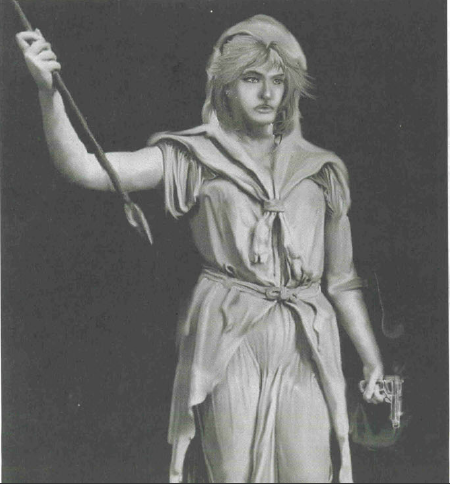
What did you say about my sailor suit?
Talents: Plato’s theory of anamnesis, on steroids
Having lived for millions of years, immortals have phenomenal skills and knowledge and are assumed to know the entire sum of human knowledge when it comes to things like science. However, since the PCs have all entered lethe, they don’t have access to that knowledge. They start with 100 motes of Memory which they can spend to “remember” abilities, and Memory serves as experience points. (We are not actually shown the skill list at this time.)
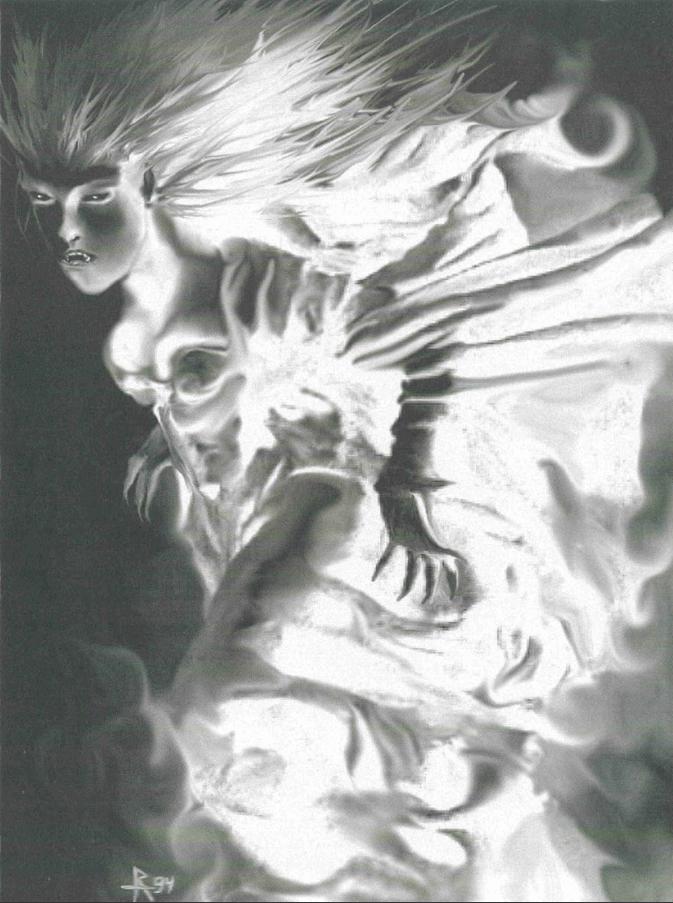
Lestat embraces Lavinia Whateley
Success, Maneuvers, and Modifiers: This is nothing except for what bullshit is
How do we actually roll dice and make tests in Immortal? Let’s use the example of a locked door that you’re trying to pick. The lock is a challenge to your yellow (Expertise) attribute, so you’re rolling a yellow hostile. There is a difficulty number on that die which you must beat. If there are further complications--it’s dark, you’re wounded--each of those is an additional hostile, against its relevant attribute, that you have to beat. So in this example, we’re testing 3 different attributes (Yellow, Blue, Red) possibly at 3 different difficulty numbers. We have to succeed at each one, and rolling a 0 on any of the 3 ten-siders is automatic failure. The roll you make is Halo Motes + Skill + d10. We haven’t been shown the skill list, or told the difficulty range. And you thought locked doors were a bitch in Amber Diceless.
Immortal hasn’t actually told us how to roll dice and make tests yet. For those of you keeping track, this is where the book moves from “bemusingly kooky” to “I want to beat the author until my fists are wet.”
System Terms
There is a glossary of system terms. This being Immortal, of course there is obscure setting jargon that is actually not relevant to the system. Let’s bear in mind that I’m not certain the authors really know what a “game system” is at all. Oh, and don’t forget, Immortal is really fond of taking universally well-known roleplaying jargon and using a more pretentious term in its place, such as “persona” for “character.” Get used that.
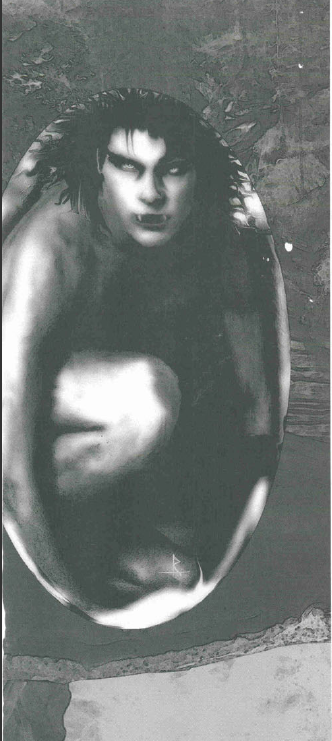
Edward gives Bella a locket with his class picture. From the last time he tried to pass high school. In 1986.
Actor : “Player.”
Ally : Powers that allow serenades to affect the physical world. They’re the reason you need a black, grey, and white die.
Attention : A magic vibration pattern that forms the basis of serenades, defined here for the third or fourth time.
Barbs : Special evil serenades that Sanguinary-corrupted immortals have.
Blunder : Critical failure.
Cage : A hybrid serenade created by combining Attentions and Allies.
Carnals : Combining a mundane skill with an attention to create a supernatural skill.
Characteristic : The attributes, or colours of your halo.
Clash : “Three-second combat turn.”
Echo : A serenade used against a halo colour it doesn’t normally target. I guess that means casting fireball at your enemy’s Resolve characteristic.
Escapade : “Action in combat.”
Essence : “Number of points you have in a characteristic plus any bonuses.”
Exploit : “Critical hit.”
Free Immaculum : Free points of Immaculum that aren’t being used to power your characteristics, so you can move them around or use them to get extra
Forte : “Number of points you have in a characteristic.”
Gossamer : A himsati floating in the Blue Air. (Considered relevant here because lacking orange and violet colours is what makes them immaterial.)
Himsati : You know what this is by now. When you get killed, you revert to your himsati until you gather enough Immaculum to “buy back” your ratings in your halo colours.
Hostile : “A die you roll and add to your Characteristic + Skill to try to succeed.”
Immaculate : Currently free of Taint.
Legacy : A type of serenade that reduces hostiles.
Maneuver : “An attempt to succeed at something.”
Meld : Combining two serenades, or combining two abilities to beat a hostile. Does this involve special rules? I don’t know.
Melee : “Melee combat.”
Motes : “Number of points you have in a thing.”
Narrator : “Gamemaster.”
Null : Rolling a ten/zero on a die is an automatic failure. If this happens while playing a serenade, that’s a point of taint.
Persona : “Character.”
Secrets : A serenade only a particular pride gets.
Serenades : “Magic spell.”
Taint : Impure motes of immaculum, tainted by energy from the Dominion. You can’t use these motes (effectively reducing the characteristic) and if you have more tainted motes than pure ones, you get sucked into the Dominions. And that’s bad.
Vogue : A serenade anyone can learn.
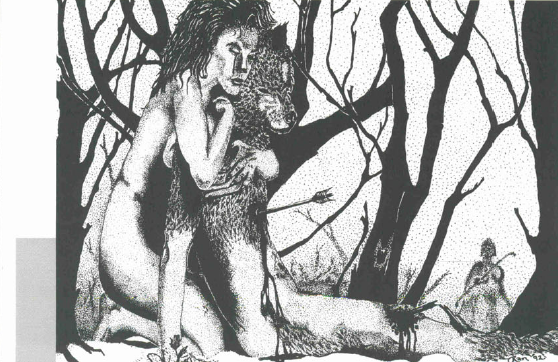
By spending Motes of Free Immaculum to increase their Essence beyond their Forte and multiple Escapades in a Clash, Himsati can Meld an Attention with an Ally to make a Vogue Serenade that is a Cage, roll Exploits against all their Hostiles, and become a man that is a wolf that is a tree that is an archery target.
More sidebarred and footnoted jargon bullshit ahoy!
Blackie : Slang for the Bete Noire. Seriously.
Blazon : The symbol a pride uses to distinguish itself.
Blitzkrieg : What the Germans called the Silhouette during WWII. I’ve already forgotten what the Silhouette is.
Probe : A calling. A pride’s researchers and investigators.
Solitaires : Immortals who refuse to align politically with the prides. Renegades.
Stratagem : The European Union of immortals, it’s designed to allow them to politic against each other without it leading to open warfare. It formally keeps track of prestige gained by exposing a political opponent’s weakness. When the Sanguinary comes, the highest-ranked immortals are the ranking generals.
Next time, on Immortal : Politics, or Fear and Loathing in Atlantis
My teen angst has a body count
Original SA post
Immortal: The Invisible War, Part 6: My teen angst has a body count
Finally, we get to find out what the Stratagem is. As you may or may not remember from previous chapters, in 65,200 BC, a war broke out among the Immortals and lasted for 50,000 years. It was called the Shouting War, because of the unrestrained use of serenades. All that cosmic energy kicking around devastated the Dominions like a nuclear holocaust, and created a psychic disease called the Lash, which causes feral, violent insanity. It became a pandemic across Earth as well as the Dominions, and at its peak, it killed more than 80% of the immortals who hadn’t fled to earth, and turned many of the rest into insane, mutated monsters. (I had to go back and forth from this chapter to the timeline near the beginning of the book, to get a feel for what happened and when.)
Like the major powers after WWII, the surviving immortals realized that they could never, ever allow that kind of open warfare to happen again. Ironically, though, the Stratagem didn’t form until one of the prides got the idea to stab the other prides in the back. Pride Magdalen fostered a mortal cult they called the Apocrypha, and taught them how to use religarum as a weapon against immortals. They rebelled, of course. The other prides came down hard on the Magdalen, who had to convince them to pull their fat out of the fire. Seven of the Apocrypha defected back to the immortals, which tipped the scales in their favour, and formed the first “quiet cultures”--mortal cults who help immortals by maintaining their safe havens.
Although the Lash was past its peak, the Shouting War continued until Pride Nimrod, who had maintained relative neutrality, used a powerful artifact called the Darkle to imprison the other prides in a barren dominion called Sheol, in 10,200 BC. In 7000 BC the prides escaped, led by Pride Banjax, who invented lethe during the same era. In 6000 BC the prides formed the Stratagem.
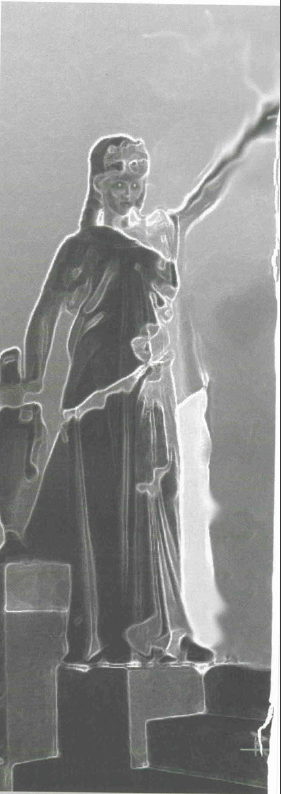
Huh
The first rule of the stratagem is that open warfare is forbidden except in refereed duels. Killing another immortal is a capital offense, punishable by exile to the dominions or death by poisoning. The Magdalen stepped forward and informed the other prides what they’d learned from their misadventures with the Apocrypha: The Sanguinary had imprinted itself on the Morpheum, the realm of human dreams. They also swore to destroy the Apocrypha in exchange for being let back into the clubhouse. This resulted in the second big rule of the stratagem, called the Silence. Simply put: don’t play serenades on Earth. Every time you do, it creates a ripple of cosmic power, and because the Sanguinary is sleeping in the human collective unconscious, it gets a little bit closer to reawakening. So seriously, don’t flaunt your magic powers in the mortal realm.
An immortal named Solitaire built a city, Atlantis, as a haven for immortals of all prides, and an era of peace began. The immortals knew that the Sanguinary would eventually arise to face them in open conflict again, and they determined that they could only present a united front if one pride took the leadership position. The squabbles over who was most qualified left them vulnerable to an attack from the Apocrypha. In 4735 BC, the Apocrypha attacked Atlantis and assassinated Solitaire, using their powers to possess immortals and force them to fight each other.
A group of powerful immortals calling themselves the “Jury” collected the survivors and led them to refuges in the North and South American continents, and took all political power from themselves. Instead of becoming tyrants, they put a proposal before the prides: the most cunning pride should be the one to lead the others when the Sanguinary returns. Every pride has a visage , a reputation to protect. Prides should resolve their conflicts with one another through counting coup , that is, political maneuvering to earn respect for yourself and discredit your opponents. The pride with the greatest visage would be the “Scepter” pride, first in line to lead the other prides if and when the “rapture”--the return of the Sanguinary--comes to pass. (It’s a very odd system, like if the political party with the most delegates gets to run the army if the country’s attacked.) The prides agreed, on the provision that the Jury would only act as impartial accountants of visage and counting coup. No one was surprised that this suited the Jury just fine, but they were astonished when the Jury took their sworn disinterest so seriously that they made their home in the Dominions. A fringe group of radicals refused to be bound by the rules of the stratagem, and called themselves solitaires, after the architect of Atlantis they revered.
So, we have everything we need for a 90s mythic-monsters-among-us game: A tangled history, superpowers, a political system based on high school rivalry refereed by an untouchable clique, and a looming apocalypse that might or might not happen.
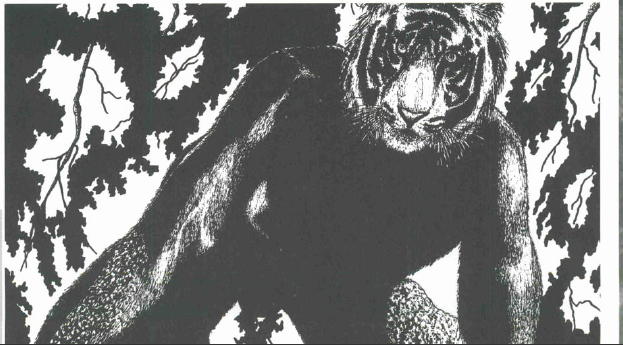
What
“Perpetual Society” is the term that evolved to encompass the culture of immortals participating in the stratagem. Although the Dominions are no-man’s-lands, immortals still have mantles--pocket dimensions which can be accessed through secret doors, Narnia-style. Mantles are large enough that immortals can recreate and relive an approximation of the Roman Empire, Renaissance Italy, et cetera--and that’s what most immortals do. The “quiet cultures” are mortal cults who live in these societies. Only immortals who go out of their way to have contact with humans outside the mantles, or who have entered lethe, can really understand modern society.
Originally, the purpose of the stratagem was just to prevent war. However, the conventions of visage and counting coup have made the prides cunning and adept. The conventional wisdom is that the Sanguinary is perversely insidious, so the prides have to learn to match its cunning. Since revealing your opponents’ weaknesses is how you score points, the prides actually help each other by calling attention to one another’s vulnerabilities, and immortals evolved a society in which it’s anathema to take personal offense at being outwitted and discredited. There used to be more prides than there are now--the stratagem has already revealed four who were consorting with the Sanguinary, and they were destroyed.
Visage is both individual and group-based. Each immortal has their own visage, and pride visage is measured by the number of high-visage members they have. Visage isn’t just a matter of having a stock ticker that says you’re important, it manifests in your halo as an aura of grandeur that other immortals can feel. Actually attacking someone with much higher visage may be impossible, because the attacker would be paralyzed by fear.
Awe of the Jury is universal within the stratagem. They’ve remained true to their oath not to interfere in politics except in their role as arbiters. They never step in to make decrees or enforce them, but the fact that they actually live in the dominions gives you a clue to how powerful they are. There are always rumours that they have agents of their own controlling the prides, or that they’ve attained some sort of transcendent enlightenment, or that they know more about the Sanguinary than everyone else. They’re not telling.

Okay.
Outside the Stratagem: Fuck you, Dad
There are some significant factions of immortals who don’t consider themselves part of the Perpetual Society. First is the Outlanders , solitaires who are similar to the Jury in their aloofness and power level. They’re feared because they ignore political considerations to pursue their own agendas. It’s widely suspected that they help solitaires survive, creating a subtle conflict between them and the Jury.
Next are Primals , another group of very old and powerful immortals. Their himsatis aren’t animals, but things like water, stone, wind, and fire. They’re largely unknown because the retreated from immortal society a very long time ago when immortals were still the dominant lifeform on Earth. They only appear very rarely, and usually because something pissed them off enough to incite violence.
For some NPCs you can actually interact with, there’s D’arcade . It’s an immortal black market that deals in priceless magical artifacts. They’re split between the Rogues, who are freelance treasure hunters, and Literati, who do the fencing and organizing and meddle in mortal organized crime. The prides tolerate their existence because frankly, they want their cool shit.
As for all those solitaires wandering about, it’s not so bad. Most are more interested in self-discovery than citizenship in a pride and everything that comes with that. They’re generally free to wander Earth unmolested, because immortals are reluctant to disturb the Silence. (In the opening fiction, Camille is a solitaire who got hunted down because she was being dumb and so goddamn crazy.) However, since serenades don’t draw heat from the Sanguinary when you’re in a mantle, it’s a bad idea for them to wander into the prides’ turf.
Finally, you’ve got the Silhouette droves to deal with. It’s been explained already that the Sanguinary can possess mundane animals, and immortals often avoid areas with lots of animals for this reason. Droves are much worse: they’re immortals that have been completely taken over by the Sanguinary. They worship the Silhouette, the Sanguinary’s current avatar, and it’s their immaculum that keeps it alive. There’s a standing kill-order on all droves. Violate the Silence all you want, as long as you kill the motherfuckers.
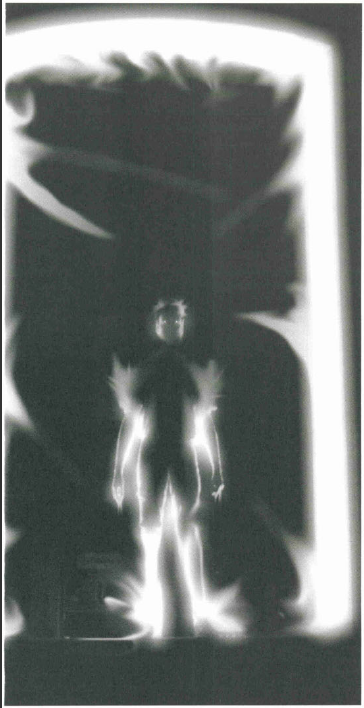
Oh hi
And now for the bit players: Manes are crazed, feral immortals still wandering the dominions and destroying everything in their path, another reason you don’t want to be banished there. Trysts are very important: they’re the child of an immortal and a mortal. They have powers which are a blend of religarum and immortal serenades; namely, they maintain mantles by dreaming their reality into existence. They have an unnaturally long lifespan, and when they die, another tryst has to take over their position to keep the mantle going. Trysts inspired mortal legends of people like the Greek demigods and the Hebrew Nephilim. Scions are the product of an immortal ritual which rids you of your Taint by splitting it off into an actual, sentient being, albeit a short-lived child that never grows up. Since creating a miserable homunculus to be a repository of your psychic agony is really fucked up, it’s forbidden, and the only other crime that buys you a one-way ticket to the dominions.
This Mortal Coil
The Apocrypha, as you know, are a mortal secret society that wants to control and eliminate immortals. They’re also known as the Illuminati. Maybe they’re aligned with the droves and the Sanguinary, but the Magdalen believe they hate all immortals too much for that to ever happen. To counterbalance them, immortals have the Quiet Cultures, groups of mortals who serve and worship them, and are of course immune to religarum. Some of them hope to be awarded immortality. The very first quiet culture, the Benendanti, have all been granted immortality and would like to achieve enough status to be considered a full-fledged pride.
Various government agencies around the world know snippets of the truth around the world. Sometimes they even succeed in capturing immortals or immortal artifacts they can’t reverse-engineer or understand.
Okay, that’s enough. Next time around, I’ll go over the
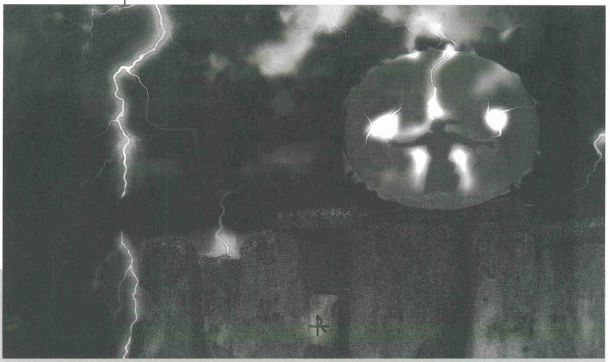
Hold my beer and watch this.
Bloodshields : An immortal magic weapon consisting of diamonds that orbit your halo and attack anything violating your personal space like a speeding bullet. Like D&D ioun stones, or a powerup in a shooter vidjagame.
Blue Air : Defined here, again , the realm where gossamers go when an immortal’s slain. Here it says that they’re what’s left of the Sunedrion, and that the Blue Air intrudes into Earth in “haunted” places called Shallows.
Blue Air : Yes! It was defined in a footnote three pages ago, and it’s here again in a sidebar! Did they read this fucking thing before they published it? Here it mentions that where the Blue Air meets with Earth, gossamers can try to gather immaculum and reenter the mortal realm. See, when this book defines something three different times in three different places, it never puts all the relevant information in one place.
Bhogavati : An Anopheles mantle, taking the form of a lost city in the Himalayas.
Cadra Raga : The four leaders of Pride Anopheles.
Cadre : A group of immortals who entered lethe together for a common goal; they usually find each other when they reemerge.
Caliburn : An immortal of Pride Peri, he allowed himself to be wielded as a sword by King Arthur.
Calling : The occupations within the prides: Emissary, Scourge, Keeper, Highbinder, Juggler, Sleeper, Slayer, Probe. Most of these aren’t defined yet.
Children’s Crusade : The historical event. Mentioned because Pride Peri saved many of the children and made them immortal, to replenish their numbers.
Club Eternity : A franchise of dance clubs owned by immortals and used as safe havens and access points for mantles.
Next time, on Immortal : Pride day!

Prides and Prejudice
Original SA post
Immortal: The Invisible War, Part 7: Prides and Prejudice
Before the Shouting War, the prides were very loosely organized bodies, and didn’t become official organizations until the stratagem was formed. The highest-visage members of each pride organized the others under the political power they were gaining, and lesser prides dissolved into larger ones. The prides are supposed to now be factions based on philosophical outlook, but that being said, they seem to still be divided up based on the immortals’ himsati type (bird, lizard, rosebush, rock, shadow, cloud). There are twelve of them.
WARNING: The following art all looks like it was originally airbrushed on the side of a van owned by someone who puts Manowar and Whitesnake on the same mixtape. Yes, tape.
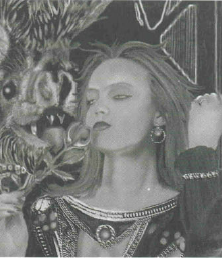
Anopheles (The Hungry Ones)
The Anopheles are one of the oldest prides, whose culture is most strongly defined by their slavery to the Abzulim. They have a “deep lust for all sensual things” and prefer to count coup through seduction and manipulating their opponents’ desires. So they’re backstabbing sluts, basically, and they play the part by wearing outrageous clothing, fetish gear, or nothing. They know more about the Abzulim than the other prides, and it’s rumoured they may even have surviving specimens imprisoned somewhere. Historically, the Anopheles are known for two things: First, they nearly killed the Sanguinary for good when they destroyed the Malice Shard, a big ol’ chunk of conundrum containing a big part of its consciousness, but that caused the destruction of the Sunedrion and created the rift between Earth and the dominions. Second, they summoned a group of three entities from the Crucible called the Trine, who are believed to be the ones who gave the Sanguinary the boot in the first place.
Most Anopheles have reptile himsatis, although the oldest Anopheles are actually black leopards.
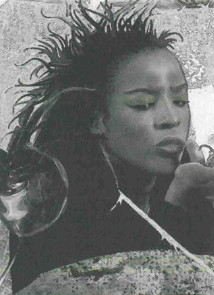
Arachne (The Trap Weavers)
The Arachne have himsatis of predatory insects, and they like to play the part. The Abzulim created them to build their cities, and the Arachne have a reputation as not only the greatest architects in history, but excellent archaeologists, strategists, assassins, and interrogators. They’re taciturn, humorless, and have a philosophical dedication to eschewing emotion in favour of cold logic. In fact, one pays an Arachne assassin by permanently giving up an emotion, and it’s believed that the Arachne are saving these up to use as some kind of superweapon in the final battle against the Sanguinary. (They won’t make you fearless. Nice try.)

Banjax (The Destroyers)
Meet the
Since they originated as an ad hoc group, their members have himsati of all types. So that’s the Banjax, your military coup/prison gang/freedom fighter/outlaw biker pride. I think that’s pretty cool.
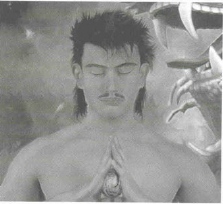
Dracul (The Dragon Speakers)
The Dracul are the most spiritual pride. They organized in the “Far East,” as devotees of Sharakai, one of the Trine summoned from the Crucible. Although Sharakai was slain in 632 AD, they’re still dedicated to his message, whatever that was.
Like all Orientalist factions in roleplaying games, the Dracul are focused on duty, hierarchy, and philosophy. Since the Sanguinary is trapped in mortal dreams, they believe the way to beat the Sanguinary is to deplete its resources by educating mortals so that the Sanguinary can’t influence them. They conduct a lot of scientific research on dreams. When it comes to inter-pride politics, they prefer to act as a spoiler by using ninja agents to keep the balance of power from tipping one way or another.
The Dracul are led by the Ki-rin, sacred special snowflakes who “speak” by producing jade tablets from their mouths. On Earth, they blend into mortal society, but in their mantles, they dress in “the full regalia of an Oriental warrior.” Generals from the Warring States and the Tokugawa shogunate dressed pretty much the same, I guess. Nothing is said about their himsati forms.
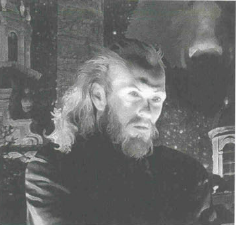
Eremites (The Crusaders)
The origin of the Eremites is unclear, but it is known that they were bred as a warrior race. They’re the children of Anath, a minor historical figure I had to go back through many pages to remember. So a human named Anath was granted immortality, and then someone convinced him to do the nasty with the Rukshasa, another one of the Trine, thus producing the Eremites. Their himsatis are all human, and they think this elevates them above the other prides, although in immortal terms being higher on the evolutionary chain means you’re millions of years younger than your peers.
Aside from being douchebags, the Eremites believe that Earth belongs to humanity and immortals have no business meddling with Earth at all. Sometimes they use this principle as an excuse for political maneuvers. Other prides consider them competent and courageous, but are constantly suspicious of them for frequently fucking them over and claiming they were Just Playing Their Alignment.
Eremites like to “shepherd” humanity, appearing as angels and shit like that. In their mantles they live a monastic lifestyle, wearing monochrome robes denoting their rank. They have a lot of collected plunder from over the years, particularly WWII, in which they played a significant role. Since they’re powerful ancient immortals, they must not have done a very good job.
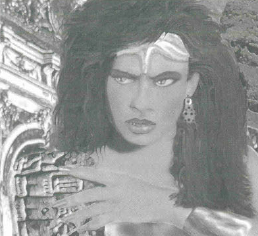
Magdalen (The Pedagogues)
Like the Eremites, the Magdalen trace their origins to Anath. They’re your realpolitik “knowledge is power” faction, and they were responsible for the heights of Greek and Roman civilization and the ascendancy of the Holy Roman Catholic Church. They’re also responsible for the Apocrypha and manipulating many immortals to enter lethe after the Great London Fire.
They have a massive library supposed to contain a copy of every manuscript ever written, and they believe that they can figure out the Sanguinary by studying literature and art in order to understand how it influences humankind. Their appearance, and the culture of their mantles, reflects a revival of ancient Greece and Rome.
Because they were responsible for the Apocrypha, the Nimrod placed a curse on them: they can’t take immaculum from willing mortals, forcing them to steal it and thus incur “taboos,” those still-not-really-explained curses that immortals get from stealing immaculum.
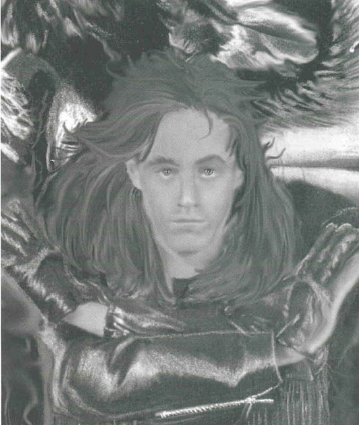
Morrigan (The Storm Masters)
Morrigan is the current Scepter pride; their himsatis are birds and other flying creatures, and their headquarters mantle is a kickass floating city. They’re proud to be at the top of the heap of the stratagem, and all their efforts are focused on preparing the other prides to face the Sanguinary.
The Morrigan’s defining historical period was the Dark Ages when they united the Celtic tribes to throw off the yoke of the Romans. King Arthur was a mortal pawn of theirs, and they believe he will return to life from the Crucible as a savior and a sign of the end times. (There’s a rogue faction, led by Morgan le Fey, who believes Arthur is a sort of Antichrist.) They’re known for being haughty and imperious, and their membership includes many immortals identified as sky gods: Odin, Thor, Zeus, Tlaloc, etc.
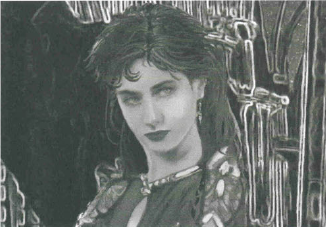
Nimrod (The Hunters)
Nimrod are descended from someone called the Horned Lord. Their defining moment was when they discovered the Darkle, an incredibly powerful artifact that actually transformed their himsatis of light into shadow. They used the Darkle to put an end to the Shouting War by imprisoning the other prides in a dominion called Sheol. When the prides escaped, not only were they pissed, but it was discovered that the Sanguinary’s mind was lurking in the Darkle. The Nimrod only survived by pulling a coup d’etat in which the Horned Lord and all the other male members of the pride were assassinated by poison and blamed for all the pride’s fuckups.
The Nimrod are the greatest advocate of the Silence, since it’s their job to enforce it. They figure that if no one violates the Silence, the Sanguinary will never wake up. They deliberately estrange themselves from humanity, wearing mismatched clothing under weird barbed-wire armor, and they know a neat party trick where they unleash their shadow himsatis from their bodies to use as bloodhounds.
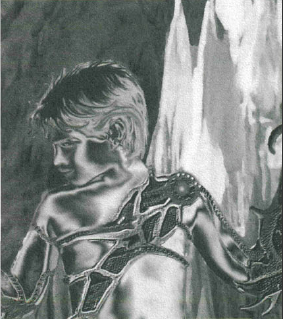
Peri (The Children of War)
The Primals created the Peri as magical weapons. They escaped into the unexplainably-capitalized-and-italicized Underworld for a long time, and emerged during the Shouting War to become mercenaries. They had little loyalty to one another, so their death toll was high, and got even higher when they were trapped in Sheol without any allies. They joined up with the Banjax to aid their rebellion, and spent a long time trying to regrow their membership. The Children’s Crusade of 1212 was a pivotal event for them; they recruited many of the “casualties” into their pride, so most of them have himsatis of young humans. They rarely do mercenary work now, but will “bond” with those who impress them; Caliburn, Gungnir, and Mjolnir are examples of such Peri.
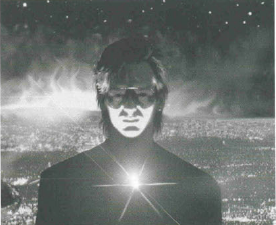
Phoenix (The Torch Bearers)
The Phoenix have an interesting origin story: When the Nimrod pulled a coup on their leader, the Horned Lord, he survived his poisoning and found some Sunedrion sap to heal himself. Stealing immaculum from mortals at an astounding rate, he shed the taboos by creating scions, and the scions were somehow created as full-fledged immortals. They’re associated with the city of Troy and the order of the Knights Templar.
Phoenix are known as healers; they’re able to sense and find Sunedrion amber. Phoenix only “reproduce” through personalities splintering off when one of them enters Lethe. Secretly, they’re all aspects of the Horned Lord, and have himsatis of fire.

Tautha (The Guardians)
The Tautha first formed right after the fall of the Abzulim empire. They discovered that Sheol was the place where the Sanguinary entered the world, and started collecting and combining conundrum shards--it doesn’t say why, but I think it was out of curiosity. The result was the Malice Shard, a huge chunk of conundrum that the Sanguinary almost used to reincarnate itself. Feeling guilty about the resulting fallout, they wandered in the wilderness, figuratively and literally, for a long time. They warred among themselves, until they found a place in the Amazon basin which contained some remnants of the Sunedrion, allowed them to attain some spiritual peace.
The Tautha have primitive mammalian himsatis. Exactly what the Tautha stand for and what they do is not really explained. They hope one day to rejoin with the Sunedrion and the Crucible itself, to obtain a more true form of immortality.

Terat (The Unfettered)
Terat are individualists who didn’t take part in Perpetual Society until Solitaire founded Atlantis. Revering Solitaire’s teachings, they’re tolerant of immortals and mortals alike, but their most stunning unique quality is that they choose to live permanently in himsati form, resisting the control of the Sanguinary and avoiding using human form as a mask. They believe the only way to defeat the Sanguinary is to embrace the himsati form and break the Sanguinary’s hold on it.
Within the prides, immortals have dynasties--immortals with familial ties who act as a check on the paragon, or leader of the pride. Dynasties keep their numbers strong by splintering off avatars. Prides also divide their members into callings, which are basically official jobs. Callings are older than the stratagem; they began in Sheol, where you had to prove your usefulness to a powerful benefactor. Immortals in a Calling work for the benefit of their pride, but they have a responsibility to discharge their duties for the benefit of all immortals. Immortals who belong to a pride, but have no Calling, are called rooks, and they serve their pride in mundane ways (or not) without gaining visage or being targeted by those hoping to do so.
Each pride has Convictions, which is essentially a 13-point political platform on 13 matters important to immortals. To be a member of a pride, as with a political party, you have to more-or-less toe the line regarding that pride’s stance on the 13 issues. These are the Sanguinary, the Silence, the Habitat (Earth), the Dominions, the Crucible, the Morpheum, the Stratagem, the Profane (immortal creatures outside the Stratagem), the Ingenue, the Conundrum, Sinning (stealing immaculum from mortals), and Himsati.
Club Eternity : A franchise of dance clubs operated by immortals. They’re used as safehouses and access points to mantles. Sounds like a great plan!
Halos : The auras of all living beings, perceptible to immortals in six different colours corresponding to their six characteristics.
Colostrum : The milk of the Rukshasa, which the Anopheles have chained up in a basement somewhere. It cures Taint, but it’s addictive.
Come-on : Slang for convincing a mortal to give you immaculum.
Conundrum : Remember conundrum? It’s back! In sidebar form. Conundrum are shards of the Sanguinary’s shattered body. We now learn that an individual shard might be a part of its heart, brain, eyes, and so on. They’re called conundrum because they have a hypnotic effect on immortals due to “twisting passages of knowledge” within them. Like palantir, I guess. Unmerged shards are very powerful, though we aren’t told what they can do. As an example, brain-shards are called “whisperballs” and convey telepathy to everyone standing near them. Okay.
Conundrum : And in a fucking footnote! Here it says that conundrum are “mineral-like,” that you need one in order for a tryst to create a mantle, that they can alter space and time, and that they’re all called Whisperballs, which sounds like a pointless gadget you buy from the Sharper Image catalogue.
Convictions : Thirteen tenets held by each pride. These are the “How we feel about …” stereotypes that White Wolf games put in sidebars, only enshrined as some kind of political thing that officially exists.
Hush-hush : The part of the Morpheum, the mortal dreamstate, where the Sanguinary dwells.
Coup : Publicly embarrassing another pride to gain visage for yourself and your pride.
Crackerjack : Immortal slang for “thing that’s easy to do.”
Creche : A pride’s capitol, usually a mantle or fortress.
The Crone : A manifestation of the Sanguinary that doesn’t actually exist yet, but is supposed to herald the rapture, or final battle.
Invisible War : Started in 1990, the secret war supposed to presage the rapture. It began when someone (probably droves) stole the Femme Darkle.
Avatar : Haven’t we already covered this? The multiple personalities that result from an immortal entering lethe to repress their memories and live as a mortal. Here we’re informed that immortals can bear their avatars as children--I guess these are trysts, but it doesn’t say.
The Crossing : Also already covered. When your halo has too much Taint, you get sucked into the dominions. If you can get some immaculum, you’ll get sucked back.
The Crucible : The cosmic vortex that is the source of all creation.
The Culture : Another name for a quiet culture.
D’arcade : The immortal black market. They control a city called Nivalea, which they can access from anywhere using fragments of the Malice Shard called hailstones.
Next time, on Immortal : The actual, for real, character creation rules.
Fuck you, I’m a dragon
Original SA post
Immortal: The Invisible War, Part 8: Fuck you, I’m a dragon
“Imagine this,” opens Immortal’s chapter on character creation. You think you’re a normal person like everybody else, while your fellow immortals manipulate humanity like pieces on a chessboard from the safety of their creches. “The persona you role-play in the immortal experience is an imaginative representation of yourself.” But when designing your
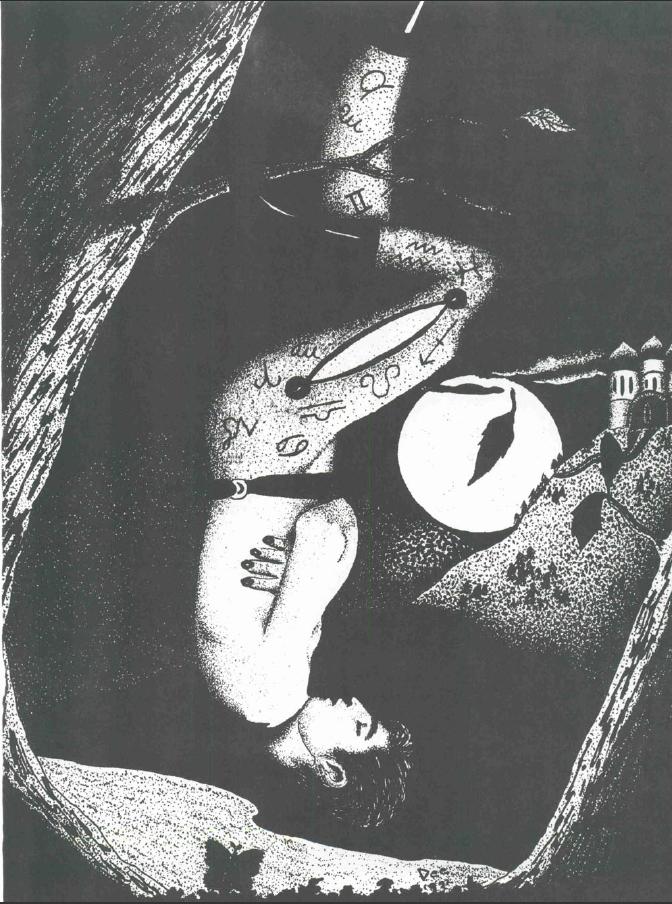
Bruce Wayne went through a Rocky Horror phase.
A recap on characteristics, as the book provides: You have six of them, which in setting terms are created by having motes of immaculum in that part of your halo. The permanent points you have in a characteristic are called forte. You also have free-floating immaculum that you can shift around to boost your characteristics as-needed.
Characteristics
You start with 15 motes to distribute between the six characteristics. The characteristics aren’t defined in detail again, but each one gets a brief table to explain what having 6 points of Blue Halo means. Generally speaking, a score of 0 means crippled, 2 is the human average, 5 is the human maximum, and 15 is not only the immortal max, but implied “Eidos,” a sort of transcendence where your human and himsati forms are reaching a state of harmony.
Red Halo (Resolve) : Remember that red combines intelligence and willpower. Resolve 0 is “educably mentally retarded...no self control.” Resolve 5 would be Albert Einstein with iron will. At Resolve 9, humans hardly seem sentient in comparison to you, and to anyone with Resolve 15, mortals seem like insects. I totally want these guys protecting me from an ancient evil which owns real estate in their brains.
Orange Halo (Force) : This one takes the form of a boring chart of how much weight you can lift, measured in proportion to your own weight, so a big fat immortal with Force 15 is much stronger than a scrawny immortal with the same superhuman strength. Human average (2) means you can lift half your weight over your head; I have no idea if that’s accurate to statistical averages. Force 5 is twice your weight, which I believe is not too far off from heavyweight Olympic records. Force 15 is 100 times your weight. It’s rather odd that a Resolve 15 immortal is a demigod with a mind beyond mortal comprehension, whereas a Force 15 immortal is just a guy who can lift 10 tons.
Yellow Halo (Expertise) : Remember, this means agility and coordination. The definitions are very vague. Zero is “completely uncoordinated,” five is a world-class athlete. Expertise 12 at least tells us that an immortal at that level can walk on a thread, on water, or up vertical walls, while Expertise 15 means “gravity presents no hindrance whatsoever.” That sounds more like levitation than superhuman agility.
Green Halo (Movement) : I don’t know why this is a separate characteristic. Someone with Movement 0 can only feebly crawl about, an average human can run at 10mph, and a Movement 15 immortal can run at 300mph.
Blue Halo (Awareness) : This is more interesting. At Awareness 0 or 1, the mortal is legally blind or near-sighted and has the senses of someone old and decrepit. Awareness 5 conveys great night sight, the ability to identify people by scent, and the chance to perceive halo intensity on a lucky roll. Superhuman awareness starts conveying the ability to do things like hear heartbeats, track like a bloodhound, see as if through a telescope, and at 15, crazy Superman shit like seeing things at the subatomic level or various spectra of electromagnetic radiation, and the power to see into the Crucible itself .
Violet Halo (Resilience) : Someone with Resilience 0 is basically a critically ill person on their deathbed who has no immune system left. Resilience 5 confers the endurance of a marathon champion, toughness of a boxing champion, and resistance to harsh conditions and deprivation of a yoga master. Resilience 15 makes you literally diamond-hard, able to survive in absolute zero, the heat of a volcano, or the deepest ocean, and with no eat to eat or breathe.
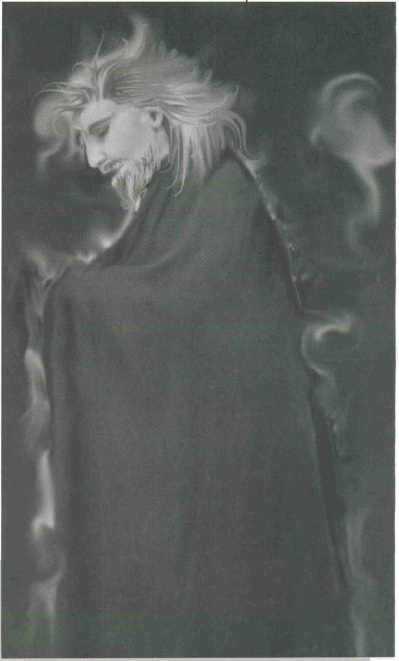
In another life, Goat Boy was Gandalf.
After a brief afterthought about using props to remind you about your equipment, we go into “Awakening the Persona,” which is a method of character creation in which you start playing without knowing the rules, and the Narrator secretly makes your character for you and is also probably a huge asshole about it.
Immortal seriously suggests that you just start the first session of the campaign without your players knowing the rules or even what the game is about, really. When a
After your players beat the shit out of you, Immortal recommends an alternative, but equally roundabout and downright stupid way to allocate their points. It lists some personality traits, challenges them to pick the ones they find most resonant, and says which characteristic matches it. Did you know that analysts and jokesters are well-coordinated, rebels are strong, gourmands are tough, and negative people are perceptive?
Or you could just tell them what the different characteristics are and tell them to put more points in the ones they want to be good at. Crazy, right?
Now a discussion of himsati. Because this is Immortal, this part can’t just be a list of himsati forms for you to pick from. We have to present a whole bunch of new setting information about this concept that was left out of earlier chapters. Going into himsati is relatively safe for a weak immortal, because the Sanguinary is loath to waste its energy trying to take control of an insignificant minion. Mortals only occasionally see himsati, the exception being mortal creatures that match your himsati form--wolves can see a wolf immortal, etc. They’ll react positively or negatively depending on how much Taint you have.
Himsati form is an advantage because all your immaculum becomes free, so you can switch around the points of your characteristics as you please. The drawback is that all serenade rolls are -5 due to the himsati’s bestial mind. Oh, and the himsati is vulnerable to being temporarily controlled by the Sanguinary--whenever that might happen, you have a himsati hostile to check against. The weaker an immortal you are, the harder it is to keep control. (Yes, this is the exact opposite of what I just said.)
There’s a scale called the Himsati Tier, which measures an immortal’s personal evolution. Yes, it’s a lot like Generation in Vampire, except you can improve it with
Next you determine your
Pride affiliation is the next topic--even solitaires belonged to a pride at some point. Prides will seek out their own, and try to manipulate ingenue of other prides when they find them.
Cadres are also mentioned. Cadres by seasoned immortals are usually superficial, but the cadres of those emerging from lethe usually involve genuine lifelong friendship. Again, none of this rules-free, choice-free bullshit really belongs in a character creation chapter, especially when it’s already been covered.
Callings
The individual Callings, the jobs that prides assign to their members, are finally covered in detail. What it doesn’t explain is how ingenue, who just emerged from lethe, are assumed to be integrated into their parent pride and have been given a position of responsibility. Oh, well. Immortals assuming a Calling begin on the lowest rank of their profession, the red tier. Yes, Callings have ranks called “tiers” which are color-coded. What? That’s confusing because those same concepts are used for characteristics but in different ways? Fuck you, buddy.
Anyway, an immortal’s approach to his responsibilities is probably very influenced by his pride--for example, an Anopheles Sleeper will foster erotic dreams, while a Dracul one will create peaceful ones. Although immortals in Callings counting coup on one another is the basis of the Stratagem, they have a sense of professional responsibility--if a Morrigan Scourge is hatching a scheme against the Tautha, he won’t manipulate a Tautha Scourge to do it. The Callings can’t do their jobs if they’re afraid to share information.

You are floating in calm, blue water. You can hear nothing but the sound of the waves and your big sister's Ani DiFranco albums.
The construct that the Sanguinary created in the dreamstate of mortals--the Morpheum--is like a computer, and Sleepers are viruses in the computer. Their goal is travel through the dreamworld, manipulating mortals who are especially powerful dreamers to use against the Sanguinary, and to use dreams to find immortals who are still in lethe so that they can be awakened. They tend to be lackadaisical about the “real” world since they’re used to a world that’s constantly changing. They’re also at the greatest risk of being corrupted by the Sanguinary. They’re divided into two types: Nightmares, who wage war in the dream realm and even go Freddy Krueger on problematic mortals, and Reveries, who promote peace and enlightenment through dreams.
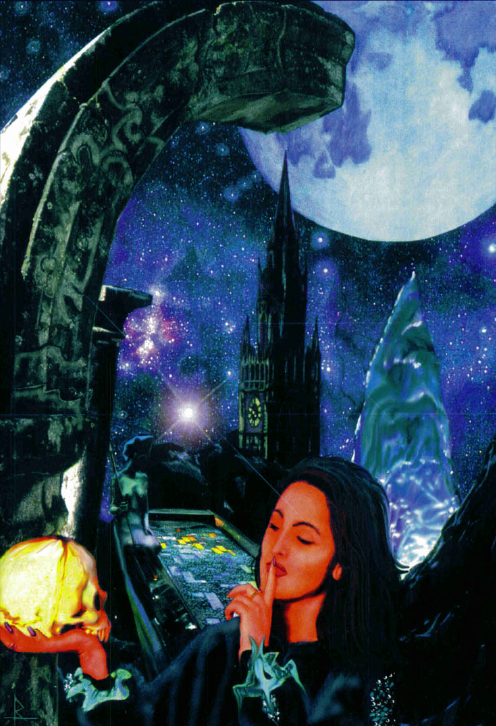
Shut up, Yorick.
Emissaries are the prides’ messengers. They train themselves to the point of having photographic memory and the ability to repeat a message exactly as it was passed to them, including minor details like tonal inflections, and to memorize complex images and describe them in precise detail. They also courier valuable objects. Because the news they deliver can determine very important decisions, they’re constantly monitored for any hint of falsehood. They’re also the source of rumours which are carefully seeded to advance their pride’s cause.
I know this game was released before 1995, but here you have a profession of messengers who are almost as good as sending a video or an email, and are perfectly reliable except when they’re not. I’m at a loss to explain why they’re necessary.

]Are you hunting down the asshole who did your hair, or the asshole who did your tattoo?
Highbinders are bounty hunters. They’re sent out to find ingenue who have forgotten their identity, track down valuable artifacts, rescue kidnapped immortals or take defectors to another pride into custody. “By tradition,” in the case of defection, they declare their targets, and others don’t interfere with the hunt, preferring to see the highbinder lose visage for his pride by failing.

I can hear the New Kids on the Block in this seashell I found.
Jugglers are responsible for keeping the Perpetual Society secret from mortals. They involve themselves with human civilization in order to manipulate media, police, and other investigative agencies, both to keep mortals in the dark and to confuse the Sanguinary and its minions. Although immortals don’t fear being confronted by humanity directly, they’re afraid of what could manifest through the Morpheum if humankind became aware of immortals. They get called in by other immortals whenever a scheme to count coup requires manipulating media, law enforcement, or the government.
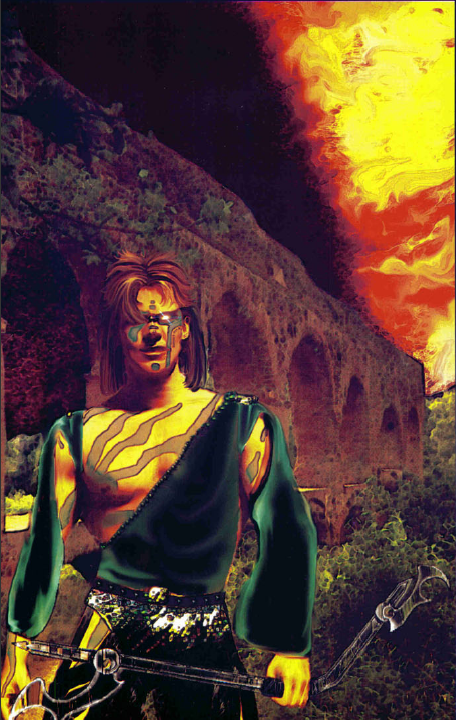
I can't believe I'm the only one cosplaying Kefka this year.
Slayers are the only immortals allowed to kill other immortals. They’re still required to abide by the Silence, so they avoid the use of serenades and try to deliver a quick, clean death. They’re feared, but not as much as the Jugglers.
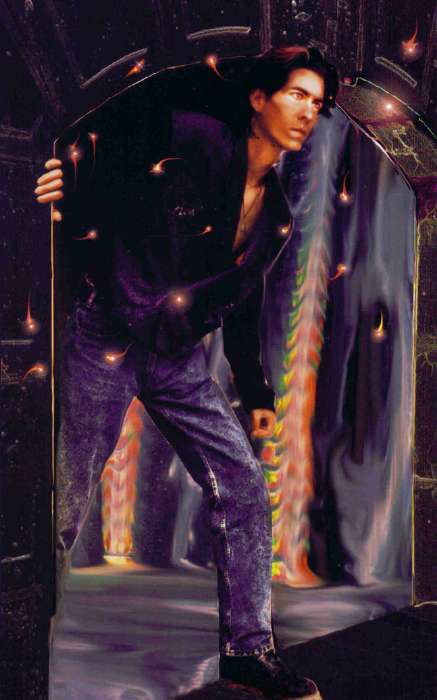
By my vow, no harm shall come to these dad jeans.
Keepers are bodyguards. Their profession originated in Sheol, before the stratagem was founded, when sources of immaculum were so rare that it was unthinkable to let anyone despoil them. Today, Keepers guard precious objects, the paragons of the prides, or anyone or anything else important enough to have a full-time immortal bodyguard. They never sleep, are almost unfailingly loyal, and are usually good enough at their job that if you want to get to whatever they’re guarding, getting past them is the most critical part of the plan.
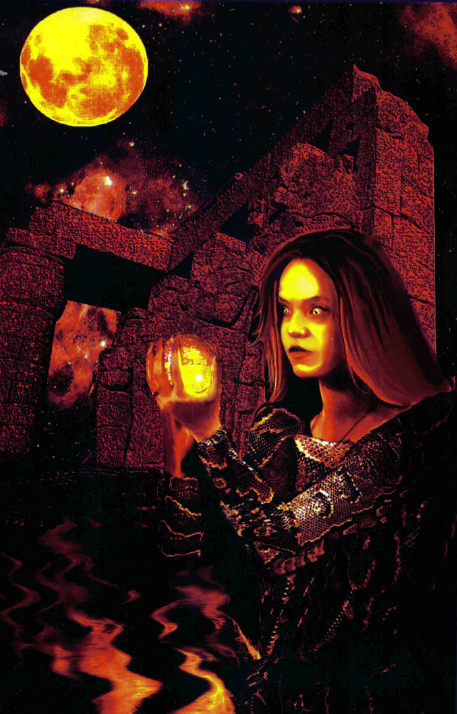
Fire. It's definitely fire.
Probes are spies and investigators. Espionage, forging, computer hacking, and detective work are all part of their repertoire. They’re relied upon to determine guilt or innocence when an immortal’s actions are questioned, and follow up on rumours to determine if a juggler needs to take care of a political problem.

You don't wanna mess with these.
Scourges are in charge of arbitration, judgment, and punishment when an immortal breaks the rules--most commonly the rule against violence. The Scourge records the plaintiff’s demand for justice, negotiates that punishment, and then ensures that it’s carried out to the plaintiff’s satisfaction. They also serve as witnesses against enemies who commit a crime against their own pride. Basically, it’s their job to make sure the Jury doesn’t have to step in and adjudicate every little grievance just to prevent open warfare.
Immaculum : A life-force energy that flows from the Crucible. Because immortals can perceive it, they can lower their resistance to it and become better conduits of it, which maintains their immortality. Immaculum is even present in light, which is why immortals can perceive different types of lifeforce as colour. Tainted immaculum can’t be used, physically weakening you. When a tainted immortal is wounded and bleeds, the Taint actually manifests as dark barbs of energy. Now we know what was going on with Camille in the opening fiction.
Darkle : A physical manifestation of abbadon on, let me look that up-- destructive immaculum , which was found petrified in the brain of a dead Abzulim named Samiel.
Demeter : Immortals’ reverent term for the earth. Since they already call it the Habitat, I don’t know where this comes up.
Dirge : The sound of a Peri’s halo, audible to other Peri.
Dominions : The desolate regions within the Blue Air, polluted by millennia of war between immortals. They exist as barbarous wastelands still ravaged by the Lash.
Dracul : Also known as Sharakai, one of the Trine. The Dracul pride modeled themselves on its teaching.
Pride Dracul : As described, a pride of immortals devoted to Sharakai’s teachings, whatever they were. Their goal is to maintain balance of power in the stratagem.
Spill : If an immortal is killed by violence, their immaculum spills out and is absorbed by nearby immortals, especially if it’s tainted.
Dreaming : The human subconscious where the Sanguinary lives, using mortal minds like a computer uses RAM. The Morpheum, on the other hand, is the “topography of dreaming” one can actually move through and experience.
Droves : Like a pride, but serving the Sanguinary.
Dry Spell : The time in Sheol when there was no immaculum to be had, except by killing other immortals.
The Dust : An avatar of the Sanguinary that manifested through a series of plagues. Destroyed in the Great Fire of London.
Eden : A time when the Sunedrion flourished. I doubt you’ll see another reference to this anywhere.
Elves : Trysts of Pride Tautha.
Emerge : When an avatar takes control of the body.
Emim : Another name for the manes, immortals who survived the lash but went totally insane.
Emissary : The calling of messengers.
Next time, on Immortal : What? We're not done with character creation? That wasn't really much of a character creation chapter at all? We have to go over all the prides again, this time with full-colour illustrations? I know. I know .
Let pride go afore, shame will follow after.
Original SA post
Immortal: The Invisible War, Part 9: Let pride go afore, shame will follow after.
Immortal jumps from descriptions of the callings to more detailed descriptions of the prides, in the midst of the character creation chapter. There aren’t any rules here regarding receiving pride-related perks or weaknesses, or what himsati for you ought to choose and what it does. In a convention blatantly stolen from World of Darkness games, each pride gets an illustration and a page of its own describing certain things about them. The writeups include the pride describing itself by way of a flowery “quote,” and their Convictions, a sort of party platform on what the pride thinks on a number of issues. It also lists the location of their creche (headquarters), their typical appearance, a list of their Quiet Cultures (mortal cults), typical himsati forms, three Legacies (their
For your protection, I’ll be summarizing these. I’m going to leave out the Quiet Cultures entirely because it’s a waste of text. For example, for the Anopheles, it lists “Quiet Cultures: Nagas, Ganymedes, Incubi, Lhianna, Adze, the Rephaim.” I’m almost certain you’ll never seen these mentioned except in a footnoted term, so it’s meaningless. If you’re paying attention to all the footnotes, you’d know that the Nagas are the Quiet Culture that keeps the Rukshasa chained up and milks it for its colostrum, an immortal medicine that purifies Taint, but that’s as far as it goes. I’ll leave in the Legacies, because hopefully, we’ll actually see the rules for serenades at some point!
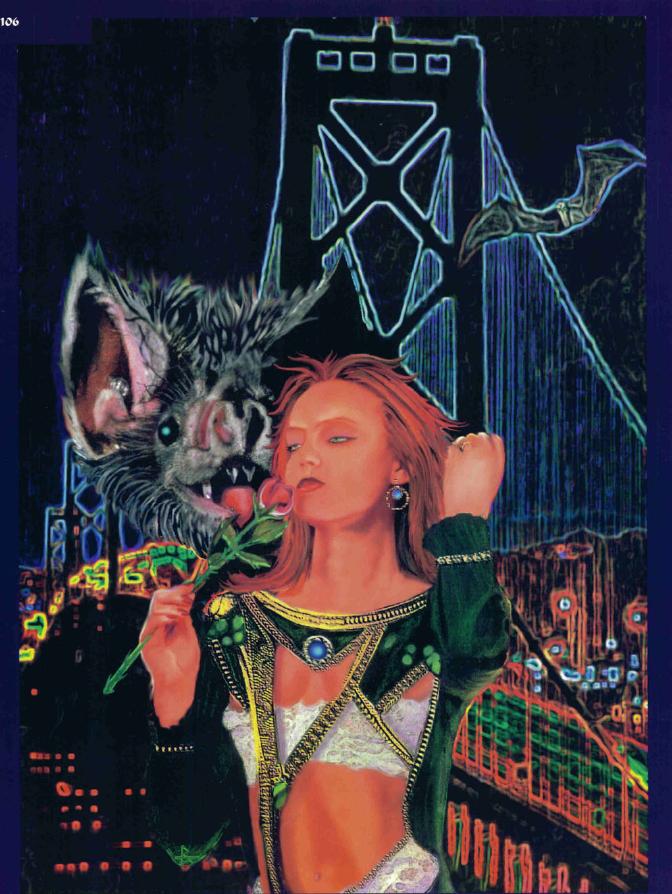
This is going to be the best Twilight fanfiction you guys
Anopheles are all about sensuality, temptation, and manipulating desire. They fancy themselves history’s greatest lovers, betrayers, and degenerates. They control others by giving them permission to do what they wanted to do anyway.
Predilections : Bohemians, hedonists, pleasure-seekers and thrill-seekers. They’re the people you think are really cool to hang out with until you’re 30.
Creche : The Karakoram mountains.
Appearance : They prefer dark, solid colours, and like to dress in fetish clothing; leather, metal, and lingerie. Red teardrop tattoos are common.
Himsatis : Leopards, cats, snakes, bats.
Legacies : Animas, Masque, Quicksilver.
Convictions
Sanguinary : The source of our existence, but too dangerous. Wouldn’t it be cool if we could control it?
Silence : Stupid and pointless, but if it keeps the others happy...
Habitat : Humans are fascinating to fuck with.
Dominions : Really dangerous, but we’d like to go back and dig up the Abzulim one day...
Crucible : Interesting, but we don’t want the spiritual realm, we want pleasures of the flesh.
Morpheum : Digging around in mortal dreams? Sign me up!
Stratagem : Our strength is built on manipulation. Peace is good for us.
Profane : Who cares?
Ingenue : They’re naive, but their experiences as mortals are precious.
Conundrum : Not such a big deal. We rely on our own skills.
Sinning : Mortals are just begging us to suck out their sweet sweet immaculum. We’re not saying no.
Himsati : It’s dangerous, but thrilling.
Humanity : Without them, we wouldn’t have an audience.
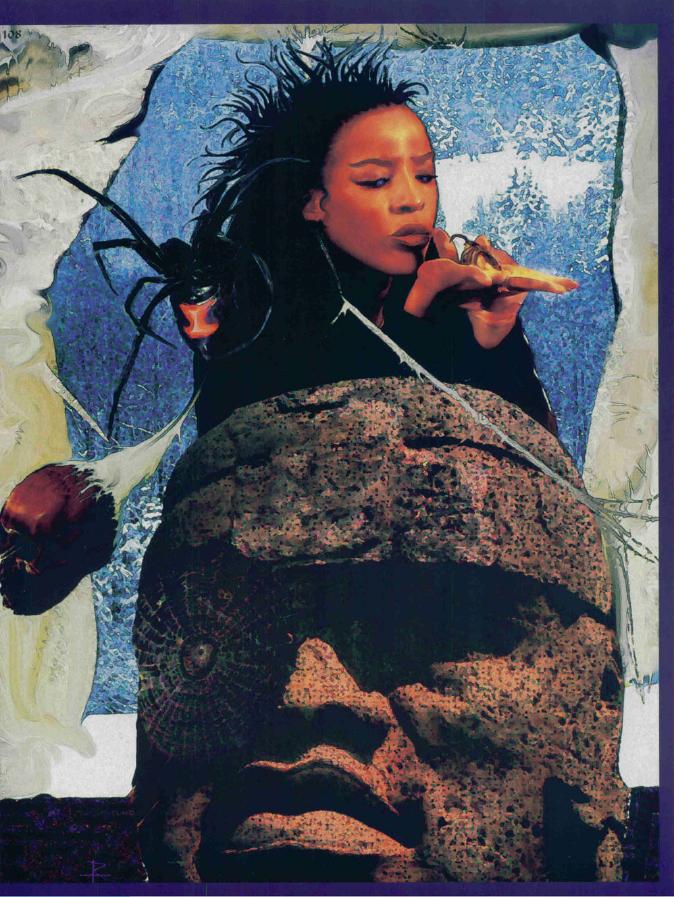
Kisses! Kisses for Mommy!
Arachne are KGB Vulcans. Emotion is weakness, logic and intrigue are strength. They literally store up their shed emotions in an artifact that they plan to use to crush the Sanguinary one day.
Predilections : Their personality range goes from “wandering ronin assassin” to “humourless middle manager.”
Creche : The Everglades. No, really.
Appearance : Usually angular featured with dark eyes. They like insect tattoos and use bracelets as an identifier. They prefer “silk clothing that blends them into a crowd,” something I’ve never seen. They wear a lot of black and grey. Of course.
Himsatis : Spiders, mantises, other insects.
Legacies : Ambidextrous, Balance of One, Momentum.
Convictions
Sanguinary : Completely alien. Destroying it will require destroying what we’ve become.
Silence : We don’t fuck with it.
Habitat : Just one piece of the puzzle.
Dominions : Maybe there are things of value there, but it’s better that we move on and try new things.
Crucible : It’s indifferent to friend and foe alike, so why investigate it?
Morpheum : A dangerous place, but we have our armies ready there.
Stratagem : It exposes weakness and builds strength at the same time, something war can’t do!
Profane : An unknown variable. We hate unknown variables.
Ingenue : Our link to humanity, and easily controlled.
Conundrum : Master these, and we can master the Sanguinary.
Sinning : The Sanguinary preys on us, we prey on mortals. Food chain. Get used to it.
Himsati : We let the animal loose when we need it to kill for us, and that’s all.
Humanity : Inventive, but self-destructive.
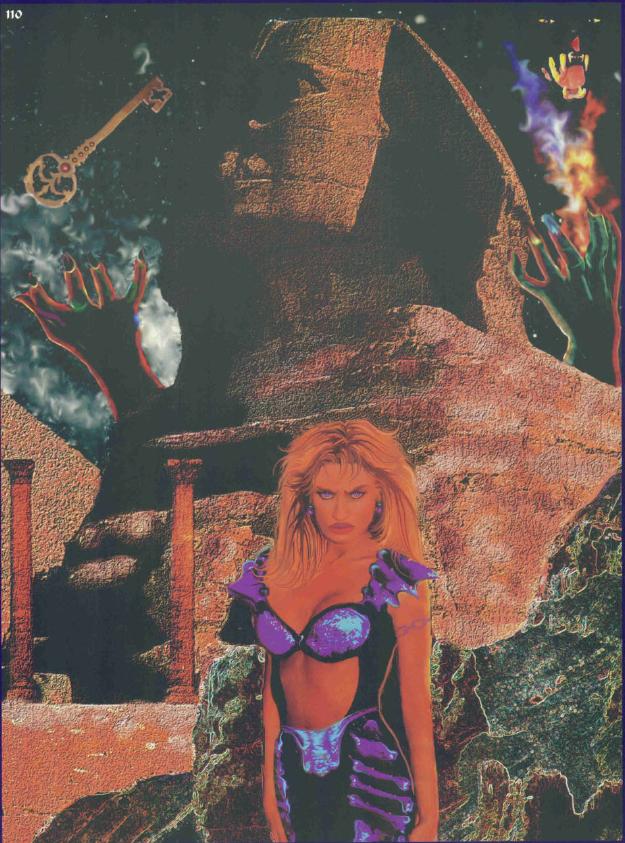
Why yes, I have had sex with every member of Poison.
Banjax have a bit of a savior complex. They consider themselves freedom fighters, soldiers, and builders of civilization.
Predilections : Kind of all over the place. Rebels, but with a strong sense of loyalty and an ethical code.
Creche : Cerro Fitz Roy, a fortress in the Andes.
Appearance : Street fashion, military wannabe gear, body mods, and Egyptian-themed jewelry. Oh, I get it! They’re goth rivetheads! I love these motherfuckers.
Himsatis : Any.
Legacies : Adrenaline, the Bonding, Lethe.
Convictions
Sanguinary : We beat it before and we’ll beat it again.
Silence : We’re cool with it. We can kick ass without using serenades.
Habitat : The tyranny and injustice of the world is a reminder of how we let the dominions get fucked up, one we can’t ignore.
Dominions : Been down a one time, been down a two time, never goin’ back again.
Crucible : Some powers weren’t meant to be fucked with.
Morpheum : Too cerebral for us. We’d rather fight in the streets than in dreams.
Stratagem : We invented it, but it’s grown beyond what we intended. It’s important to keep the peace, but we won’t allow it to become too restrictive.
Profane : It would be foolish to ignore immortals outside the stratagem. Too many prides are hatching schemes while ignoring the other powers out there.
Ingenue : They’ve received the greatest gift an immortal can receive. From us. Say thank you.
Conundrum : Oh, a little chunk of Sanguinary? Yeah, let’s mess around with that. Or not.
Sinning : We’re survivors, but we’d rather not go there.
Himsati : When all else fails, turn into a magic animal that hates everything and fuck shit up.
Humanity : They just need someone awesome, like us, to save them from the Sanguinary.
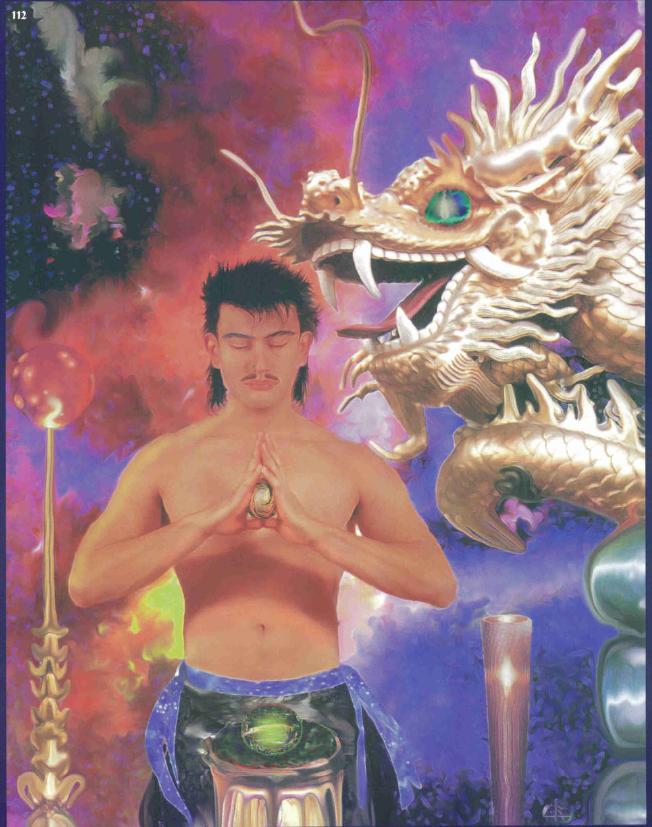
It’s actually pretty dangerous to meditate in the path of a Chinese funeral.
Dracul are all about seeking truth and inner peace. Their mentor, the dragon Sharakai, is gone, but that doesn’t deter them. They believe concentration of power is dangerous, so they act to balance competing interests.
Predilections : They’re very much “work within the system” types.
Creche : The Forbidden City, China.
Appearance : They insist on wearing good-quality clothing, often in traditional Asian costume. Among themselves, they often wear “oriental armour.” They use intricate belts to identify their pride membership.
Himsatis : Reptiles, dogs, rats, hares, tigers, horses, and birds. Ha! They seriously just look at the zodiac on a Chinese restaurant placemat.
Legacies : Aart, the Bonding, Dark Page.
Convictions
Sanguinary : Our enemy. When all are enlightened, it will be destroyed.
Silence : We should support it, but it’s actually better to misdirect the Sanguinary than to try to go completely unnoticed.
Habitat : We won’t abandon our mission to bring enlightenment to the world.
Dominions : It’s an example of what happens when we fuck up. But we broke it, so it’s our job to fix it someday.
Crucible : It holds the key to the next step in our evolution, and we hope to learn something from it. Sharakai came to us from the Crucible, after all.
Morpheum : This is where our enemy builds weapons against us. We have to destroy them.
Stratagem : A noble effort, but the system is too complex to maintain its own checks and balances. We have to step in from time to time to prevent one pride from dominating.
Profane : We know we don’t deserve their trust, but they chose to alienate themselves.
Ingenue : Their ignorance is dangerous. We have to prevent them from causing chaos in our society.
Conundrum : They’re important tools for learning about our past, but we recognize that they’re dangerous. It’s a good thing that no one pride owns too many of them.
Sinning : We only prey on mortals who are a threat to the world.
Himsati : We don’t go there.
Humanity : We’d consider them equals if the Sanguinary didn’t have a grip on them.
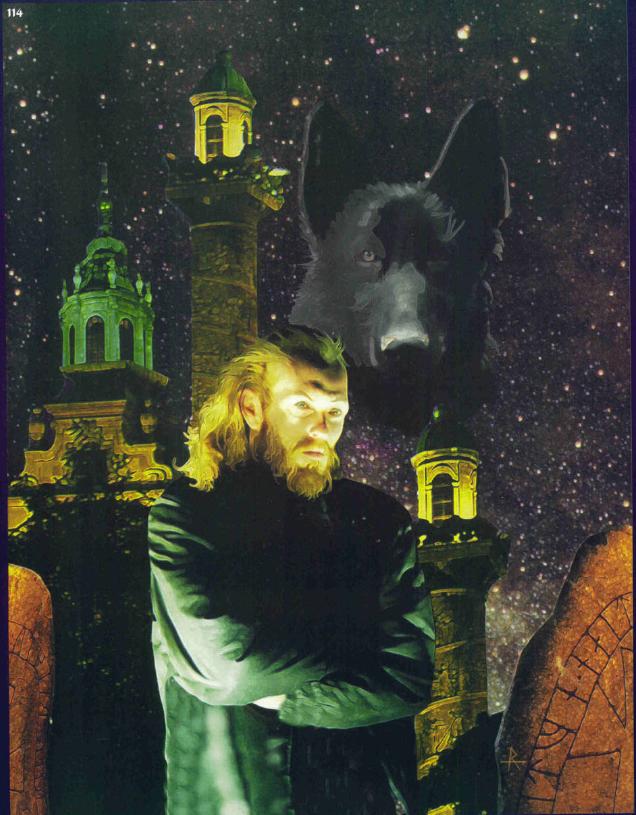
I want to speak to a manager. My shipping confirmation clearly states three wolves. And a moon!
Immortals are a bunch of jumped-up animals who ought to go fuck themselves, except for the Eremites ! They want to protect and purify humanity until humankind is ready to assume its rightful dominion o’er the earth, and the rest of the immortals can return to the dominions or jump off a cliff for all they care. They’re basically the Immortal Nazi Party, and I don’t know why the other prides suffer them to live.
Predilections : There’s something of the romantic idealist in them, but on the whole they’re conservative and authoritarian.
Creche : Berlin.
Appearance : Their clothing usually has a religious aspect to it. They prefer clothing in red and black or in monochrome.
Himsatis : Only higher-order primates need apply.
Legacies : Enemy Chain, Upper Hand, Valor.
Convictions
Sanguinary : We want it to die painfully.
Silence : A temporary solution until we can kill the Sanguinary.
Habitat : The only thing worth saving.
Dominions : This is where the other immortals belong. The fact that they’re blasted wastelands is their problem.
Crucible : We ought to get to the bottom of that. It could be the key to bestowing immortality on all humankind.
Morpheum : We only go there to save humanity.
Stratagem : We only play along with it because we’re not strong enough to fuck all the other prides in the ass at once. But one day...
Profane : Fuck ‘em. Well, maybe some of them are human like us.
Ingenue : A pain in the ass because we don’t know which ones are human.
Conundrum : Invaluable weapons against the Sanguinary (and everyone else who pisses us off).
Sinning : Can’t make an omelette...
Himsati : Our himsatis aren’t animals, so we are who we are.
Humanity : We will protect them, and fuck anyone who messes with us.
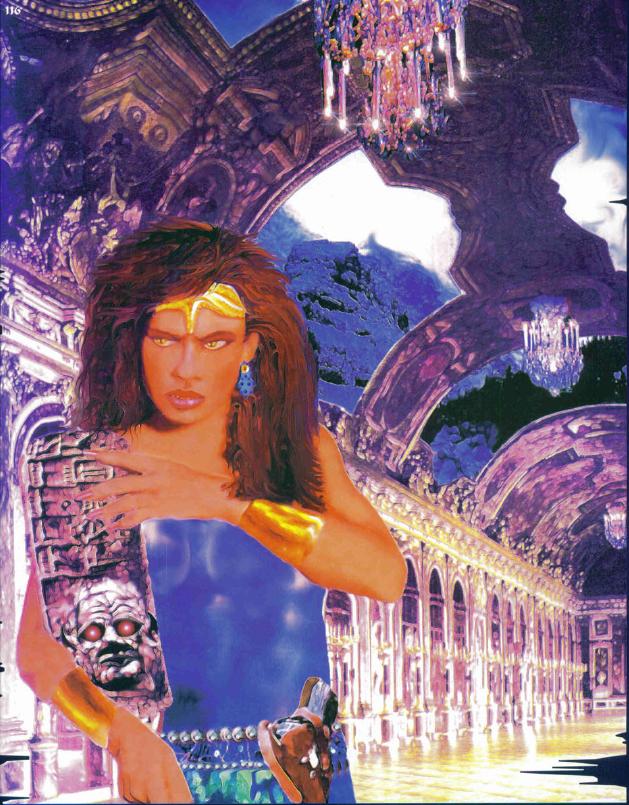
No, I don’t have the other shoulder pad! They talk over each other and that one made fun of my starfish tiara!
“Knowledge is power” is the Magdalen refrain. Only knowledge, they believe, can liberate humans and immortals alike, and it’s their job to preserve and protect it.
Predilections : There’s a reason they’re called “pedagogues.” Mentors, antiquarian types, and the more wild-eyed eccentric scholarly types populate their ranks.
Creche : Jerimia, a secret fortress in the Himalayas.
Appearance : They like to blend ancient and modern fashions, but in their mantles, their clothing shows their association with ancient Greece and Rome.
Himsatis : Various mammals.
Legacies : Censor, Esteem, Vizard.
Convictions
Sanguinary : Studying mortal writing has taught us that it’s not a simpleminded beast, but an insidious intelligence.
Silence : Breaking it can be educational, but it provokes the Sanguinary.
Habitat : Times change, but this is where the Sanguinary spills its secrets.
Dominions : Yeah, that was embarrassing. Let’s not go back there.
Crucible : The origin of all life. We wish we knew more about it.
Morpheum : The Morpheum is just another book, in which we can read between the lines to discover the Sanguinary’s plans.
Stratagem : A brilliant masterstroke. Of course, we should be in charge of it. The Jury must be biased against us.
Profane : Better keep an eye on them.
Ingenue : An unprecedented source of new information.
Conundrum : They’re valuable, but they’re the Sanguinary’s attempt to get into our heads the way we try to get into its head.
Sinning : Welp, since the Nimrod cursed us, it’s our only way to get immaculum.
Himsati : Ugh, how embarrassing. I don’t want to become a mindless beast, not even for a moment.
Humanity : We find them fascinating, and they’re the key to understanding the Sanguinary.
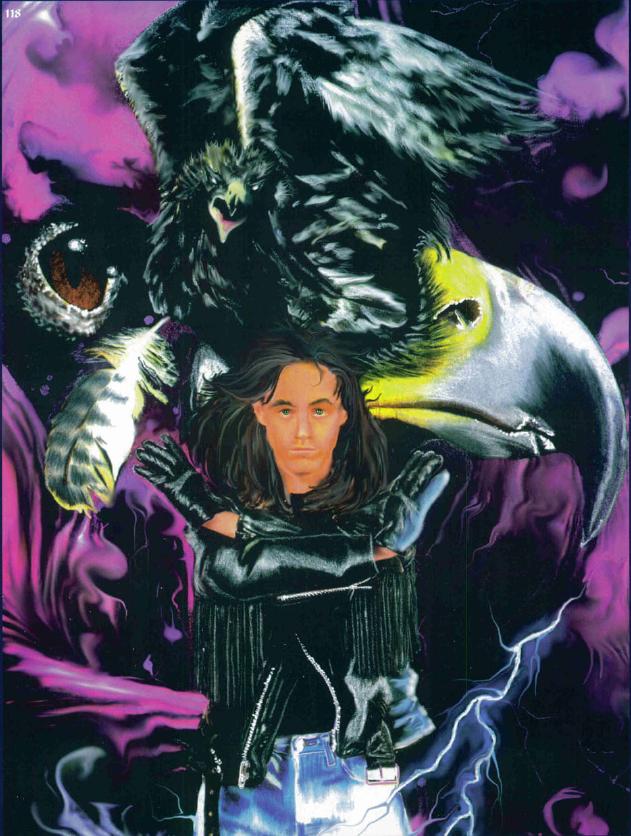
This really speaks to me. I’ve always dreamed of seeing Night Ranger get their balls struck by lightning.
The Morrigan are the Scepter Pride, did you know that? They have higher visage than everyone else, so their pride is considered number one. It’s probably because they’re so cool. They kick the Sanguinary’s ass and outmaneuver the other prides and they have great hair. It’s a little hard for them to hear you over the sound of the wind beneath their wings reminding them how awesome they are.
Predilections : They’re all about leadership, loyalty, and winning the game.
Creche : Magonia, a city that floats over the North Pole. Admit it, that’s way cooler than “Berlin.”
Appearance : They prefer flowing clothing in light colours. They can be recognized by their circlets, which they use as their pride’s identifier, and their gloves, because they’re too good to touch the ground or anything on it. Seriously.
Himsatis : Birds.
Legacies : Wantonness, the Loop, Prophylaxis.
Convictions
Sanguinary : We battle its minions in the air, because we’re so cool.
Silence : Absolutely vital! Maintaining the Silence weakens the Sanguinary.
Habitat : It’s hardly better than the dominions.
Dominions : What’s past is past.
Crucible : The only thing you’ll find in it is oblivion.
Morpheum : We don’t belong there. We only pay attention to it to keep an eye on the Sanguinary’s schemes.
Stratagem : You want proof that the stratagem is necessary? It put us at the top, where we belong.
Profane : They’re minions of the Sanguinary. Destroy them at will.
Ingenue : All they’ve done is made themselves vulnerable to being tricked and controlled by the Sanguinary.
Conundrum : They’re of the Sanguinary. We wouldn’t use them if it weren’t necessary.
Sinning : Food chain! Get used to it!
Himsati : We are perfectly in control of ourselves, in whatever form.
Humanity : Food chain! Get used to it!
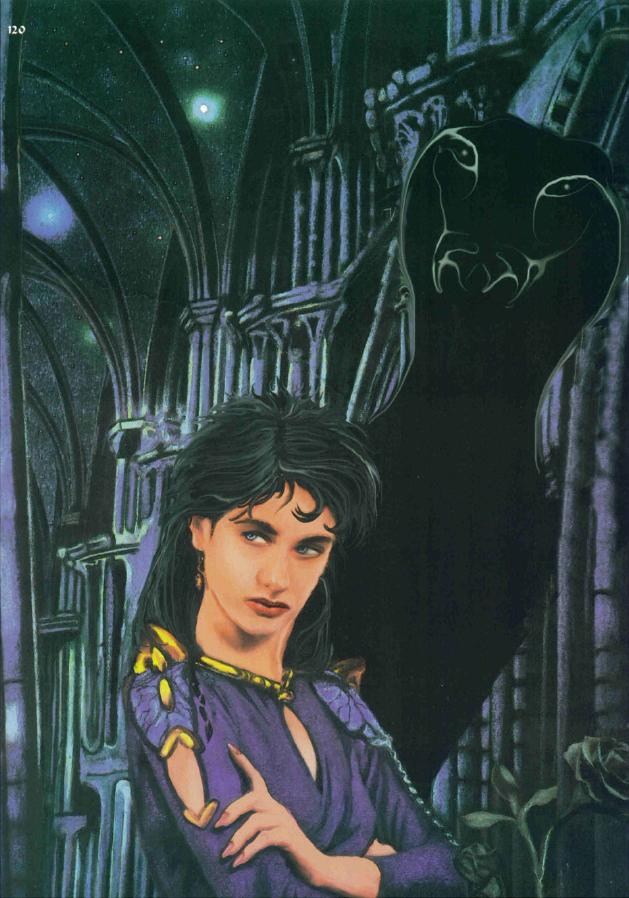
You know what I can’t stand? Giant obsidian cobras sucking my brain out. Wait, don’t tell me. There’s one behind me, isn’t there?
The Nimrod were assholes who ruined everything for everyone for thousands of years, but they’re better now, they promise, really. In fact, they should totally be in charge of enforcing all the laws, since it was actually everyone else’s fault and they’re not sorry. Who else is going to solve problems by hunting everyone down and throwing them in a concentration camp dimension where they’re forced to cannibalize each other? You? Didn’t think so.
Predilections : They tend to combine an attitude of authority and duty with a tendency to be critical. You know, they guy you don’t want coming to your pitch meeting.
Creche : Moscow.
Appearance : They like wearing post-apocalyptic getup, although this game was published about a decade too early to capture the burner crowd. They like to indicate their rank and pride status with gloves, wear triangles on their foreheads, paint their nails elaborately, and wear pins, medals, and badges all over their clothing.
Himsatis : Shadows of animals. Their shadows always move independently of their own movement.
Legacies : Animas, the Seeking, Achilles Heel
Convictions
Sanguinary : If we just maintained the Silence, it would go to sleep and leave us alone.
Silence : The reason for our existence.
Habitat : We don’t belong here.
Dominions : We weren’t responsible for fucking them up. We ought to return there and make a fresh start.
Crucible : The idea of tapping into its power is a pipe dream. Be realistic.
Morpheum : If we didn’t screw around with it, the Sanguinary couldn’t use it against us.
Stratagem : We’ll play the game until we become the Scepter pride, then command the others to return with us to the dominions.
Profane : The most dangerous immortals. We must force them to obey the Silence.
Ingenue : Ticking time bombs. They need to be controlled.
Conundrum : We should gather them and return them to the dominions, out of the Sanguinary’s reach.
Sinning : Stealing immaculum from mortals is beneath us.
Himsati : We rule our himsatis, not the other way around.
Humanity : Victims of the Sanguinary. We can only help them by divorcing ourselves from them completely.
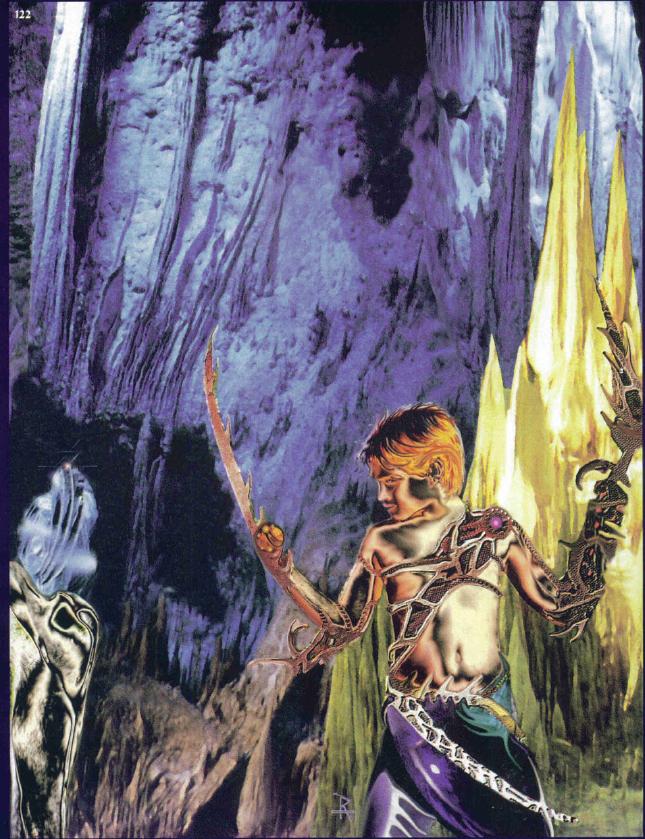
The Aquaman movie is thankfully still in development hell.
The Peri have always been soldiers and weapons of war, and don’t you forget it. They’ve been manipulated, used, lied to, and abandoned, but they’ve learned from it, and don’t you forget it if you’re thinking about messing with the Peri.
Predilections : All over the place, but they tend to be wanderers and misunderstood outcasts.
Creche : Mammoth Caves, Kentucky.
Appearance : Most Peri appear to be children. They wear normal, modern clothing to blend in, the only exception that they use necklaces to identify themselves as Peri. Even in human form, their skin has veins of metal through it.
Himsatis : Their himsatis appear to be made of stone and metal; they often look like gargoyles. They can shape themselves into weapons.
Legacies : The Bonding, Gamut, Momentum.
Convictions
Sanguinary : It’s a worthy opponent. We’ll win.
Silence : No serenades? Sure, whatever. I can turn my arm into an axe.
Habitat : The human world is noisy and confusing. We’d just as soon live underground.
Dominions : If they weren’t plague-ravaged, we’d gladly return there.
Crucible : We believe it’s oblivion. Either way, if you’re looking for spiritual enlightenment, you won’t find it there.
Morpheum : Sure, we’ll fight there, too.
Stratagem : We agree to it to atone for our war crimes. When we become Scepter, the slate is clean.
Profane : The other prides are wrong to be so afraid of all of them. The droves must be wiped out; the rest left alone.
Ingenue : Interesting. We want to find the ones who are Peri. Lethe is neat because it makes immortals forget what assholes they used to be, so we can be friends!
Conundrum : We’re intelligent rocks, we know an evil intelligent rock when we see one. Destroy them all!
Sinning : Only mortals who harm others should be destroyed this way. It’s not moral judgment, just good judgment.
Himsati : Although it makes us vulnerable to the Sanguinary, we can’t pretend to be human all the time.
Humanity : They’re not bad, but they should pay more attention.
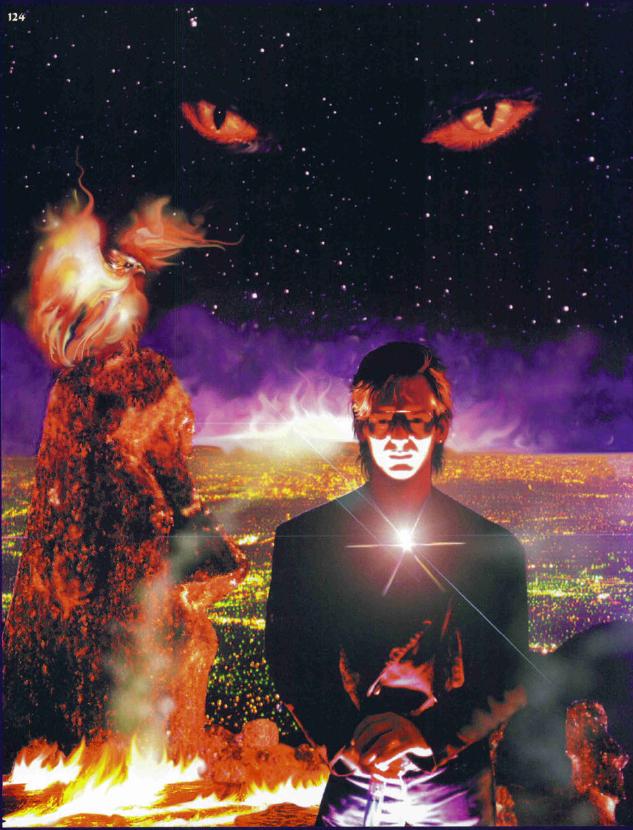
What if they did a sequel where Napoleon Dynamite discovers Photoshop?
The Phoenix clearly believe in purification and rebirth through adversity--trial by fire. They make war against the Sanguinary and offer aid and healing to those who support the cause.
Predilections : Romantics, artists, and drifters. Your bard class, I suppose.
Creche : Ancient Troy, in a mantle on the coast of Turkey.
Appearance : Phoenix are involved in youth cultures, especially biker culture, and that dictates a lot of their fashion choices. Their pride identifier is the wearing of ornate epaulettes.
Himsatis : Animal-shaped masses of fire, in contrast to the Nimrods’ shadow-forms.
Legacies : Catholicon, Prophylaxis, the Yearning.
Convictions
Sanguinary : It’s weak, and now is the time to strike!
Silence : We only obey it because it inconveniences the other prides as much as us.
Habitat : Tainted by the Sanguinary. Once we destroy the enemy, humankind can explore the galaxy.
Dominions : We must heal them of the Lash plague.
Crucible : A light so bright we can’t see what it is. After we destroy the Sanguinary, perhaps we’ll explore it.
Morpheum : We go there to wage war on the Sanguinary.
Stratagem : It allowed us to be accepted among the other prides. When we all unite, it will have served its purpose.
Profane : We were also once considered the dregs of immortal kind, so we understand that only the droves should be written off as evil.
Ingenue : If the Sanguinary hasn’t corrupted them, they might have insights into its weaknesses.
Conundrum : They’re only dangerous if not properly controlled. We’ll use them against the Sanguinary.
Sinning : We should only steal immaculum from the Sanguinary’s minions.
Himsati : We can’t contain it, and shouldn’t try, but unleash it on our enemies.
Humanity : We’ll save the pure and destroy the corrupted.
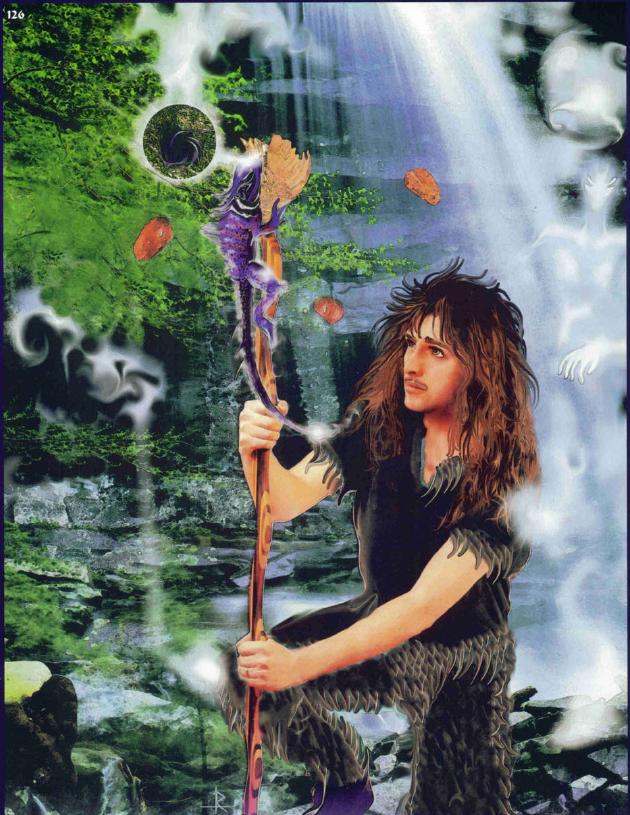
I don’t care what grandpa says. Dowsing is a load of crap.
The Tautha are, like, total hippies, man. They believe in escaping the Sanguinary’s influence by reconnecting with nature and revering the Sunedrion and the Crucible.
Predilections : Teachers, romantics, and free spirits.
Creche : The Amazon basin of Brazil.
Appearance : A mishmash of tribal culture. African and Native American clothing, body painting, tattoos, and charms and fetishes of all kinds.
Himsatis : Woodland mammals and plants.
Legacies : Masque, Oculus, Compass.
Convictions
Sanguinary : We allowed it to grow, but now we understand we have a duty to destroy it.
Silence : We abide by it for the sake of peace.
Habitat : Falling to ruin, thanks to the Sanguinary.
Dominions : A graveyard. Makes us sad just thinking about it.
Crucible : The true source of immortality, it will be our salvation.
Morpheum : We can use it to save humanity from the Sanguinary.
Stratagem : By gaining respect in the stratagem, we can get the other prides to listen to us.
Profane : Many of them could be our allies.
Ingenue : They’re starting on the path of wisdom. Hopefully, the prides will follow them.
Conundrum : They’re nothing but pollution and corruption.
Sinning : We only do what we have to.
Himsati : Our himsatis betray us. We can’t allow them to emerge.
Humanity : We would like to be friends with them, if they’d be friends to the earth.

Oh God, we have to do that scene from The Wicker Man again?
The other prides have it all wrong. The Terat call themselves the Unfettered because they don’t fear their animal forms. Rather than keeping the himsati chained up, they believe in defeating the Sanguinary by embracing it.
Predilections : Nonconformists, critics of the established order, and party animals.
Creche : Mount Kilimanjaro.
Appearance : Since they often shift to animal form, they often forego clothing entirely for jewelry that won’t be lost. They carve patterns in their claws and horns, and wear rings as symbols of the Sanguinary’s influence which they try to discard.
Himsatis : Any.
Legacies : Arenaline, Hackles, Valor.
Convictions
Sanguinary : We used to serve it, but became the fiercest enemies of the droves when we chose to liberate ourselves.
Silence : Sure. We don’t need the Sanguinary coming after us.
Habitat : Just another prison.
Dominions : When we destroy the Sanguinary, we can return there.
Crucible : We have no business messing with it. The dominions are our home.
Morpheum : We used to thrive there; now we have to take it back from the Sanguinary.
Stratagem : It’s a chore, but peace is worth it.
Profane : The other prides are just afraid to trust them. Sooner or later, they’ll find out which ones are really our enemies.
Ingenue : They just ran away from the problem.
Conundrum : If we can control them, we can control ourselves. The trick is using them without being corrupted.
Sinning : Food chain! Get used to it!
Himsati : We take control of it and use it against the Sanguinary. If that scares the other prides, deal with it.
Humanity : They can free themselves from being puppets of the Sanguinary, as we did.
Christ on a spike, that was exhausting. At least there are no glossary terms this time around.
Next time, on Immortal : The actual, for real, I’m serious this time, step-by-step character creation guide.
Me, Myself, and I of Argon
Original SA post
Immortal: The Invisible War, Part 10: Me, Myself, and I of Argon
In a section called “Genesis,” Immortal finally tells us how to create a character--I think. We’ve been fooled before. The author won’t let go of the idea that you ought to base your character on yourself, even though, as the game admits, you could easily have a past life with a different height, weight, apparent age, sex, and personality come to the forefront and pretty much remain in charge. You start with 100 memory motes to spend on things other than characteristics.
Okay, fine, I’ll pretend to be an eternal special snowflake and create myself as a character.

Paula tackles the fourth-millennia fifth.
Step 1 : Choose your “Predilection,” one of those personality traits from the list I mentioned last chapter. I don’t know if this has any mechanical effect, so I can’t powergame as myself. I’ll choose “Rake,” indicating that I am “a sensualist in the extreme.”
Step 2 : Choose your pride and calling. Is there any doubt that I’d pick Banjax? As for calling, I’m going to go with Probe. Being a spy sounds like the best way to tear shit up and then run away laughing.
Step 3 : Divide 15 motes of immaculum among your Characteristics. If you want to buy points of “free immaculum”--points that you can shift around between Characteristics as needed--you can do so now. We have to turn back to the last chapter to remind us of how to do that. Dig this:
“Each time you convert a mote from forte to free floating immaculum, you must pay one additional memory for each free floating immaculum in your halo (including the new one). Thus (starting with no free floating immaculum) to convert the first mote of forte to free immaculum costs o1, a second costs 2 more, the third 3 more, and so forth.”
This is Immortal’s way of saying “It costs (new rating) in immaculum to increase your Free Immaculum by 1 point.”
I’m going to spend my 15 points on Characteristics as follows: Resolve 3, Force 2, Expertise 3, Movement 3, Awareness 2, Resilence 2. I am smart and agile, but no tough guy. No, wait! It says I need at least 1 free immaculum to play serenades, and I can spend some of my memory points on more immaculum motes, though I have to turn back to page 93 to find out what that costs. I also have no idea how much I should be holding in reserve to buy other stuff. Regardless, I’ll spend 20 memory to buy 4 more motes of immaculum. I’ll put another point each in Resolve and Awareness, and spend 3 points of memory to convert the last two points of immaculum to Free Immaculum. So now I have Resolve 4, Force 2, Expertise 3, Movement 3, Awareness 3, Resilience 2, Free Immaculum 2. Because I spent points to raise my total amount of immaculum above 15, I’m now a Tier 2 character.
I also note my wound points, based on my actual body weight. This is the first game I’ve ever played that reminds me to stop drinking so goddamn many whiskey sours. Once again, I have to turn back about 40 pages to look up what I need: I have 10 Light Wounds, 3 Impairing Wounds, 2 Severe Wounds, 1 Crippling Wound, and 1 Mortal Wound. Being morbidly obese for my height would score me some extra hit points. Too bad!
Step 4 : It’s time to buy Talents (skills) and Attentions, which are used to play serenades. This requires us to skip ahead to chapters 7 and 9. (This, by the way, is news to me, since Immortal doesn’t actually number its chapters; I just skip ahead until I find a section marked “Talents.”) I have 77 memory motes left to spend.
Talents are ranked from Untrained (which imposes a -5 penalty) to +5, which signifies world-class talent and decades of experience. Only some ancient immortals have a talent at +6, which I find odd, since some of those guys have millennia of experience. All the stuff about how skills work is contained here, but I’m going to ignore that, buy talents, and skip back to the character creation chapter.
Spending memory motes on talents doesn’t happen on a one-for-one basis. Talents have a Complexity rated from 1-5, based on how complicated they are and how useful they are in the game. It costs 25 memory to buy +5 in Brewing or Swimming (Complexity 1) but a whopping 55 points to buy a +5 rank in Martial Arts or Forensics (Complexity 4).
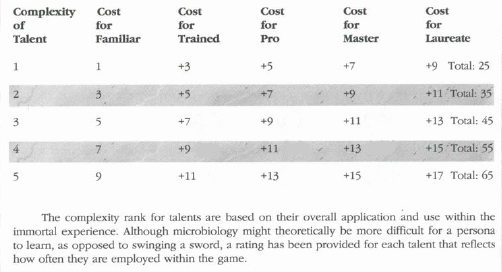
Complexity 5 is reserved for Legacies, which are supernatural talents that only immortals can learn. All of these are used to alleviate penalties by opposing certain types of hostiles--they range from straightforward talents like Achilles Heel, which you roll against the hostile incurred when you make a called shot in combat, to Aart, which you use to resist an avatar trying to take control of your body. (This, by the way, completely screws up my understanding of how the skill system works--my understanding is that if the task you’re trying to do has multiple complications, i.e. hostiles, you roll your Characteristic+Talent+d10 multiple times and have to succeed on each one. More on that later.)
So, one of the things I like about games like FATE and Savage Worlds is that they have short lists of skills which are very broad, making it good at representing heroic characters who, like heroes in fiction, are broadly competent at what they do. Immortal...doesn’t do anything of the sort. Its skill system is an artifact of 90s-style “realism” where “Melee Combat” has to be split up into half a dozen skills to reflect the fact that fist-fighting is very different from stickfighting which in turn is very different from fencing. Here, lemme copypaste at you:
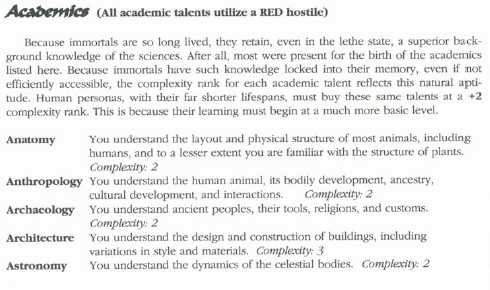
Archaeology and Anthropology are separate? Well I don’t know if that’s necessary but
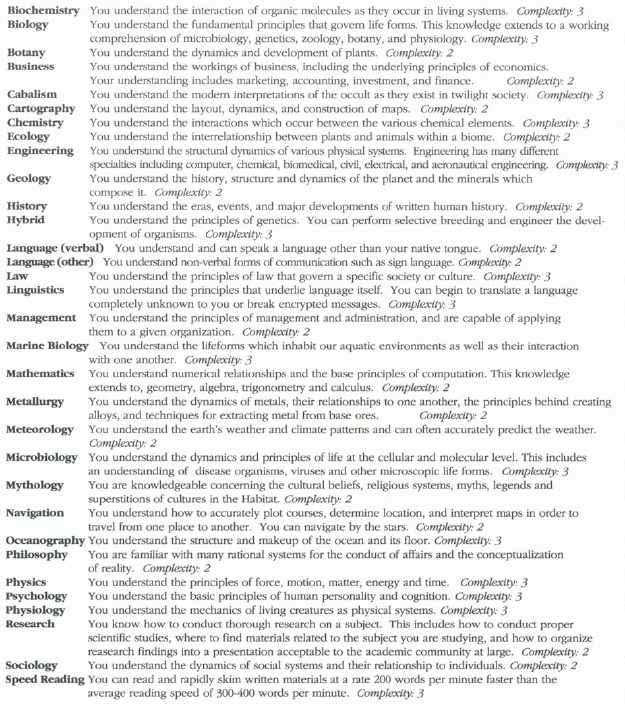
Well a lot of games subdivide academic skills too much, it’s a common mistake and
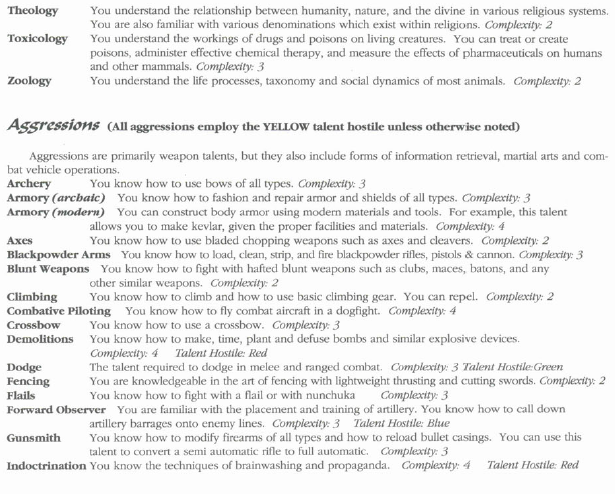
Okay guys this is splitting hairs too much I think you should
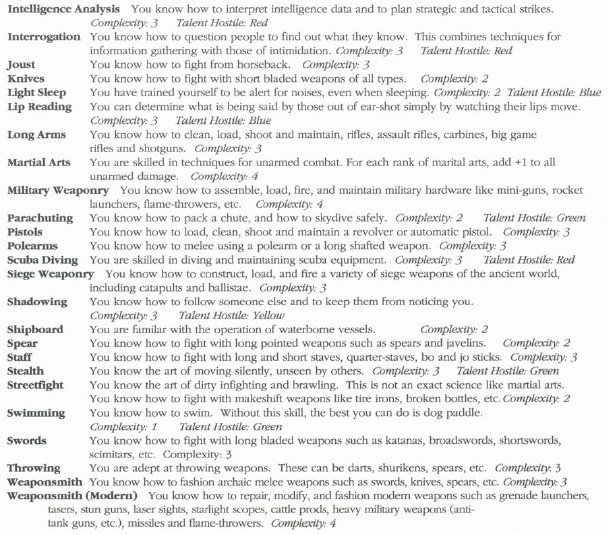
Oh come on this is just
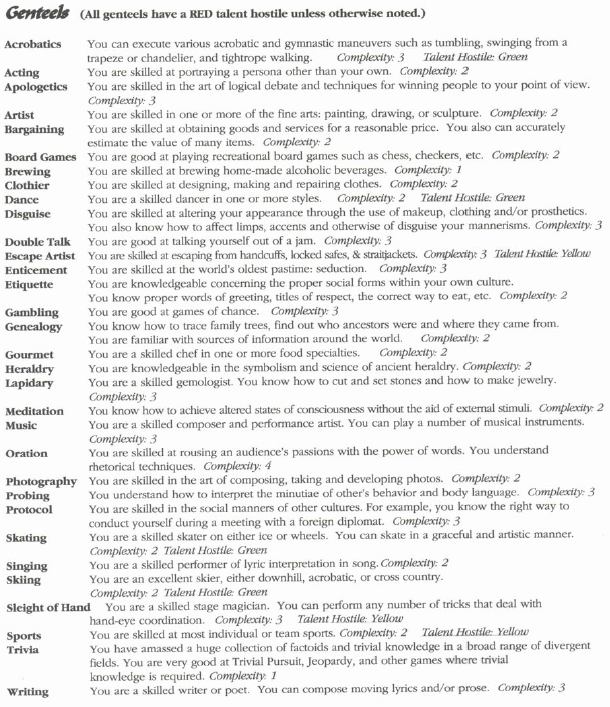
”Genteels” what the fuck do you even
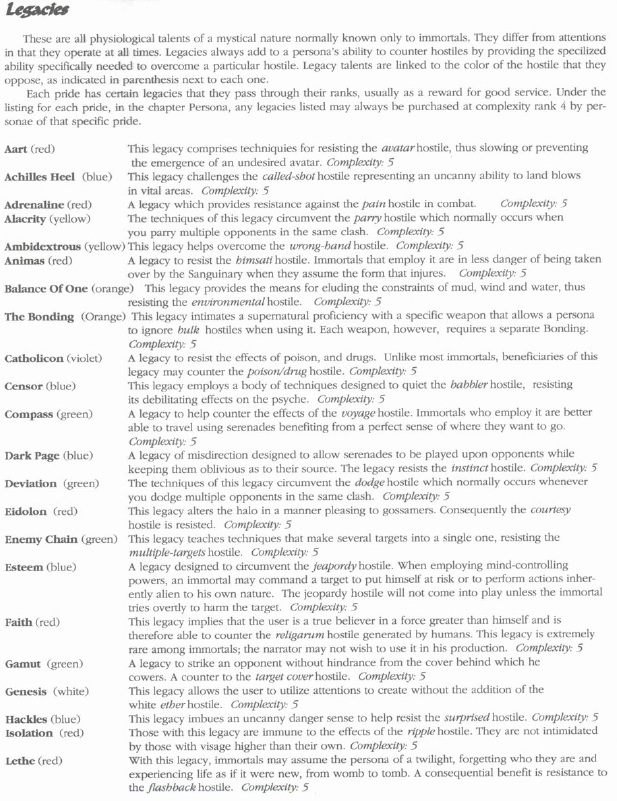
No but this isn’t even how the skill system works it said
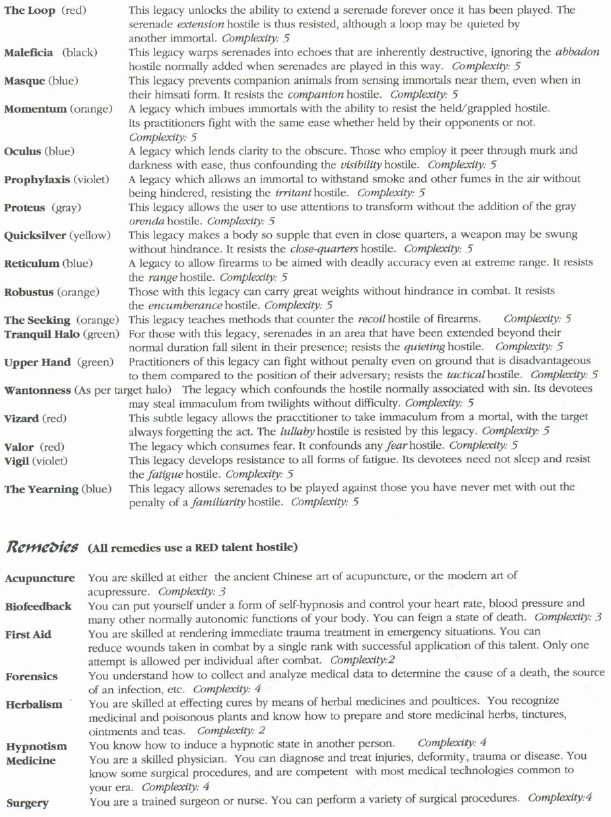
Oh the hell with this
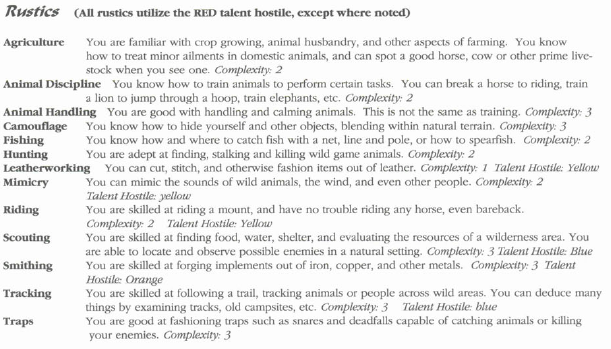
Fuck you just fuck you fuck
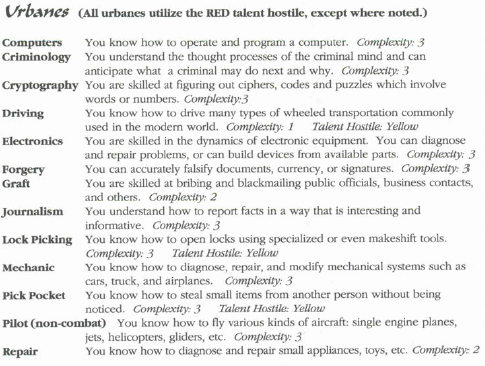
no

Woodworking.
As you can see, because this is Immortal, talents are divided into ornately named categories. Combat skills (I mean, Aggression talents ) are all based on Expertise unless otherwise noted, Legacies are based on various characteristics, and all the other talents are based on Resolve unless otherwise noted, which is horribly unbalanced. Yes, there are some skills based on Movement and Awareness, but it’s clear that Resolve and Expertise are the best Characteristics.
Hey, remember when I said this was a character creation chapter? It still is. I’m no Renaissance man, but with all of these expensive and discrete skills, I’m not sure I can even create an avatar of myself with the points I have to spend. First, I’ll buy Cabalism (the occult talent) at Rank 1, to represent the New Agey gobbledygook I waded through to review this piece of shit. Then I’ll buy:
History 1 (I used to post in Ask/Tell)
Mythology 1 (I post in Batman’s Shameful Secret)
Psychology 1 (I post in grognards.txt)
Martial Arts 1 (I post in Punchsport Pagoda)
Dodge 1 (I troll in Punchsport Pagoda)
Research 1 (I post to Debate & Discussion)
Board Games 1 (I play Arkham Horror)
Aart 1 (I’m good at managing the voices in my head)
Writing 1 (apparently, some of you can read this without going mad)
The cost of being barely educated in a bunch of mostly non-adventurous skills? 48 memory motes. That leaves me 32 points to spend on serenades (and anything else that I have to buy but which the game hasn’t told me about).

It’s pretty much my favourite animal.
Skipping ahead past the combat chapter we come to the chapter on serenades. There’s a whole lot of bullshit here that I’m just going to ignore in favour of going through the Attentions and spending points on the ones that look interesting. (A word of clarification here: You don’t buy serenades, you buy Attentions. Serenades are what happens when you use the Attention, in the interests of making the fluff of this game more bloated and confusing.) Attentions are bought like talents, and have a Complexity; most Attentions are Complexity 5, and you get to buy some of them as if it were 1 lower, based on your pride--Immortal’s equivalent to “in-clan Disciplines” in Vampire. I’m going to save my points by buying nothing but Banjax speciality powers:
Bastion 1: I can protect myself with mirrored psychic armor.
Flux and Flow 1: Allows me to defy gravity. With Rank 1, I can treat tightropes and ledges like solid ground.
Inroad 1: I can attack someone else’s mind by targeting their Red (Resolve) halo, even inflicting death by brain hemorrhage. Level 1 just inflicts a light wound.
Veil 1: I can become invisible to anyone with Awareness of 3 or less, and cast no reflection.
I suck at all these powers because they’re absurdly expensive, but I’m still invisible, covered in shiny skintight armor, and I can run up walls and kill you with mind bullets .

Is this 1994 I see before me? Does it want its haircut back?
Step 5 : This is the “Concept” section. Since my concept is presumably myself, Immortal suggests that I deliberately take a low-level taboo in order to make my character unique. Taboos are curses you suffer from stealing immaculum from mortals--but turning to the chapter on “Purity,” I see that low-level taboos are special snowflake bullshit like having oddly-coloured eyes and having your hair flow as if it’s always windy.
You’re also advised to give the Narrator any ideas you have about your characters’ past lives so he can work them into his story. But ultimately, it’s up to the Narrator to decide if your character is literally Hitler and Genghis Khan.
Immortal also suggests a really stupid idea: You can play a Gossamer if you want to. Gossamers don’t have Strength or Resilience, and can only access the real world in haunted places called Shallows, where they try to contact mortals and immortals to ask for immaculum so they can eventually recorporate. So if you want to play a crippled ghost, have fun, I guess.
At no point does the character creation process say anything about choosing a himsati form. My character is a Banjax, who can have anything as their himsati. I choose:

I’m the one on the left

Where we’re going, we won’t need eyes to swim.
Next, I’m asked to answer a questionnaire. The answer to all the questions is fuck you.
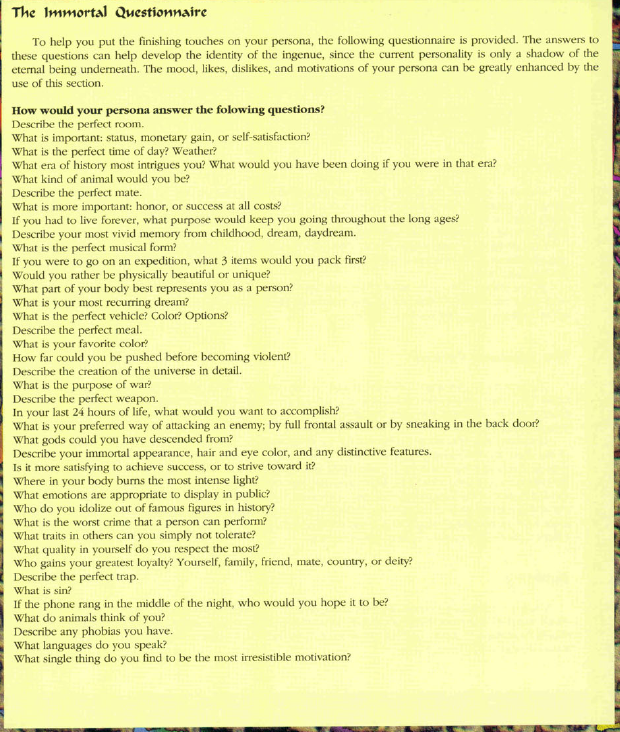
So here's my character.
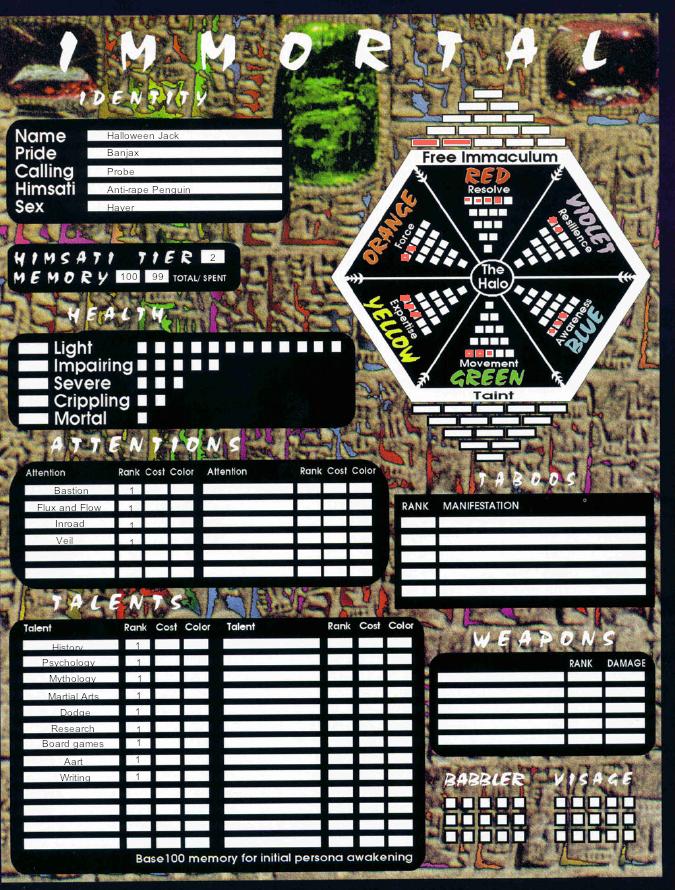
I'd rather take a class in an insane asylum on how to paint dead clowns.
After the character creation step-by-step is, y’know, finished , we’re told that we can buy Contacts. For 3 memory motes you can buy a contact who will work with you on a quid pro quo basis; for 15 you can buy one who would die for you. Relative usefulness is not a factor. We’re also told how visage works--it goes from 1-15, and as it increases, more nearby immortals will feel a surge of power when you’re in the area. We’re also told it can be used in combat. Visage can only be earned in-game and awarded by the Jury, so forget about that. We’re also told about the Ripple--as your Tier rises, your very presence creates a ripple of power that immortals, and eventually other living creatures, can sense. This explains why the really powerful immortals tend not to go gallivanting about in the world where their presence can draw out the Sanguinary’s minions.
That’s the end of the character creation chapter.

I will dance in your blood
Next time, on Immortal : I figure out what all that shit about hostiles and serenades really meant.
Roll on, thou deep and dark blue d10, roll!
Original SA post
Immortal: The Invisible War, Part 11: Roll on, thou deep and dark blue d10, roll!
Okay. Three weeks later, I’m back. I really wasn’t looking forward to this part, as I meant for it to involve sorting out all the confusing rules that Immortal throws at you whenever you try to, y’know, roll dice to do something .
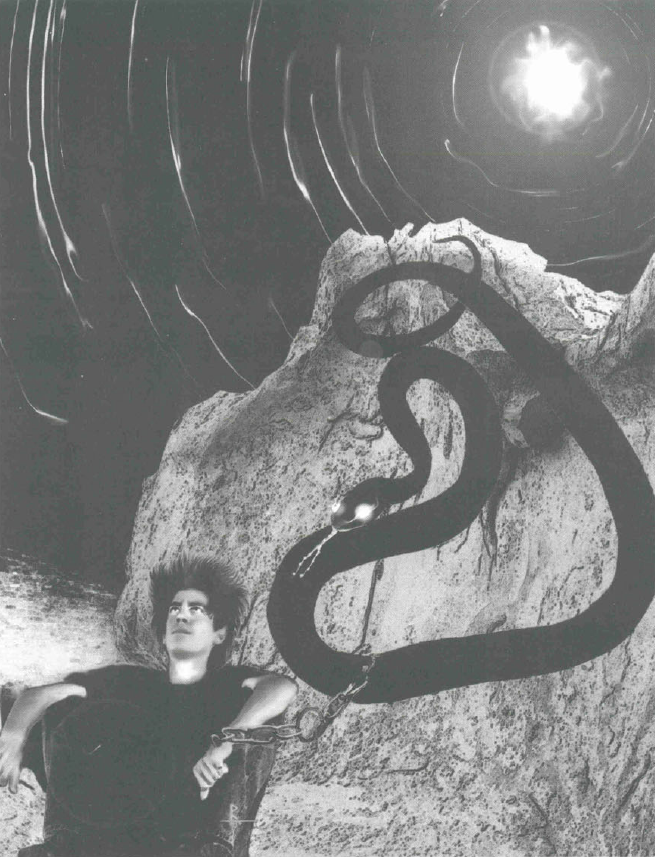
Morpheus is really tired of Death’s “Why did it have to be snakes” gag.
Pretty much every roll is Characteristic + Talent + 1d10 against a difficulty number. The system is fucked because:
1. Each factor that makes the task hard is a different hostile which requires a separate roll. You have to succeed on every roll to succeed on the task. So if you’re trying to pick a lock while wounded, and you’ve been drugged, you’re making three rolls: Expertise + Lock Picking, Resolve + Adrenaline, and Resilience + Catholicon.
2. Adrenaline and Catholicon are examples of “Legacies,” expensive talents that only exist to make rolls involving extra hostiles. This also means that when you’re trying to pick a lock (for example), you are not only making multiple rolls to succeed, your Lock Picking skill only contributes to one of them.
3. Rolling a 10/0 on any die is a
4. The narrator determines the difficulty number for each die. So in the example above, you might need to roll a 10, a 6, and a 4 because the lock is really secure, the wound is not too bad, and the moonshine you drank was pretty weak.
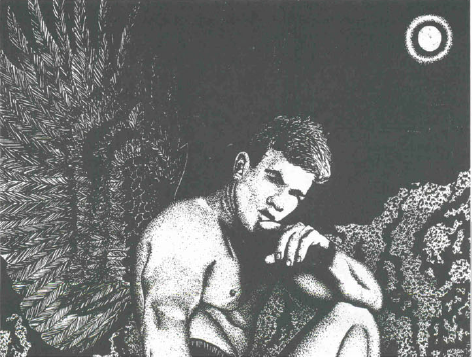
Philosorapture
The PC’s only saving grace is that if you rolled over the DN on the initial talent roll (Expertise + Lock Picking in my example), you can spend the margin to improve the others. So if you needed a 6 on your Lock Picking roll and got a 10, you can spend those 4 points to increase the other two rolls if you failed them. This, of course, means lots of rolls are tedious and time-consuming exercises in determining different difficulty numbers, making multiple rolls, and allocating bonus points--if you actually play by the rules, which I bet no one ever did.
So, in a system that was built to handle ancient immortal demigods, you have a ruleset where characters have a scant pool of points to buy ridiculously specific and expensive skills, simple tasks require multiple die rolls if there are slight complications, and you fail a lot because of stupid critical failure rules.
You just know that this is going to get absoludicrous in combat.
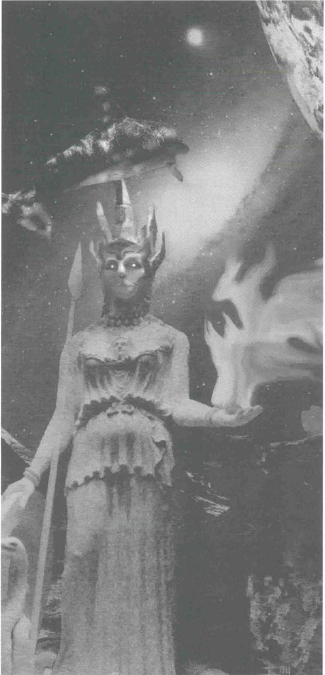
This image summarizes the diversity of thought that went into writing Immortal: The Statue of Liberty is Catwoman is Poseidon is a wizard throwing fireballs at space dolphins.
Immortal Kombat!
”Every now and then, the world needs a good war to rescue it from the insipid hoarding of civilization.”
--The Peri, most of whom were born from the mass murder of children.
The combat rules begin by telling you that whenever you enter combat, time becomes divided into “clashes,” a pretentious name for three-second combat rounds. Ten clashes comprise a combat turn. We’re then told of the common hostiles that can complicate your attempt to viciously maim someone--most, like “cramped quarters,” “grappled,” and “wrong hand” are straightforward, although combat with
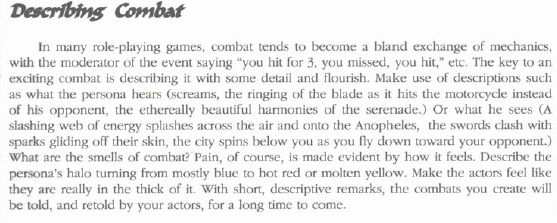
Combat in Immortal: Basically watching Highlander on acid.
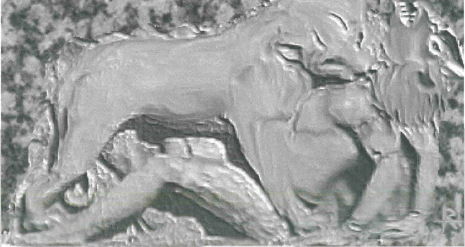
Kisses! Kisses for mommy!
Immortals benefit from the Panacea, a rapid healing of any wound inflicted without your halo being in contact with the halo of the person wounding you. Immortals heal one wound level for every clash that passes; even a Mortal wound takes only 5 clashes (or half a turn) to heal. Immortals will even do stuff like leap off of a skyscraper to escape pursuit, since they’ll be up and running faster than their pursuers can get down the elevator. If you get close enough to beat on an immortal with your fists, or chop them up with a sword or axe, they heal at the same rate as humans, barring healing magic. Immortals are particularly vulnerable to toxins, so wounds inflicted by poison, venom, etc. take twice as long to heal. There are no guidelines for how much damage a dose of poison or a rattlesnake bite inflicts, though. Strangely, there is a table for damage from exposure to heat and cold.
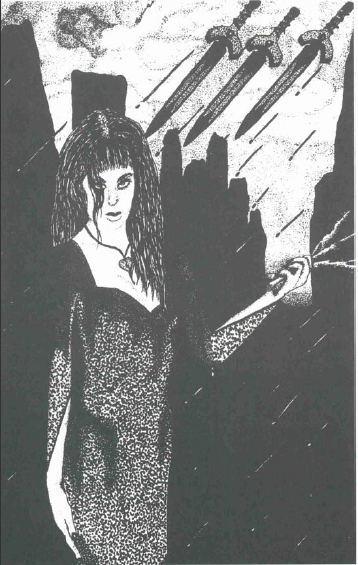
You want to buy the BADLY DRAWN GLADIUS for 180GP? Okay, then I will buy the HANDFUL OF LIGHTNING TWIGS for 10GP. Is that okay? [Y/N]
Anyway, resolving each clash is supposedly a simple three-step process:
1. Allocate your free immaculum to boost whichever attributes you want. Unspent motes give extra actions and initiative.
2. Roll 1d10 for Initiative. Apparently, no stat but free immaculum boosts it.
3. “Resolution and damage,” which is where it gets complicated.
Immortal completely tops itself in the “pretentiously renaming common game terms” field when it comes to actions in combat, which are called escapades . Most actions cost one escapade--drawing, attacking, extra dodges and parries, getting up, and so on. Immortal has some sensible rules for what costs extra actions. For example, blocking or dodging multiple attacks during each clash requries either extra escapades, or rolling a Parry hostile, and you can spend escapades aiming for a bonus to your attack roll. It also has some odd things that cost an escapade--surveying the battlefield, turning to face opponents behind you, and focusing on a new target, none of which have rules dedicated to them. You can buy extra escapades for 3 points of unspent free immaculum apiece, and you have to wait for each combatant to take one action before you can spend your extras.
Attacking : You roll your Characteristic (usually Expertise) + weapon Talent, and you also need to succeed against any hostiles for stuff like wounds or poor visibility.
Defending : The defender does the same with Expertise + weapon Talent or Movement + Dodge talent; the higher roll wins. Count the difference.
Damage : Margin + attacker’s Strength + weapon Damage equals base Damage. Then you roll 1d10 on a hit location chart.
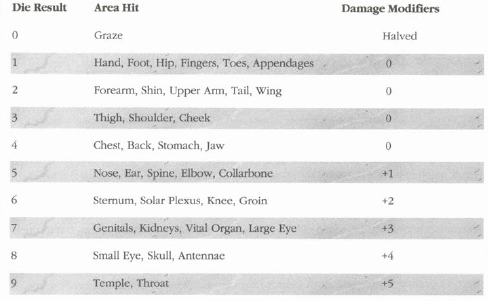
”Sternum, Solar Plexus, Knees, and Groin, Knees and Groin.” I remember that song from Bible School.
Then you subtract the defender’s Resilience + any armor and consult another chart.
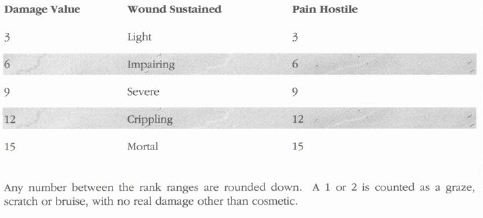
This makes too much sense for this book.
So, not a very complicated system, except for a pointless random hit location chart and the really, really bad idea of making every complication/penalty call for an additional roll. Oh, and a bunch of little shitty specific rules to slow down combat:
1. Optional rules for stunning and knockout,
2. Grenades rules.
3. A table for bonuses for having a rifle scope.
4. Autofire rules, with burst-fire weapons firing 3 shots and full-auto firing 5, and you’re supposed to roll separately for each shot. Fuck that.
5. Armor degradation rules, rolled every time someone wearing armor is hit.

You will find the Terrible House Rules in the Shrine of the Silver Monkey.
For some strange reason, the combat chapter also lists all of the “standard” hostiles that a character can incur when trying to perform an action, whether or not they have anything to do with combat. In some cases, it doesn’t explain when these will come into play. Many of them have a standard scaling: Rank 1 is Difficulty 3, Rank 2 is Difficulty 6, and so on, but others have their own little chart explaining what the difficulty should be and the consequences for failure.
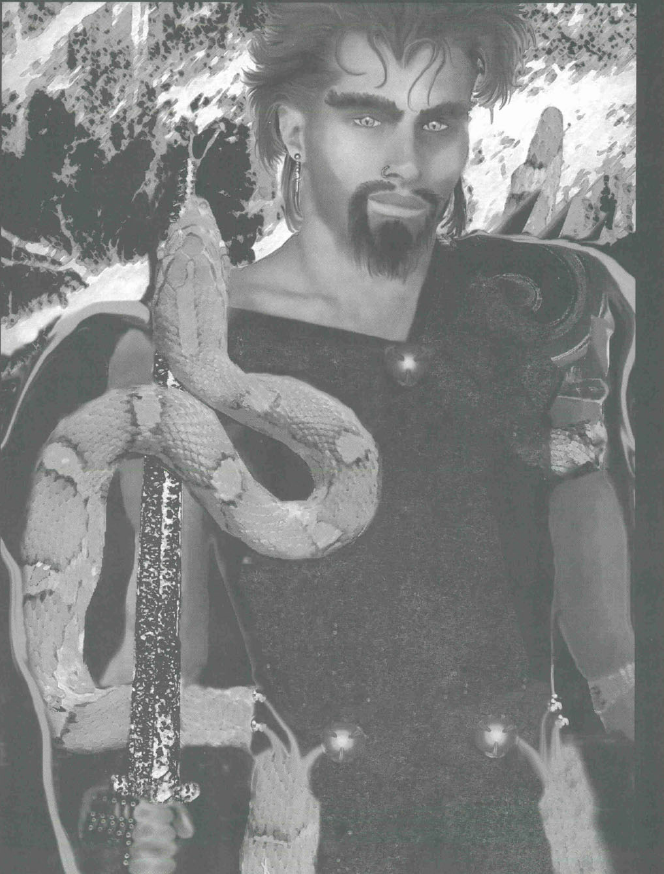
Jake “The Snake” Roberts refuses to talk about his younger brother, who has mellowed out a lot and runs an antique store in the Village.
Avatar : A roll to resist having another avatar take control of the body. When this comes up is not mentioned.
Babbler : A roll made whenever you “level up” to the next tier, to prevent falling into
Bulk : A roll made if you’re using a weapon too large for your Strength rating to handle. There is a huge table of weapons, of course.
Called Shot : You can roll a hostile to automatically hit a certain location for bonus damage.
Colostrum : A roll you make any time you play a serenade if you’re addicted to colostrum, a type of liquid immaculum. Of course this incredibly minor setting element needed its own rule.
Companion : A hostile that happens when an immortal with Taint goes near animals that resemble his himsati. There’s a chart to tell you how mad the animal(s) get based on how tainted you are and how well you roll.
The Courtesy : A hostile for trying to deal with gossamers, immortal ghosts.
Cramped quarters : For using big weapons in tight spaces. Thankfully, there’s no chart and this is left up to Narrator judgment.
Dodge : A hostile for dodging multiple opponents in a
Encumbered : For trying to do anything difficult while encumbered.
Environmental : For doing difficult stuff in wind, water, and/or mud.
Extended Maneuvers : A thing you can roll to determine if someone can complete a task taking a long time (like building something) in a shorter time.
Familiarity : For mind control. It’s much easier to mind-control your friends and family!
Fatigue : In the event that combat lasts more than ten clashes, everyone starts making fatigue checks every round!
Fear : For acting while dealing with something that triggers your fears. What? No, of course there aren’t any rules for when that comes up.
Firearm Recoil : A special hostile just to deal with firing machine guns.
Flashbacks : Used “whenever the narrator wishes to allow memories of a persona to come forth for advancement of his plot.” So you can roll dice to resist the GM introducing a plot device!
Held/grappled : Hey, you know what’s a good idea? Making “roll against a grappler’s Strength to be able to act” more complicated.
Himsati : To resist not acting like a wild murderous animal in your himsati form.
Instincts : To play a serenade without being detected.
Irritants : To resist being distracted by smoke, fumes, allergic reactions, etc. Why this can’t just be treated as a wound penalty, I don’t know.
Jeopardy : To resist being affected by illusions or mind control. And for buying vowels.
Lethe : Used to remember past life memories, with difficulty based on helpfulness. I don’t think the writers considered the possibility of PCs always being able to “remember” helpful hints with a die roll.
Lullaby : Used to take immaculum from a mortal and make them forget about it.
Multiple targets : To hit multiple targets with one serenade, and it only applies to serenades.
Pain : Your “wound penalty” hostile.
Parry : Like Dodge, but for parrying multiple attacks with your hands/weapon.
Poison/Drug : Resisting intoxication.
Quieting : To reduce the duration of a serenade.
Range : Shooting a target at farther than point-blank range.
Religarum : Resisting a human using religarum on you.
Serenade Degrade : A cumbersome name for a hostile for breaking down magic defenses, so complicated that we're told to read about it in the next chapter.
Serenade Extension : Extending the duration of a serenade.
Sin : The hostile you need to beat in order to steal a mortal's immaculum. Failing the roll creates a taboo, a mystic curse.
Surprised : A hostile created by an ambusher's stealth roll; if you beat the hostile, you aren't surprised.
Taboo : Whenever one of your taboos comes into play--like maybe you've been banned from entering a home without being invited, like Dracula--this is what you roll against to resist it.
Tactical : A hostile for when you're fighting an opponent behind you, on higher ground, and suchlike. Mostly left to narrator discretion.
Talent Hostile : The basic hostile that you have to roll whenever you attempt a task.
Target Size : A hostile for hitting small targets. I guess that's relevant since you could very likely be a gorilla fighting a bat in this game.
Target Cover : Used to shoot a target that has cover to hide behind.
Visage : When two immortals are about to come to blows, the Visage awarded by the Perpetual Society acts as a power to mystically intimidate the other. You roll this hostile to overcome it.
Visibility : To overcome darkness, bright light, fog, rain, etc.
Voyage : A hostile used when you try to use a serenade to teleport somewhere you've never been.
Wards : When trying to manipulate an enchanted object in any way.
Wrong Hand : The "off-hand penalty" hostile.
After a brief example of combat, in which an immortal blasts a Sanguinary-controlled cat in half with a shotgun, we’re told that “fighting is not all that the Immortal experience is about” and “if the Story and the System ever clash, the Story always wins.” Yeah, because as muddled and nonsensical as the Story may be, dealing with the System is like threading copper wire up my urethra.
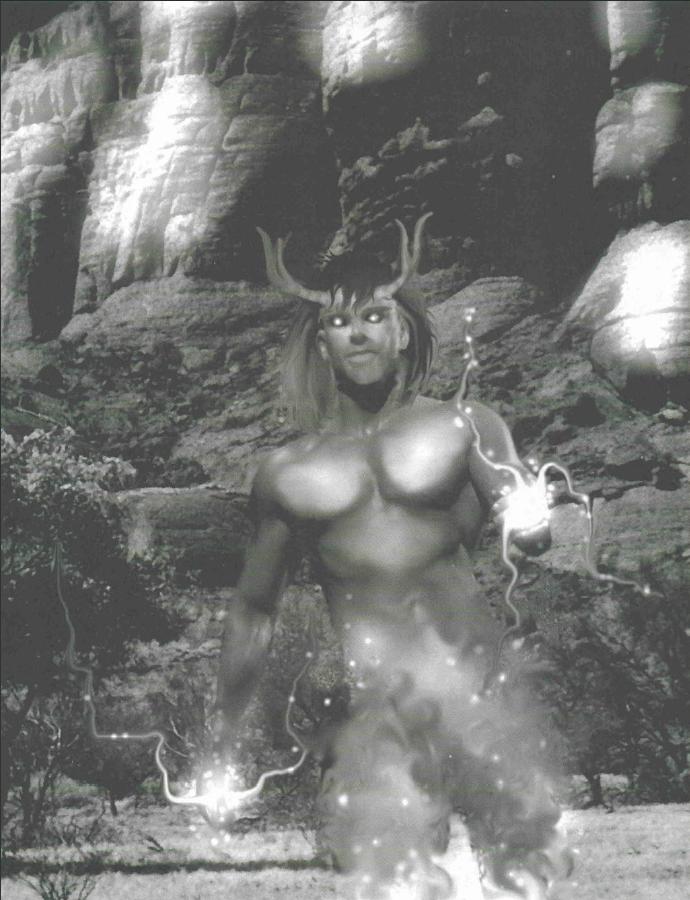
If you wear stage makeup and hold lava lamps for too long, your crotch dissolves. True story.
To be honest, there are some interesting ideas here. Treating different challenging factors in a task as that-- separate challenges--changes the dynamics of how the game work; for example, you can spend multiple actions to be able to make multiple dodges in a round, but if you’re skilled enough you can dodge multiple opponents without doing that. And since complicating factors are treated as extra rolls, not as minuses, you can go for long shots and crazy stunts as long as you think you can make each roll, since your success won’t be diminished by penalties if you do. Want to shoot a guy half a mile away, behind cover, in the dark, while badly maimed? Make the roll 4 times and if you succeed, you’ll succeed brilliantly.
On the other hand, “The weapon is oversized and in the wrong hand, so that’s a -2 penalty” is a much simpler way of dealing with things. And, of course, they probably never calculated average chances of success when you might conceivably have to roll a die 4 times to do one thing, with a 10% chance of auto-failure on each roll.
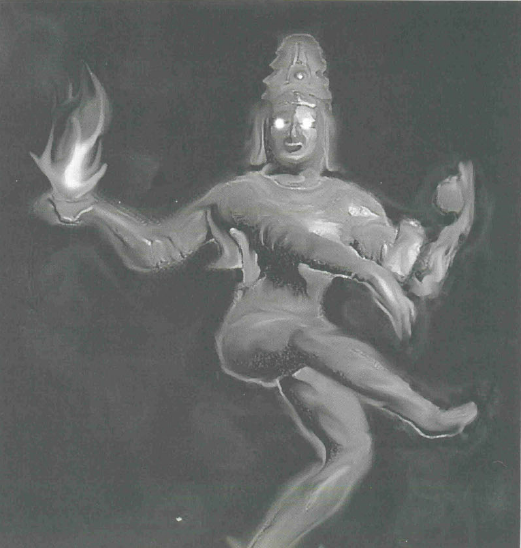
Do not taunt Blurry Fun God.
This was a long-ass chapter, and comes with a long-ass list of Fancy Magic Jargon Words.
The Flood : The constant flow of energy from the Crucible that infuses all life forms.
Glamour : The part of immortal DNA that allows them to shapeshift.
Glorious Crime : Slaying another immortal on Earth. Coined by the Banjax, who like killing people.
Glyph : A bullet or arrow that's been enchanted with Abzulim hieroglyphs.
Gossamers : The drifting souls of slain immortals that wander around until they can get immaculum to reincorporate themselves.
Great Darkness : A yearlong "nuclear winter" sort of thing that occurred when the Sanguinary impacted the earth. How anyone witnessed it is a good question.
Habitat : What immortlas call Earth.
Halo : The aura of immaculum that surrounds all living beings.
Hebdameron : Seven sentient jewel-like conundrum, possessed by some of the prides. The Hope Diamond is one. Apparently they evoke emotions and are a sort of anatomy of the Sanguinary's mind. What do you want to bet we don't see them mentioned again?
Hailstones : The conundrum used to build Nivalea, whatever that is.
Highbinder : Calling of the bounty hunters of the prides.
Hijack : Immortal slang for stealing information from a computer. I don't know why that matters, except that this was kinda new in 1993?
Himsati : The original form of an immortal, the animal, plant, or elemental matter which gained sentience when a conundrum fused with it. Immortals are vulnerable to possession by the Sanguinary when in their himsati form.
Hive : Collective term for immortals with insect himsatis.
Horned Lord : The progenitor of the Nimrod pride, and later, the Phoenix pride.
Hush-hush : The Sanguinary's lair within the Morpheum, the mortal dream realm. Likened to "the master control program of a sophisticated AI computer." Yahoo, it's Dream-Tron.
Illuminati : Members of the Apocrypha who betrayed the order to become immortal, who supposedly control the order now. That's news, since we were previously told that the Apocrypha are against immortals.
Immaculate : An immortal free of Taint.
Immaculum : Mystical life force that infuses all beings, flowing from the crucible.
Immortal Celebrant: The third of the Ishim, whoever they are, and the root of the legend of Santa Claus. Seriously.
Incubus : A giant conundrum that was cut apart to make the Hebdameron. It was formed by the Rime, whatever that is.
Infinity City : Nivalea, whatever that is.
Ingenue : Immortals who entered Lethe after the last great battle with the Sanguinary in 1666.
Invisible War : A war that started in 1990 when minions of the Sanctuary stole the Femme Darkle. The prides have since declared open warfare on the droves, and trying to get the Darkle back before it can be used to summon the Sanguinary to Earth again.
Ishim : Three immortals created by a merging of Primals and the Sunedrion trees, sworn enemies of the Sanguinary. They are the Horned Lord, Lightning Man, and Celebrant.
Jerimia : The fortress of the Magdalen, in the Himalayas, supposed to contain a copy of every book ever written.
Jesters : "The architects of flesh, the tryst derived from the terat, Jesters posed as freaks in various carnivals throughout the nineteenth century in attempts to destroy P.T. Barnum, a dangerous member of the Apocrypha with the most powerful religarum ever known." I can't make this shit up!
Jugglers : Calling whose members are manipulators, asset handlers, and troubleshooters for the prides.
Juliet : Immortal slang for a beautiful woman.
Jury : The council of powerful immortals who act as an impartial arbiter between the prides and award visage.
Keeper : Calling of bodyguards for people, places, and things valued by the prides.
Kenosia : When an immortal commits suicide to escape the droves, so his soul (gossamer) can escape into the Blue Air.
Kuruvinda : A magic crimson mineral used to create bloodshields. I don't remember what those are.
The Lash : A deadly plague created by the overuse of serenades during the Shouting War. It's a telepathic disease that causes psychotic delusions and a craving for fresh blood.
Lethe : A ritual that allows an immortal to shed immaculum and memories until they are indistinguishable for a mortal and can't remember their previous life. Lethe wears off as the immortal slowly grows more powerful over time. Every time lethe is entered, a splinter personality is created.
Leviathan : A giant reptilian monster, one of the Trine summoned out of the Crucible by the Anopheles pride.
Ley Membrane : The "skin" of the crucible, one can use it as a sort of subspace shortcut to travel around the world.
Lightning Man : One of the Ishim, progenitor of the Morrigan.
Looker : A mortal that can perceive immortals' true forms.
Lullaby : A pleasant dream-state that mortals enter when they freely give immaculum to an immortal.
Madonna : A very rare immortal woman who can give birth to another immortal's child naturally.
Maelstrom : The "chaotic helix of the Firmament," whatever that is, from which the Primals come.
Maestro : The guiding mind in a meld, whatever that is.
Magdalen : One of the prides, they're notable for having never been trapped in Sheol (because like the Eremites, they're descended from the Anathasians who were created later). They manipulate mortal beliefs and commerce.
Malice Shard : A giant block of conundrum created by the Sanguinary trying to reincorporate itself; shattered by the Anopheles in 400,000 BC when they invaded Sheol. When it shattered, the shards created the dominions and some of the mantles now existing.
Manitou : A tryst that comes from a Primal. I don't exactly remember what a tryst is.
Mantle : Oh, right! So an immortal can create a sort of half-immortal baby, merge that baby with a conundrum, and use that to create a pocket dimension that can be accessed from any fixed location, like the proverbial wardrobe. Mantles are cool because they're not corrupted by the Sanguinary, you can play serenades in them without consequence, and most of them are "themed" by the tryst's memories, like they're perpetually Ancient Greece or something.
Melding : When two serenades are combined to create a unique effect, or two immortals play a serenade together.
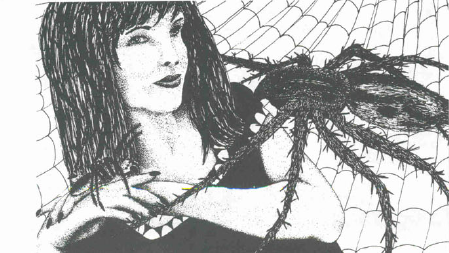
The art in these Sandman spinoffs just gets sloppier and sloppier.
Next time, on Immortal : Ace of Serenaaades!
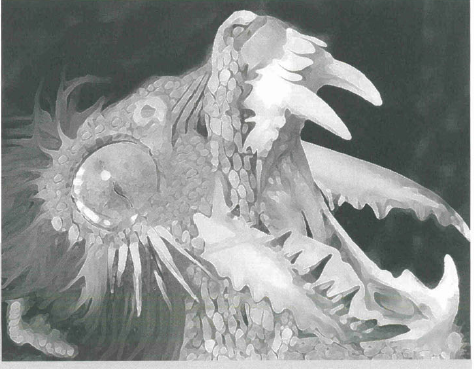
NO U
Ace of Serenades!
Original SA post
Immortal: The Invisible War, Part 12: Ace of Serenades!
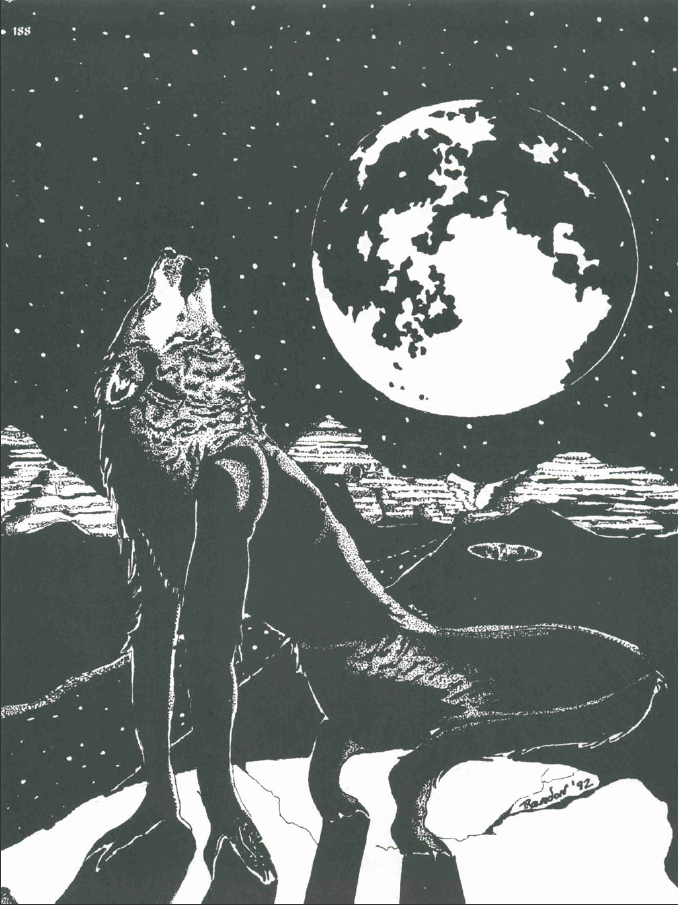
WHY DON’T YOU TAKE A FLYING FUCK AT A ROLLING DOUGHNUT? WHY DON’T YOU TAKE A FLYING FUCK AT THE MOOON?!
Immortals’ magic spells are called “Serenades.” The reason they’re immortal in the first place is that the conundrum allows them to perceive, absorb, and manipulate the universal flow of life force--immaculum--much more efficiently than other creatures. They perceive this flow as a literal “music of the spheres” and they can also manipulate it to Do Things. The Abzulim were the first immortals to try to peer into the Crucible and learn to use its power in a methodical way, and called the different disciplines of manipulating energy “attentions.” Eventually, the servitor races of immortals they created learned to imitate their power, and overthrew them.
In game terms, and as far as terminology goes, it works pretty much the same as Talent rolls. You have ranks in an Attention, you roll against a hostile, then measure the effect. The actual use of an attention is a serenade.
When you’re rolling to use a serenade to affect someone else--say, by controlling their mind or dealing damage--you roll the same Characteristic you’re trying to affect, and they use the relevant Characteristic to resist the effect in the same way that the Resilience Characteristic reduces damage in combat. (Resolve resists mind control, Resilience still resists anything that does direct damage, etcetera.) That’s straightforward enough. Immortal starts to show its typical goofiness when you use a serenade to affect something inanimate.
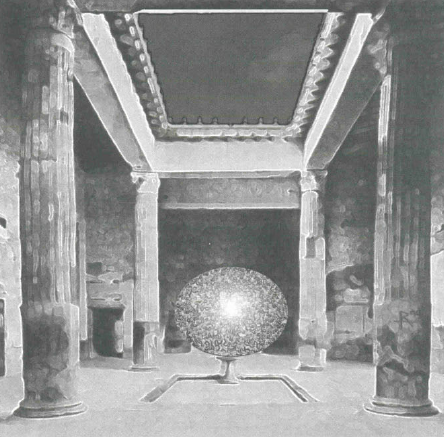
Do not taunt Roman House Orb.
When you’re using a serenade to affect something inanimate, three forces called “allies” come into play. First is Abaddon, the black destroyer, what immortals recognize as the universal force of entropy, which they employ when using serenades to wreck things. The second is The second is Ether, the white force of creation, employed if you want to create matter. Orenda, the grey transformer, is used to transform matter.
What does this mean in terms of game effects? Well, they give you a chart showing what you need to roll on that hostile to destroy stuff or create stuff, based on the object’s hardness. (This makes sense for destruction, but also means it’s explicitly easier to create platinum than nickel, and it doesn’t say how much can be created or destroyed.) There’s another chart for transformation to show that transforming a car into a different car or a knife into an axe is easy, but turning an elephant into steam is very hard, for example. It also helpfully explains that if you, say, wanted to create an acid that will do 5 levels of damage, that requires a rank 5 success.
It also tells you to roll a black, white, or grey die as appropriate, and there’s all that stuff mentioned above about immortals recognizing these game mechanics as fundamental forces of the universe that are color-coded and have names but otherwise don’t feature in the game’s background. Immortal mixes its setting chocolate with its rules spaghetti sauce and it’s fucking weird, okay?
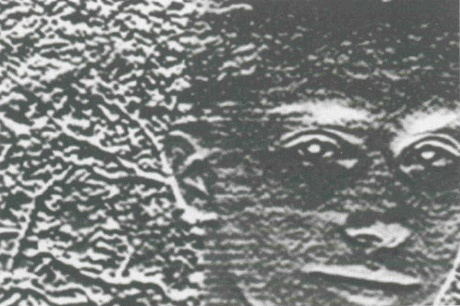
Look Who’s Photoshopping Now
To its credit, Immortal encourages you to use serenades in weird and creative ways, and it isn’t uptight rules-wise about how you do it.
An Echo is using an Attention to target a part of the target’s halo that it normally wouldn’t. For example, you could use the Impulse (mind control) Attention to target Expertise or Movement instead of Resolve, forcing the target to act slow and clumsy.
A chorus is when you combine two Attentions--for an easy example, you could combine Baston (creates armor) with Ember (creates damaging fire) to sheathe yourself in magic fire armor. You have to succeed on both hostiles or the whole effect fails, and the narrator gets authority over what’s reasonable.
A cage lets you enchant a person or object with a serenade and set conditions for it to activate--you could create a magic grenade, or you could enchant a friend so they’ll be teleported to safety if attacked.
A carnal is a weird mix of an Attention with a mundane Talent--the example given is combining Come-Hither (which summons familiar objects) with Gambling to always draw lucky cards. One I thought of is combining Bastion with an engineering skill to create a functional diving suit or spacesuit or something like that.
Finally, a warp is invoking the allies to affect reality without using an Attention at all--black can be invoked to do damage, white to create matter, grey to transform it. It’s difficult, since you have to shift points of free Immaculum to create a Black/Grey/White Characteristic where you don’t normally have one, and the effects are typically blunt and crude.
Using and resisting serenades works like attacking and defending in combat, except that resisting a serenade doesn’t cost any actions. If someone wants to use the Impulse Attention to control your mind, they’re rolling Resolve+Impulse and you’re rolling Resolve+Impulse to resist. Even if they succeed, your Resolve then reduces the rank of effect the same way Resilience reduces the damage from successful hits in combat. Multiple immortals who know the same Attention can “meld” and combine their efforts; each helper adds +1 to the total without any roll necessary.
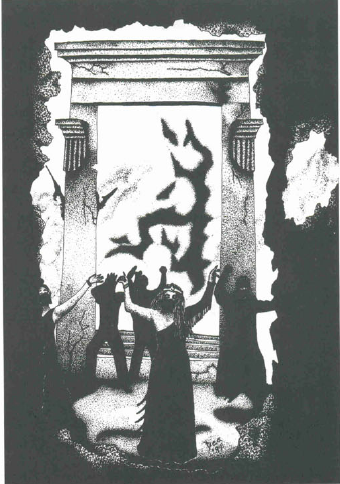
Goth clubs are never as lavish as they’re depicted in these 90s movies.
As with using talents, your success is measured in a rank of effect; 3 is minor and 15 is really good. All the Attentions have a little chart basically explaining what kind of effect you get at each rank of success, although some aren’t even necessary--if you roll a Rank 5 success with Bastion you get 5 points of armor, attacking someone with Ember and beating their resistance roll by 9 inflicts a Rank 3 (Severe) wound, and so on.
Ahimsa : Controls, communicates, and senses information about wild animals.
Allure: Creates illusions, ranging from a simple image or noise to illusory constructs that convince targets they're interacting with a real person.
Anthropomorphis : Communicates with inanimate objects to find out what's transpired locally.
Bastion : Creates body armor which looks like a skintight, mirrored surface.
Brio : You can affect someone's emotions, even implanting long-lasting emotional triggers.
Bubastis : Like Ahimsa, but affects domesticated animals.
Cassandra : Gives visions of likely futures.
Chaos : Creates an extra hostile that the target has to roll whenever he attempts an action.
The Charm : Creates an aura of awe about you.
Cradle : Allows you to forge a mental bond with someone; you can then use the serenade to sense when they're in danger or distress.
Domino : Causes the target to perceive you as someone familiar, and provides psychic cues as to how to play on that.
Come-Hither : Summons a familiar object. The longer and more familiar the object is, the easier.
Dowser : The opposite of Come-Hither, allows you to find your way to something familiar.
Ember : You're a firestarter, twisted firestarter.
Evensong : A weird one, this causes you to be rescued from harm by sheer luck.
Filiment : Causes nearby inanimate objects to weave themselves into cables that imprison a target.
Flux and Flow : Defies gravity, although it doesn't grant flight. A weak success lets you run up walls; a better success could allow you to walk on water, drifting leaves, or fog.
Gambit : This serenade assists another action by canceling out a hostile.
Gemetria : Actually allows you to split yourself up into a swarm of smaller duplicates. It's meant for escape, as each dupe is as tough as you are but can't attack. Only one needs to survive for you to regather yourself later.
Gremlin : Controls machines. You can use it to find out what a machine is and what it does, and at higher levels, communicate with, control, repair, and even inhabit machines.
Gulag : Places a curse on the target so that they perceive everything unpleasant--light's too bright, noises are too loud, and they constantly feel uncomfortable.
Haspis : Simple, it opens locks. Door locks are easy, bank vaults are hard.
Himalaya : Contorts your body so that you can escape bonds and fit through small spaces. I don't know why it's called that, either.
Ichor : This one's fun. Some of your blood leaves you body, floats through the air under your command, and animates an inanimate object. The success of the serenade determines how severe a wound the object can take before becoming lifeless. This one is confusing because I'm not sure what an animated object can do--the example given is a jade statuette, but it doesn't say anything about the statue suddenly being able to move.
Idol : If you steal an object that belongs to someone, you can use Idol on it to gain a bonus to your next attempt to use a mind-influencing serenade on them.
Impulse : Controls a target's mind to make them perform an action. The target's aversion to the action determines the difficulty, so it's not easy to make someone commit suicide or attack their allies.
Incantation : Increases the volume of your voice to absurd levels, to the point of breaking things and hurting people. Like Ember, it's a straight-up combat Attention despite having other uses.
Inroad : Another combat Attention, Inroad is psychic combat. The wounds it inflicts take the form of brain hemorrhaging.
Iris : Clairvoyance. Great successes give you the ability to see anything going on for blocks or miles around, so you have to have some idea of where you want to look.
Ley : Lets you travel great distances across mystical "ley lines." Potentially, it allows travel at hundreds of miles per hour. It feels like flying with your feet just above the ground at impossible speed, and you have to know where you're going if you don't want to overshoot your destination.
Labyrinth : Another neat one, it twists reality so that anyone pursuing you is lost in a winding maze. "You can literally stand in a single place as people approaching you wind through a constantly shifting maze just beyond your skin." Effectively, your pursuers have to make a roll based on how well you succeeded to make it through, or wander aimlessly until they give up.
Loa : You can use this to either temporarily gain a Talent you don't have, or have a number of questions answered. It works by accessing either your avatars or a sort of Akashic Record. It seems very prone to abuse.
Looking Glass : This one is possibly the weirdest yet. By looking into a mirror, you can access and control things that it has reflected. You can travel through the mirror to another place it's reflected, take on the appearance of people it's reflected and talk to their reflected "ghost," pull out real duplicates of reflected objects, and at the extreme end, use the mirror to travel through time.
Luminaire : Creates light--enough to see by, or to blind enemies with the glare.
Marionette : A straightforward telekinesis Attention, although it doesn't do damage. As with a lot of things in roleplaying games, it uses a multiple of your own weight to determine how much you lift, so fat people and bodybuilders make good psychics.
Manifesto : Lets you leave a message that can only be perceived and read by the ones meant to receive it.
Memoir : This Attention allows you to mentally travel back in time to a point in your life, possess your past self, and act differently. The difficulty is based on how your different actions would affect the present. I have no idea how you can actually use this in a game without ruining everything.
Metaphor :A very popular Attention, it allows you to walk around without being noticed, no matter how strange or out-of-place you appear to those nearby.
Mystique : Mindreading. You can roll an additional hostile to keep the target from knowing they're being read, and better successes allow you to read deep secrets and desires.
Nostrum : Heals wounds. Simple enough.
Psychomachia : Creates an aura of fear.
Rade : Allows you to "attach" yourself to the motion of a moving object and be borne along with it. A Rank 1 success allows you to follow a running animal, whereas a Rank 5 success allows you to attach yourself to a speeding bullet.
Rave : Allows you to ignore wound penalties.
Somnus : A poorly-explained Attention that allows you to travel into and manipulate someone's dreams.
Veil : Makes you straight-up invisible.
Welkin : Controls weather. It can't be used to directly attack people with lightning or hail, though.
Xenoglossia : Not only allows you to communicate with someone whose language you don't speak, but allows you to speak through another person, although I'm not sure how you do that when the two of you are in different places and you can't see or hear what they do.
The only limiting factor on serenades is Taint. (Yeah, yeah, I know...) Whenever you roll a 1 when playing a serenade, one of your Characteristic motes of immaculum becomes tainted and unusable, starting with the Characteristic you used to play the serenade. So if you keep casting the magics, eventually through sheer dumb luck you’re going to gimp yourself. Oh, and when all of your motes are tainted? You fall victim to the Crossing, which warp-zones your ass into the Dominions. Yeah, remember those? The alternate dimensions that the immortals ran away from and will never go back to, because they’re desolate and plagued with the Lash, that disease that turns you into a psychotic cannibal monster? Those. There aren’t any rules (yet) for surviving and returning from the dominions, so just don’t do that.
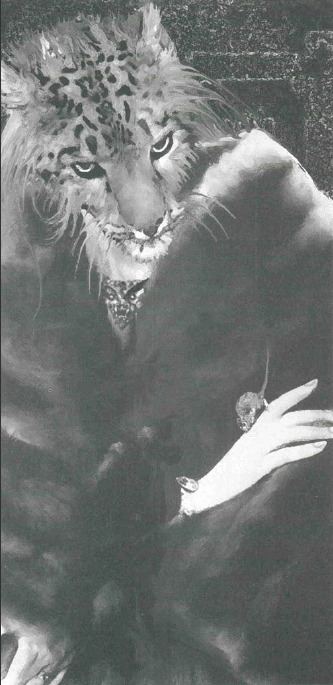
Oh yeah, Mom used to watch this. Ron Perlman was in it.
Looking at what Attentions can do, it seems Immortal is like Vampire insofar as you have a bunch of potentially very, very powerful supernatural people who could turn the President into a newt on live TV if they wanted to. And yeah, there are rules against it and probably security measures in place and plans within plans, wheels within wheels, for each action there is an equal and opposite blah blah blah--but it’s actually really hard to run a game where the characters have vast cosmic power but don’t use it because of mutually assured destruction mechanisms that aren’t immediately obvious.
That's it for serenades! Enjoy more magic word salad.
Menga : An ethnic division of the Magdalen, founded in Carthage. They invented voodoo!
Morpheum : The mortal dream-realm where the Sanguinary lives, and where its minions warp human minds. The Morpheum is described as an "organic cyber-like environment" with the Sanguinary imprinted on it like a computer program.
Morrigan : A pride who developed from birds, descended from the Lightning Man. Again, how immortals "descend" from one another is confusing. Their mantle is a kickass floating city called Magonia. Currently the Scepter Pride.
Mother Fatal : Nickname for the Rukshasa, and for the colostrum she generates.
Motifs : A number of paths of enlightenment among immortals, each based on looking at the universe from a particular perspective. One example is the ember motif, which "perceives the universe from the standpoint of fire, and how it relates to the cosmos." Another poorly-explained vague idea that won't be important anywhere else.
Namstar : Name given to the Lash when it supposedly appeared briefly on Earth in the time of Babylon.
Neverness : Immortal concept of heaven, a state of oblivion.
Nexus : The bond of loyalty that scions have to their savant (the immortal who created them).
Nimrod : A pride led by the Horned Lord. They created the Silence and were responsible for imprisoning the other prides in Sheol. The Horned Lord was overthrown by Semiramis, escaped assassination and formed the Phoenix pride.
Nivalea : A mantle city hidden in Antarctica, the headquarters of the immortal crime syndicate, D'arcade. The conundrum that created it was cut into shards so that it can manifest all over the world.
Odyssey : A drug which causes loss of short-term memory, so that you can experience a pleasurable "new" sensation over and over again.
Opening Night : Initiation into a calling.
Orenda : The Grey Ally that transforms matter.
Outlanders : Elder immortals who, like the Jury live outside of Perpetual Society because they're so powerful their presence on Earth is easy for the Sanguinary to detect.
Palladium : An object that naturally accrues immaculum. Most of them are bits of sap from the Sunedrion. They're rare and valuable because they can cure wounds that normally take centures for an immortal to heal, like poison.
Panacea : Immortals' ability to heal extremely quickly unless they're wounded while an attacker's halo is in close proximity.
Pandect : The immortals' body of laws.
Pantheon : When an immortal forms a family unit with his scions. Forbidden.
Paradigm : Leader of a calling.
Paragon : Leader of a pride.
Peer Ranks : Livery that indicates your rank within your pride.
Peri : A pride descended from Morrigan who entered the maelstrom and merged with Primals. Their himsatis are stone or metal weapons, which they can shapeshift.
The Perishing : The mass extinction caused when the Sanguinary crashed into the earth.
Perpetual Society : The organized society of immortal prides.
Phoenix : A pride created by the Horned Lord when he escaped assassination by his fellow Nimrod. He created a number of scions, who inexplicably became full-fledged immortals--probably because the Horned Lord is so old and powerful, and because he was high as shit on palladium at the time.
Primals : Elder immortals created from elemental forces. They are mostly estranged from the prides.
Prodigy : A mortal who can play serenades.

Nowhere in this chapter does it explain what wolves have to do with magic.
Quiet Culture : Mortal believers who serve the immortals. They usually live in and maintain mantles, and immortals use them as pawns against the Apocrypha.
Ra : Paragon of the Banjax.
Radio Eternity : A magic broadcast frequency created by solitaires (immortals outside the prides) and sent into mortal dreams. It tries to warn immortals still in lethe of the Perpetual Society's plans for them, and is thus outlawed.
The Rapture : Immortal concept of the end of the world, a final battle with the Sanguinary. The Sanguinary's will attempt to take the conundrum shards from every immortal's brain so that it can regain its original form.
Red Shard : A large shard of conundrum which once contained the Sanguinary's consciousness. When this was destroyed, the Sanguinary fled into mortal dreams.
Regalia : A conundrum shard used to capture the personality of an immortal, who can remanifest in anyone wearing the regalia.
Relics : Magic items used by immortals, all artifacts from the Shouting War.
Religarum : The ability of mortal minds to force immortals to physically and mentally transform to match the mortal's superstitious beliefs. Can be used unconsciously or deliberately.
Rephaim : One of the three types of Abzulim. The Rephaim were warriors.
Reverie : A successful mission in the Morpheum.
Rialla : Lavish, fantastical parties, invented by the Magdalen. The idea is to create a hallucinatory environment that generates immaculum.
Rime : The first manifestation of the Sanguinary, which appeared in 300,000 BC and immediately started gathering conundrum shards together. Destroyed in 71,000 BC.
Roane : A pride with marine animal himsatis, created by the Leviathan. They were once the Scepter Pride, but have since fallen and removed themselves from Perpetual Society.
Rooks : Members of a pride who have no calling.
Rukshasa : One of the Trine, entities summoned from the Crucible by the Anopheles. Now poisoned, she is now a blind, mindless hulk that does nothing but consume immaculum and generate colostrum.
Runegun : A relic from the Shouting War, weapons that fire serenade-infused projectiles.
Samiel : The Abzulim who created the Anopheles. He successfully entered the Crucible and returned raving mad. After death, his brain was found to contain "solidified abaddon" which created the Darkle.
Sanguinary : An evil intelligence exiled from the Crucible. Conundrum are the shattered pieces of its body. It wants to destroy immortals and regather conundrum to form a body it can inhabit and regain its former powers.
Savant : An immortal who creates a scion.
Schism : The struggle between avatars for control of an immortal's body.
Scion : A childlike being created when an immortal sheds a taboo by incarnating it into the form of a human-appearing entity. They only live for a few decades.
Sconces : Impenetrable fortresses in the dominions. Many believe that the Outlanders live there.
Scourges : Calling of immortals who punish immortals for breaking their pride's rules and enact vendetta on other prides.
Secret Arrow : An attention which channels immaculum into a destructive ray. It was used to assassinate Sharakai.
Secrets : Serenades only used by particular prides.
Serenades : An immortal using their voice to imitate a cosmic vibration of the universe, in order to warp reality.
Shallows : Places where the Blue Air intrudes into Earth, so gossamers can perceive and enter the world. Mortals perceive these as ghost hauntings.
Shattering : When the Anopheles destroyed the Malice Shard, foiling the Sanguinary's plans to reincarnate itself. Unfortunatley, this also destroyed the Sunedrion.
Sheol : A desolate dominion formed around the place where the Sanguinary impacted the earth, where it first hatched its plans to reform itself and where the Anopheles defeated it and destroyed the Malice Shard. The Nimrod rediscovered it millennia later, and imprisoned the other prides there to end the Shouting War and preserve the Silence.
Shouting War : A ten-thousand year war in the dominions, in which immortals used serenades and slaughtered each other indiscriminately. The Shouting War created the Lash, and only ended when the Nimrod imprisoned the other prides in Sheol. After their escape, the stratagem was created to prevent another war.
The Silence : A law against immortals using serenades on one another on Earth, because it creates a ripple which the Sanguinary can sense. The law was created by the Nimrod in negotiation with Solitaire, to whom they entrusted the Darkle in exchange for the recognition of the law.
Silhouette : The current avatar of the Sanguinary in the physical world; it uses its powers to create natural disasters.
Sin-Eaters : Mysterious Magdalen who are rumoured to have the power to destroy taboos.
Sin : The act of taking immaculum from unwilling immortals.
Slayer : Calling of immortals who kill minions of the Sanguinary.
Sleeper : Calling of immortals who attack the Sanguinary in mortal dreams.
Solitaire : A legendary Primal immortal who founded the city of Atlantis as safe haven for immortals of all prides to live together peacefully. He was assassinated during the fall of the city, and immortals who reject the Perpetual Society call themselves "solitaires" out of respect for her.
Solitaires : Immortals who reject the stratagem out of the belief that it's all a long con by the Sanguinary.
Sphinx : A Primal who appeared in 2750 BC and was killed by the Banjax. The true "riddle of the Sphinx" remains to this day.
Spill : A flood of immaculum from a slain immortal.
Splintering : When the Sanguinary emerged from the Crucible and shattered into conundrum shards.
Stratagem : The political laws of the immortals, which state that immortal-on-immortal violence is to be avoided at all costs; instead, they have a complex system of gaining "visage" by exposing mistakes and weaknesses in other prides. The Stratagem is based on the principle of "iron is sharpened with iron" to prepare for the battle with the Sanguinary without murdering each other.
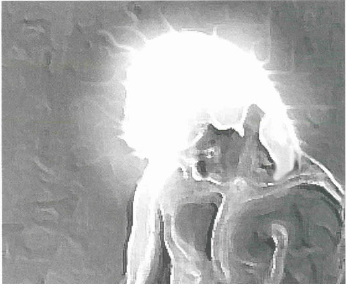
He goes through a lot of Brylcreem.
Next time, on Immortal : A chapter entitled "World." Oh, joy.
The world owes you nothing. It was here first.
Original SA post
Immortal: The Invisible War, Part 13: The world owes you nothing. It was here first.
Like nearly everything else in the game, Immortal’s cosmology is intriguing but confusing. The “creation myth” of the setting is that a powerful alien entity called the Sanguinary emerged from the Crucible--the mysterious and impenetrable source of all creation--and crashed into the Earth, shattering into many fragments which would eventually transform plants, animals, and even inanimate matter into sentient immortals.
Up to this point, it’s been heavily implied, but not stated clearly, that the different parallel dimensions that make up the Immortal setting were once part of a single world but that the Sanguinary’s crash-landing set off a chain of events that divided it into separate, but overlapping realms. In this regard, Immortal’s cosmology is very Norse, with a World Tree connecting the different realms of creation and showing their relation to one another. Immortal could really benefit from artwork that illustrates such a model, but no such luck. (In fact, Immortal’s cosmology does feature a World Tree, but it was destroyed and turned into something else. However, it still links the realms together.)
This is what I find confusing: like primitive peoples, Immortal’s idea of the “world” is very focused on planet Earth, the teensy-tiny speck of the material universe where human beings can breathe air and drink beer and watch “Big Bang Theory.” The Crucible is implied to be somewhere in outer space, which only makes sense if the Sanguinary came out of There and crashed into Here, but we’re not told where the Crucible is located in relation to earth. By the way, if you read DC comics, the Crucible seems to be basically identical to what they call “The Source.”
Immortals divide the known universe into 11 separate realms as follows:
The Habitat : Immortals use the term “Habitat” to refer to the world as mortal humans know it. (In fact, it’s been using it throughout the book, but I couldn’t bring myself to say “The Habitat” instead of “Earth.”) To immortals, the world is a double-edged sword--they’re fascinated by the relatively brief, intense, and passionate lives mortals lead and the constant evolution of mortal culture, but the downside is that mortals change their environment faster than immortals can comprehend. Besides the way mortals are constantly replacing older structures with newer and more utilitarian ones, immortals are very vulnerable to pollution, since one of their particular weaknesses is an inability to metabolize toxins. Soaring as an eagle doesn’t sound so majestic when the ground you land on is covered in DDT. The prides are actually using their cultists to advocate for environmental protection.
There are a lot of immortals concentrated in North America, for two reasons: first, many immortals fled to the Americas to escape the rise of the Apocrypha in 28,000 BC (near the beginning of the Upper Paleolithic era). Second, many immortals in lethe, living their lives as mortals, came to America for the same reasons as everybody else in the 18th and 19th centuries. In Europe, the Apocrypha is still very powerful, and immortals focus on protecting old sites of mystic power while escaping their notice. In East Asia, the Dracul and Anopheles struggle for power, while the Nimrod have a monopoly of influence in Russia. The Middle East is under the control of Primals, who don’t allow other immortals to get up to funny business on their turf and don’t tolerate the droves or the Apocrypha at all. The Terat control the vast expanses of undisturbed wilderness remaining in Africa, although the Morrigan sometimes park their floating city over Kilimanjaro. Australia is a strange exception--the barrier between worlds is weaker there, and it’s a crossing-point between the Habitat and the Dominions. When the Perpetual Society decides to levy the most extreme punishment on an immortal--exile to the dominions--they haul them out to Australia.

When this game promises you a world of blue air and floating dirt, it doesn’t fuck around.
The Blue Air : The Blue Air is an eternally expansive, ethereal atmosphere which extends around and between the other realms, or at least the dominions. If an immortal “dies” they become a gossamer, a drifting spirit in the Blue Air. The Blue Air responds to emotion and generates illusions, but aside from drifting chunks of earth, rock, and vegetation that break off from the other realms, there’s nothing of material substance in the Blue Air, and it’s ultimately empty. The Blue Air extends into the other realms in places called “Shallows” where immortals can see from realm to realm, and gossamers can interact with the material world, trying to gain enough immaculum to reincorporate themselves. Because the Blue Air responds to emotional resonance and transcends time as well as space, the Shallows create what mortals would call “hauntings.”

It all makes sense now! Immortal’s setting is supposed to be experienced under a blacklight while you’re tripping balls.
The Dominions : The Dominions were once part of the same world as the Habitat, linked together by a vast sentient forest called the Sunedrion, which reached from the inhabited world to the Crucible itself. When the Sanguinary first tried to restore itself, its minions destroyed Sunedrion trees for their sap to create the Malice Shard, a cocoon in which the Sanguinary could be reborn. The Anopheles destroyed the Malice Shard in 400,000 BC, but the resulting cataclysm separated the Habitat from the Dominions.
The separate existence of the dominions actually triggered a golden age of exploration for immortals, who found their life’s purpose in reclaiming what had been lost. However, this eventually resulted in the Shouting War and the psychic plague called the Lash, and the surviving immortals fled to the Habitat en masse.
Although a few immortals have been there and returned, the overall state of the Dominions is essentially unknown. It’s said that there are many separate Dominions, containing jungles, deserts, and vast oceans, but all of them are wild and dangerous. They’re also still infested with manes, immortals who succumbed to the Lash and became bloodthirsty, psychotic monsters. The Jury are so powerful that they live in the Dominions, but forbid other immortals from traveling there. Most immortals would never dream of going there anyway, although there are lost immortal cities and treasures waiting to be discovered. Some of the prides occasionally launch covert scouting missions for exactly that reason.
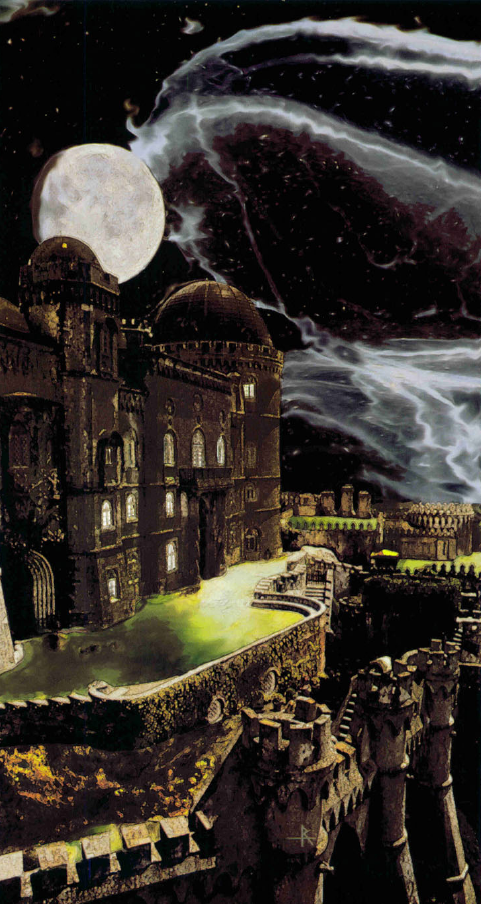
This is what Albert Speer would’ve built if the Nazis had won.
The Mantles : When immortals began to live among mortals in Atlantis, they discovered that by a very rare trick of chance, mortals and immortals could interbreed, producing children called trysts. Trysts aren’t immortal, but live much longer than mortals, and are capable of producing and maintaining pocket dimensions called mantles, which take their environmental characteristics from the tryst’s imagination. Trysts can’t maintain their mantle without intense training and the transplant of an immortal’s vox, and when they do eventually die or go senile after a few centuries, their vox is removed and passed on to a successor who is intensely trained to limit deviations from the original pattern. Perhaps most trysts are happy living for centuries in a fantasyland of their own design, but it’s a pretty creepy system of exploitation.
Most mantles are designed to embody an era of history--the late Cretaceous, ancient Egypt, the Baroque era in France, the American Old West--and keep it in relative stasis. There are even entirely fanciful mantles showcasing dystopian cyberpunk futures or sword-and-sorcery prehistories. Magic and Weird Science produced by a mantle don’t work outside of it. There are renegade trysts who somehow escape being controlled by a pride, but most of them can’t create a stable mantle. Some of them instead manifest the ability to warp their local reality--these trysts tend to wander around leaving a trail of destruction of their wake. Even worse, the droves use half-trained trysts to create unstable worlds to use as headquarters.
Mantle entrances can be constructed out of anywhere--the proverbial wardrobe, a closet door, a sacred grove, a mirror, etc. This makes it very very hard to attack and conquer a mantle, and they can take centuries to besiege and infiltrate.
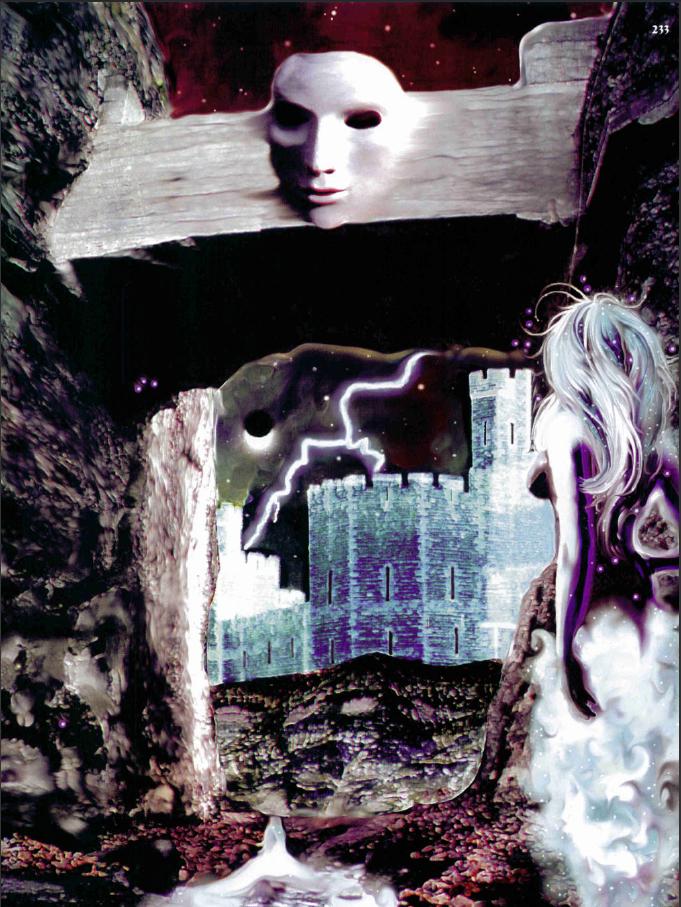
I didn’t know Neil Gaiman had epilepsy.
The Morpheum : The morpheum is a hallucinatory realm created by the collective unconscious of the human race. Immortals often think of it as a biological computer mainframe made up of many connected brains. (The Internet wasn’t really a thing yet in 1993.) When the Sanguinary’s last avatar was destroyed in 1666, it retreated into the mortal dream-realm as a last-ditch effort to save itself. It tries to slowly subvert the collective unconscious of humanity so that it can manifest itself again. The Apocrypha are open to its influence, but the rest of humanity is protected by the increasing belief in science and secularism.
Mortals enter the Morpheum whenever they enter REM sleep--people believe that their dreams happen entirely within their own mind, but all dreams are in fact taking place on one big landscape. Somewhere in this landscape is the Hush-Hush, the Sanguinary’s stronghold, fortified with terrifying nightmares.
Immortals don’t dream unless they choose to do so, which is good for them. When an immortal dreams, the Sanguinary and its minions sense it immediately, and try to corrupt the dreamer. This is how the Sanguinary creates droves, immortal minions under its control. If an immortal winds up in direct mental combat with the Sanguinary, they’re fucked, but most immortals are safe because they aren’t worth the energy expenditure required for the Sanguinary to possess them directly. The Sanguinary possessing a very powerful immortal is extremely rare; it’s how the Sanguinary has been able to create its handful of avatars over millions and millions of years--the Rime, the Dust, and currently, the Silhouette. Dreaming is still a temptation for immortals because it’s like the best heroin ever--the conundrum in their brains is stimulated by proximity to the Sanguinary. This dream-trance is how the Sanguinary maintains control over its drove minions. Immortals of the Sleeper calling have Attentions that allow them to enter dreams safely on missions against the Sanguinary, but the game is really, really sketchy on what you can actually do to hurt the Sanguinary in the Morpheum.
The Morpheum looks like a distorted mirror image of the world--the basic structure is the same, but a given place may seem like a magnificent palace or a gloomy prison depending on the emotional resonance it has with the dreamer.

Weinstein on the Beach
Sheol : This place began as a sort of Anti-Garden of Eden, the place where the Sanguinary first entered the universe. In the beginning of immortal civilization, the Sanguinary made Sheol a “darkly beautiful” place in order to attract immortals so that it could recreate its body. Its first avatar, the Rime, used Sheol as a headquarters to build the Malice Shard. Even after it was destroyed, Sheol survived as a realm filled with the forests of Zugog, a dark, light-devouring anti-Sunedrion.
The Nimrod ended the Shouting War by rounding up the other prides and imprisoning them in Sheol for thousands of years. During this time, Sheol was a world of endless horror where droves terrorized the immortals for thousands of years. Since the immortals escaped Sheol, it’s become the nigh-impenetrable fortress of the Sanguinary’s minions. Only the Phoenix are brave enough to return to Sheol for brief raids against the droves.
The Underworld : Immortal’s setting features a “Hollow Earth” of sorts, in a worldwide network of underground caverns and seas which immortals call the Underworld. It can be considered a separate realm from the Habitat because it’s virtually uninhabited by humans, and so immortals don’t have to maintain the Silence. They do, however, have to worry about the droves that infest the place. Only the Terat, the Peri, and scattered groups of solitaires can maintain a presence in the area. Entrances are scattered around the world, including such landmarks as Mammoth Cave and Carlsbad Caverns.
Very very deep in the Underworld is a large conundrum called the Blue Emerald, which supposedly broke completely from the Sanguinary’s control and led a war to destroy all conundrum so that it could never reform itself. The Peri believe that “she” is a liar and wage war against the renegade prides that serve her.
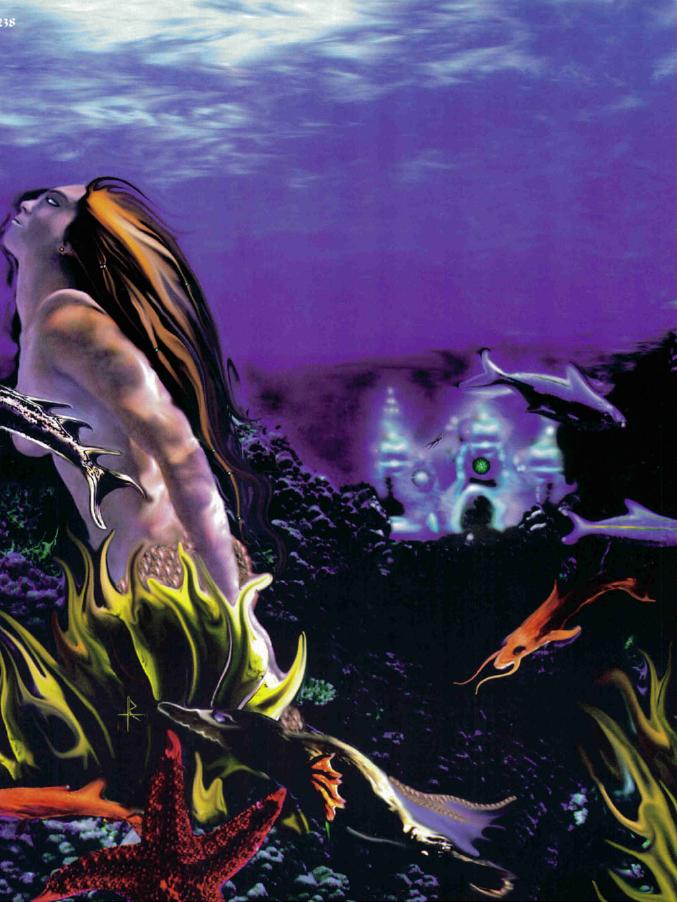
The Little Mermaid, by Hans Kenneth Kesey
Ys : Immortals also consider the lightless depths of the deepest oceans a separate realm from the mortal Habitat. As in the Underworld and the Dominions, immortals have built fantastical cities in ocean depths where humans can’t survive. It says that when the Sanguinary crashed into Earth, it hit the ocean near the Yucatan peninsula, so there may be many conundrum shards in the deep oceans. (I have no idea how this does or doesn’t conflict with Sheol being the place where the Sanguinary first came into our universe.)
Immortals explore and wage war in Ys using enormous magical submarines called lighters, and Ys contains legendary cities such as Avalon and Tir na Nog. These places are increasingly isolated because they’re afraid of the Leviathan, a gigantic sea serpent and only one of the Trine that remains alive, sentient, and free. The Leviathan swims through the ocean depths served by its (immortal?) followers called the Roane, doing who-knows-what for reasons only it understands.
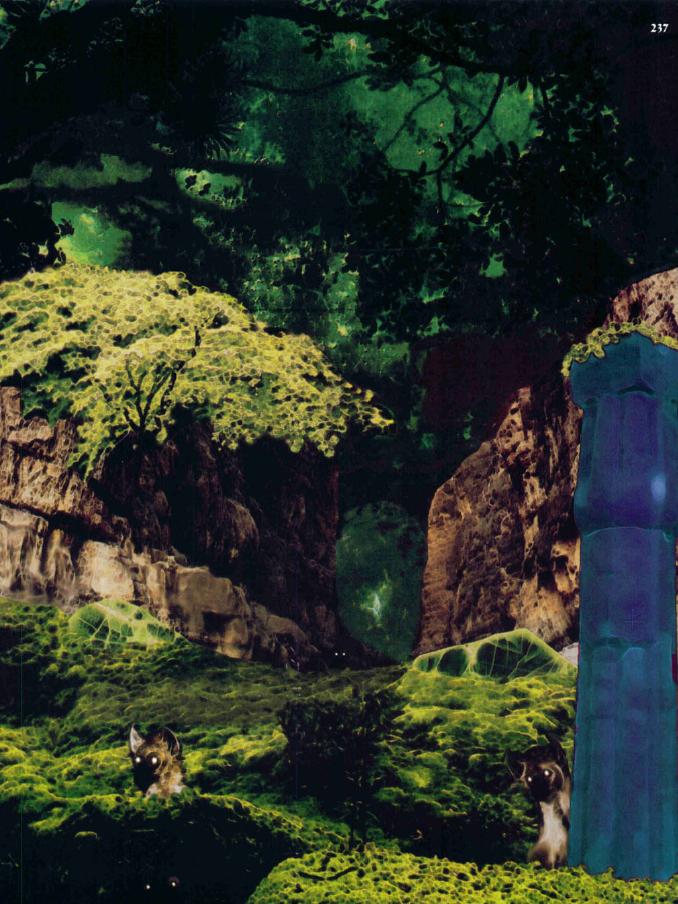
Oh. Hi.
The Sunedrion : The Sunedrion was once the glue that held the world together, but now it’s been reduced to a few hidden groves planted and protected by pride Tautha. When you’re in one, you can sense that your surroundings are very much alive and watching you. The Tautha record as much of the lore of the Sunedrion as they can, and believe that it’s the key to being truly immortal and free from the Sanguinary’s influence forever. The Phoenix are capable of sensing Sunedrion amber and use it for healing, but the Tautha believe in hoarding it away and preserving it.
Sunedrion forests are practically gardens of eternal life--their sap can heal immortal wounds, their leaves provide nourishment, animals live there without fear, they can grow underground and without sunlight, and they repel the Sanguinary’s influence.
[Ed. note: Illustration of the location most in need of clarification: not in this publication. ]
The Crucible : The Crucible is the linchpin of the universe; it’s the source of the forces of time and entropy and the immaculum that allows life to exist. The book is very, very, very confusing about where the Crucible is located: Immortals perceive the Crucible as a sphere surrounding the Earth, but the Sanguinary was exiled from its “depths” and earlier we were told that the Sunedrion’s roots reach into the Crucible. This is kinda-sorta explained when the book reads “because its dimensions and position are so difficult to ascertain, [immortals] feel that it lurks in the space around them.”
Despite being the source of all life, immortals are afraid of the Crucible. The Sanguinary and the Trine came from the Crucible, and it represents a higher power that they can’t hope to control, which is unsettling to beings who are used to impersonating gods in order to control mortals.
Many immortals’ attitudes toward the Crucible are basically religious--some believe it is the key to reaching a restful oblivion, fewer believe it contains some kind of heaven. Some of the latter even believe that the Trine brought “Empyrean fragments” of this heaven with them when they came, and that they might be regathered.
Any way you slice it, the Crucible is a confusing setting device and it isn’t a “location” where you can have adventures. Moving on!
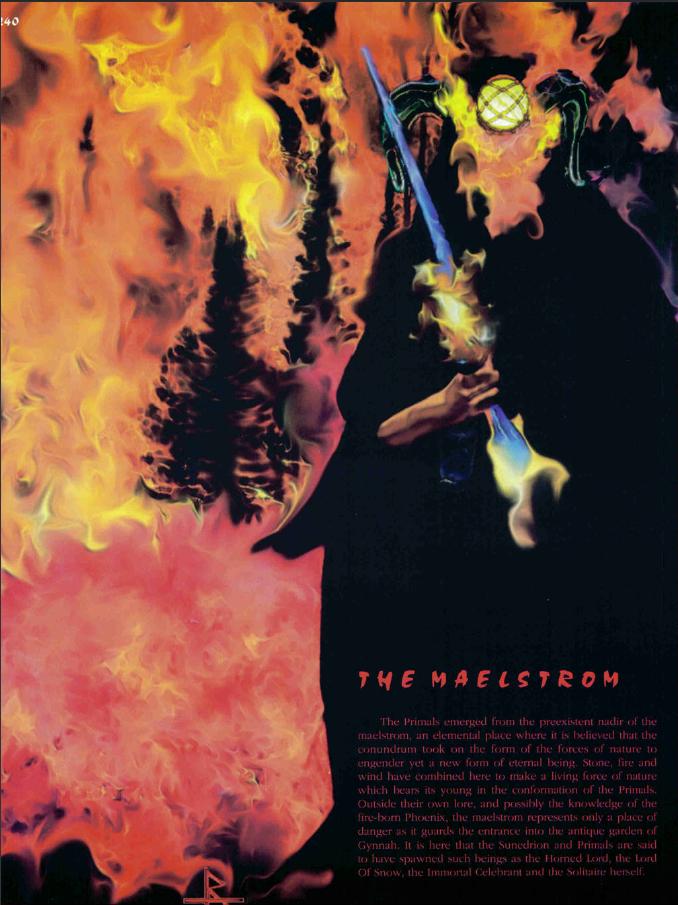
Boy oh boy Mom is gonna hate this
The Maelstrom : The maelstrom is a chaotic plane of shifting energies where conundrum fragments merged with elemental forces to create the Primals--primordial, powerful immortals with himsatis of stone, fire, air, light, and so on. Like the Crucible, the Maelstrom isn’t a place that player characters can visit. It’s only important to the setting background because it’s the source of some of the most powerful NPCs in immortal history, like Solitaire, the Horned Lord, and the Celebrant.
In this chapter, Immortal’s setting was thankfully too deep in its own butthole to give us more glossary terms.
Next time, on Immortal : “The Production,” or, GMing advice. I just keep telling myself that whatever lies ahead, it can’t be as pretentious as Everlasting.
The Production!
Original SA post
Immortal: The Invisible War, Part 13: The Production!

I’m a moldy kitchen tile pattern, and I approve this production.
Unfortunately for all of us, Immortal’s guide-to-gamemastering section is not nearly as full of itself as, say, Everlasting. It also doesn’t give godawful advice on fucking over your players. As I should have predicted, it’s like the other chapters-- confused , and full of poorly-realized notes on setting elements that are so scatterbrained, you’ll have to practically recreate the world yourself.
The chapter opens with a few short paragraphs declaring that “the immortal experience is for everyone” and that the setting “is a place where the sword, gun, and computer all have their place.” In other words, you can set just about any kind of genre story in the Immortal setting. No one told them that if anything is possible, nothing is interesting.
Immortal’s advice is hard to follow because it’s written using phrases like “terms of the experience” and “method of conducting an episode” instead of talking about plot and setting. The first section is on “Approaches” which, as we learn from context, just means “part of the universe you’re using as the setting for your game.”
Approach 1 - The Mantles : Setting a game in the pocket dimensions of the mantles means that you can effectively have a game in a fantasy version of ancient Egypt, Tolkienesque Noteurope, a grim cyberpunk dystopia, or whatever you want.
Approach 2 - The Modern World : The characters are secretly supernatural people fighting clandestine wars in a mundane-seeming modern world? Yeah, that’s probably what you and everyone else expected from this game.
Approach 3 - The Flashbacks : Immortal suggests setting game sessions entirely within the characters’ memories. Admittedly, this actually works in Immortal since they literally can’t die. (Of course, immortals’ past lives are completely different personalities, so none of your character’s background necessarily matters.) It’s even suggested that you set the entire campaign within the context of memory flashbacks, in case you want your game to only represent the silliest parts of an episode of Highlander .
Approach 4 - Timekeeper : Hey, maybe the party could travel through time! Distant past, or far future? What happens if they change history, or correct a fatal mistake? We don’t know! No, there isn’t anything in the rules about immortals traveling through time! This is all the advice we’re going to give you!
Approach 5 - Sleepwalk : Immortals fight the Sanguinary in the Morpheum, so entire sessions or an entire campaign could be set mostly in the world of dreams, where everything’s possible. What’s it like in there? We don’t know. Make something up.
Approach 6 - Badlands : The dominions are really dangerous. They’re full of monsters, specifically, immortals who have turned into vampiric maniacs. On the other hand, the dominions are full of powerful secrets and artifacts left over from the Shouting War. Since the dominions are only useful to the Perpetual Society as a place to exile criminals, you could totally do a postapocalyptic Escape from New York style campaign here.
Approach 7 - Hauntings : Do you want to play as a drifting, immaterial ghost that can’t affect or be affected by anything in the material world? No? Yeah, it’s a stupid idea. But if you did want to do that, playing ghosts drifting through the Blue Air would allow you to explore mysterious places and entire civilizations. What are they? We don’t know! Make something up.
Approach 8 - Suboceana : Remember how the last chapter mentioned that immortals consider the deepest ocean a separate realm called Ys, and they have some sort of magic submarines to move around down there? You could totally set a game there, if you’re willing to do all the work yourself.

I’ll see you in hell. Or Zoobilee Zoo.
Yeah, so Immortal summarizes each of its suggestions for the milieu of your game with totally obvious and unhelpful statements along the lines of “Rememberthat a mantle is a totally different world,” “Time travel is tricky,” and “the dominions are dangerous” without providing any guidance on how to detail settings like a parallel dimension, a fantasy world that never was, or the realm of dreams and nightmares. It also doesn’t address any questions I have about immortals’ place in the modern world...things along the lines of “Why haven’t ancient superhuman warriors fighting a secret battle amongst themselves laid the world to waste, or even been discovered?”
The book immediately jumps into a glossary of “concepts” related to gamemastering without any introduction or explanation. This does include terms like “scene” and “session,” but also includes things that aren’t going to be jargon used in play, but pointless labels to give you ideas. For example, “script” meaning the GM’s notes, “rules guide” meaning the corebook and any supplements you happen to be currently using, “multi-media” because the idea of playing music and reading text was a revolutionary idea in 1993, and so on.
The most amusing pointless term is “Series guide.” Immortal uses “series” to mean campaign, and a Series Guide is “A large collection of documentary material related to a single broad subject (such as a period in immortal history, a particular pride of immortals, etc.) sufficient to guide a narrator through the self-creation and subsequent enactment of a variety of series related to the subject material. A large number of immortal series guides will be made available to assist narrators with documentary material across a wide range of subject areas.”
Let me tell you, buddy, Immortal easily tops Dune: Chronicles of the Imperium as a game where you really need supplements to even be able to understand the setting and play in it, but the game never got enough supplements.
The next section is “Elements of the Experience” which is a guide to going through all the trouble of LARPing without actually doing it.
On Location : Hey, what if you played in a park or a restaurant or a hotel or something, instead of your tiny nerd stink cave?
Wardrobe : You could dress like your character! Y’know, to “draw yourself deeper into the experience.” And not just clothes, but like, hair and makeup too! Or if you’re feeling really, really edgy, temporary tattoos . And cufflinks, even!
Lighting : Make your game more dramatic (and difficult to play) by using dimmed lighting, candlelight, coloured bulbs, or otherwise “dramatic lighting.” Remember, this is advice from the game that expects you to roll different colours of dice depending on what stat you’re testing.
Music : Immortals are “the ultimate connoisseurs of music” since they perceive the motion of the universe as music. You are seriously encouraged to pick theme music for characters. NPCs, too. There’s nothing more dramatic than playing a song when a particular recurring villain appears. Just ask the WWE. Fortunately, no specific kinds of music are suggested; I have a feeling that this game was written while under the influence of Pure Moods and Dead Can Dance.
Sound effects : Sound effects are evocative of...the sounds...of things. You can buy compilations of sound effects on this “compact disc” format I’ve heard about.
Remote controls (seriously) : If you have a stereo with a remote control, you have (I swear to God they wrote this) “a powerful tool in your hands that can increase the drama of your production.” Sound effects and theme music, on cue! Don’t tell Ran Ackels about those lights that come on and off when you snap your fingers; his head might explode from the sheer dramatic immersive evocative mythic storytelling experiential potential of it all.
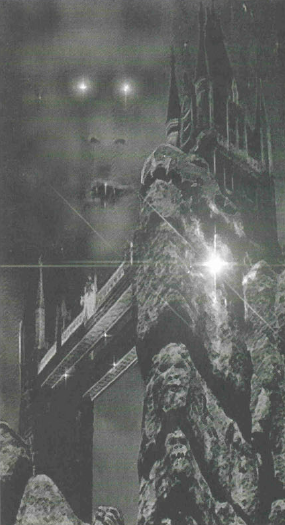
Hey, Ran Ackels! I’ve got a powerful tool in my hands for ya right here!
Immortal promises us that future products will always contain “scripts,” which are not scripts in a conventional sense but “stories with entrances and exits.” I’m guessing they mean “plot outline.”
We’re also encouraged to use magazine clippings, photographs, and thrift store tchotchkes to evoke the presence of NPCs in addition to describing their physical appearance, and encouraged to use home camcorders to create video footage to evoke the feeling of locations like the Himalayas. I’m not sure how my Virginian backyard is supposed to evoke the Himalayas. I also didn’t own a video camera in 1993. You’re also encouraged to pace around the room acting out characters’ body language (with a caveat against beating up anyone), dispense messages intended only for one player (ranging from passed notes to elaborate mailed packages), and having surprise “extras” join your gaming group just to guest-star as a character who won’t appear again. There’s no advice for what to do when your players change their phone numbers and mailing addresses and file restraining orders.
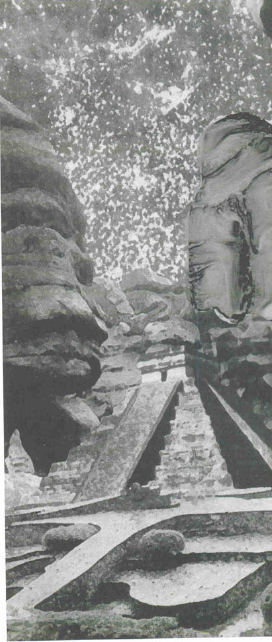
Mayan architecture was known for its warped perspective.
The first part of a good Immortal experience is creating a good setting. (Future supplements will showcase “detailed locales,” dear reader!) Your game’s setting should not become predictable, and should be filled with “nooks and crannies” where “anything can happen.” There is some good advice here about using a city as a starting point, and letting the supernatural elements lie underneath the normal--a city street might have been the site of numerous battles between immortals thousands of years ago, and everyday locations can contain entrances to mantles. Travel guides, brochures, and educational programming are recommended as ways to convincingly set adventures in locations around the world, which was probably good advice before the Internet was a thing of dudes.
The most important part of an Immortal campaign is well-acted characters. This brief section contains the best advice in the chapter. The first key to good characters is believable motivation. The second is having a variety of characters and bringing their differences to the forefront--gender, race, cultural heritage, and the differences in immortals whose mindset is stuck in the past. On the one hand, it goes overboard in encouraging the GM to bombastically act out NPCs and give them glaring character traits; on the other hand, it expressly discourages you from indulging in cliches, featuring a string of characters who can all be described with the same traits (like “brilliant but paranoid”), or from being afraid to create characters who don’t fundamentally believe and act as you do.
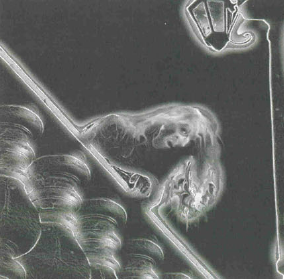
Melty Gelatin Ghost contemplates ending it all, again.
The next section is “Presentation” which seems to be advice on overall plotting. Again, the strange way Immortal groups different elements of its storytelling advice makes the whole thing feel unfocused and shaky. The advice is pretty decent, though. The first point is not to let balance get out of hand by giving characters a bunch of goodies, only to have to snatch them away later when they create problems. The second is not to have a predictable, linear plot; instead you’re encouraged to have more-or-less “false leads” which have the characters circling the plot but getting closer. The characters can proceed directly toward a goal, only to be thwarted, but find a new lead or gain something that will be useful later. Third, don’t get so carried away that you forget what you’ve already established in the setting and create plot holes. Fourth, don’t introduce deus ex machina plot devices into the plot, don’t force the players to solve a problem in a predetermined way, and don’t kill characters by unavoidable, unfair fiat. Fifth, introduce major antagonists first by reputation and rumour and build up to a worthy first appearance, instead of proudly displaying a bad guy and explaining to the players that he’s a Big Deal. Sixth, give each PC a chance to shine, and pay attention to what they want out of the game, since the person who wanted a romantic subplot isn’t going to be thrilled about the opportunity to be the one who kills the big bad guy. Seventh, describe, describe, describe. Finally, build your campaign to accommodate the players and what they want their characters to do, instead of wedging them into your big epic story.
I must say, for an early-90s modern fantasy game that’s all about story this and epic that, Immortal advises you to stay pretty fucking far away from the Gamemaster-as-Auteur-Director model for which people excoriated White Wolf.
The last section is on awarding experience points (memory), which is bog-standard for its time. Things like exceptional acting, being exceptionally entertaining, and events which lead to learning more about your immortal past can earn you one or two motes of memory. Visage is much harder and much more vaguely defined, since it’s an actual in-universe property and requires “counting coup” against other prides. There’s no system for it; it’s suggested that if the GM thinks that the feat was suitably daring, you can roll a die, and your visage increases if it’s higher than your current visage.
So, there you have it. Immortal has some surprisingly aware bits of GM advice which are unfortunately muddled by all the vague suggestions that maybe you should bury your game session under a deluge of overacting and cheesy LARP props. Also, for a game that can take place almost entirely in a number of fantasy realms, it’s surprisingly bare of the details you need to know how to flesh them out and set adventures in them. That’s assuming you would ever want to do such a thing. Immortal is already a game where you play a person who is secretly an animal that merged with a sentient alien artifact and became a superhuman immortal creature, assumed human form, and lived many mortal lives with totally different memories and appearances which you only remember in fragments. (Pant, pant.) Taking that premise and then setting the entire game in a magic submarine or a nightmarish alternate dimension is stacking a funny hat on top of another funny hat.
Next time, on Immortal : Purity and Taint.
Purity and Taint
Original SA post
Immortal: The Invisible War, Part 14: Purity and Taint
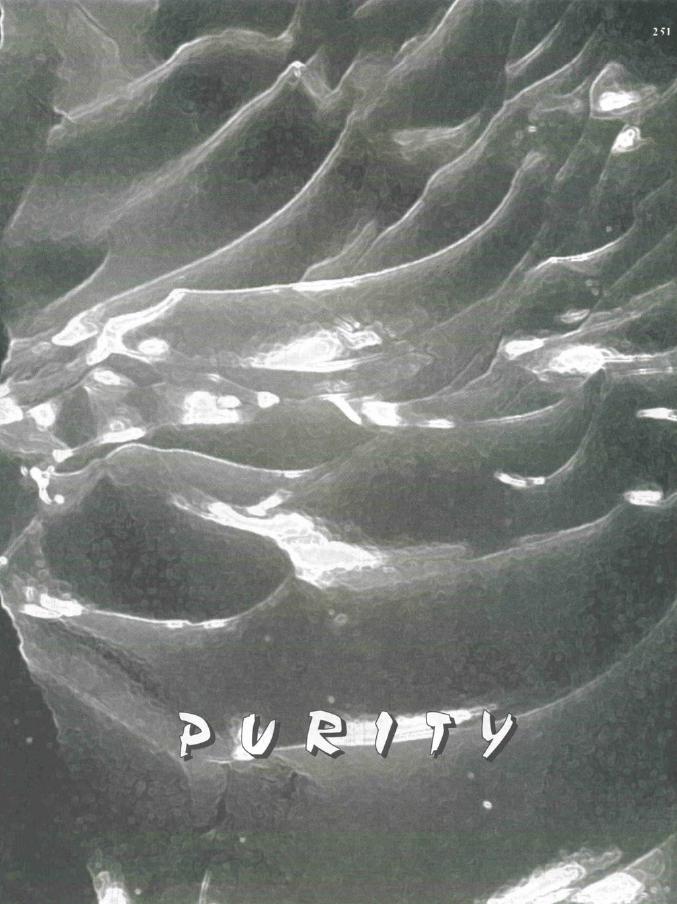
A mountain range. Velvet curtains. Pudding. A duck’s vagina. Things you associate with purity, I guess.
I drank a 32 oz. Monster Dub and 24 oz. of strong coffee and I’m done arguing about knights fighting mutants fighting robots fighting talking spiders fighting elves and it’s time to get back to that Immortal review. Hey, my forearms are twitching! So, immortals--they need to take immaculum from mortals in order to survive. Immortals don’t naturally consume immaculum, in the same way that Vampire characters use up Vitae just by existing. To recap, whenever you play a serenade and you roll a natural 1 on the d10, the serenade fails and one of your Characteristic motes becomes Tainted and unusable. Gathering immaculum is the only way to “cleanse” your aura. There are other sources of immaculum besides mortals, but they’re rare enough that there’s no economy in them.
If you can convince a mortal to give you immaculum of their own free will, great! Immortals call this “lullaby.” Take as much immaculum as you want, and afterward they go into a trance for minutes, hours, or days, depending on how drained they are--there’s no specific rules for this. When you drain immaculum, you’re actually draining points of their Characteristics, so I suppose they die or become crippled if you drain them down to zero--it doesn’t say. It does say that it can cause aging. Mortals don’t naturally regenerate immaculum, so they’re allowing you to permanently handicap them. They can get their immaculum back from those same miscellaneous sources that immortals can use, like panacea (Sunedrion sap) or some unexplained thing called a “tempest.”

brujahclanportrait.jpg
Stealing immaculum from mortals is called “Sinning” and requires you to make a roll with a difficulty based on how much you want to steal. Stealing 25% of their immaculum is a Rank 1 or Easy hostile (difficulty 3), stealing 50% is Hard, and so on. It doesn’t say what Characteristic+Talent to roll in order to steal immaculum--to figure that out, I had to refer back to the skills chapter, which lists a Wantonness skill that aids in Sinning. Apparently you use the Characteristic you’re targeting, which is both weird (I drain the mortal’s strength because I am a buff dude?) and implies that you have to make a separate roll for each Characteristic, which doesn’t make sense given that you can make a roll to steal half their immaculum in one go.
If you roll a 1 while Sinning, you get slammed with psychic backlash that saddles you with a Taboo, a supernatural curse. Fucking up a Rank 1 roll will net you a Rank 1 Taboo, and so on. (If you’re familiar with Mage: the Ascension, it’s like getting saddled with a Paradox Flaw.)
Skipping ahead, there’s a d100 table for each rank of taboo. I’m not going to list or copypaste them all, but here are some notable examples of each rank:
Rank 1
--You can’t cross a threshold without knocking.
--Your eyes glow when you feel strong emotions.
--You glow in the moonlight.
--You cast no reflection.
--Weapons dull when you hold them (-1 damage)
--In your presence, audio equipments plays/records broadcasts from decades ago.
--Your skin looks normal, but feels like fur, scales, bark, etc.
(Most of these are Mary-Sueish special effects, yeah.)
Rank 2
--You become allergic to a specific substance and take damage if you touch it.
--In direct sunlight, your shadow burns into surfaces.
--You carry a computer virus like a plague, and spread it to any computer you use.
--Your voice becomes totally at odds to your appearance (wrong age, gender, etc.)
--You can’t tell a direct lie.
Rank 3
--Mortals see you as a dead loved one.
--You can’t leave a room while someone is looking directly at you.
--Characters on television talk to you.
--Your touch robs inanimate objects of their beauty.
--You can’t do bodily harm to someone if you don’t know their name.
Rank 4
--Your imagination begins to warp reality in slight, inconvenient ways.
--Everything you say manifests itself as nearby graffiti.
--You transform into a different form and can only be turned back by something specific (kiss from a prince, light of the full moon, etc.)
--When cut, you bleed swarming insects.
--Everyone you love inexplicably becomes a magnet for danger.
Rank 5
--When you use a phone, your enemies’ phones ring, and they can hear your conversations.
--Anyone you kill returns as a vengeful zombie.
--Plague (or famine, or crime) follows in your wake.
--You believe any lie told to you.
--Mortals become so fascinated with you they’ll kill to be near you.
There are plenty of straightforward boring ones like “Your hair turns white” and “You burn in the sunlight” but there are some very thoughtful ones, as you can see.

Sensitive Owl Man wants you to cleanse his taint.
How do you get rid of a Taboo? There’s only one way: the Splintering. An immortal can create a childlike clone of himself, called a Scion, that houses a Taboo. Scions never grow up, live for about 30 years, and are completely under the control of their creator--you can even make a simple roll to possess their body. They’re always under the effect of the taboo they carry, which dies with them, and their behaviour is usually erratic, probably because they have a shitty life and were only created to suffer the consequences of another’s mistake. If you ever manage to fuck up a roll to control them, they become free-willed.
Why don’t immortals just create a scion whenever they get hit by a Taboo? Aside from the ethical considerations, there are two reasons: One, it’s very illegal. Scions can pose a threat to immortals, and the droves create scions all the time. Second, you actually have to create the scion out of yourself by giving up motes of immaculum to create its characteristics. They require 12 motes (2 for each Characteristic) plus motes equal to the rank of the Taboo you’re shedding.
You can also splinter your avatars. I’m not sure why you would--I guess if one of your past lives was a real asshole, maybe you want to be rid of him, or maybe you think he’s so cool he’d be a useful ally. Splintering an avatar creates a full-fledged immortal, so it’s more expensive, and there are social issues related to how the actions of your splintered avatars reflect on you, and vice versa.

A vacation to the Allegory of the Cave.
There are other ways of gaining immaculum, in case you don’t want to take it from mortals, or are trying to do something expensive, like create a scion, that would cost you mad ridiculous experience points.
The Venery : You go on a spiritual journey within your own mind and do battle with one of your avatars--if you win, you gain a point of immaculum (as in, you can cleanse a tainted mote). If you lose, your avatar can attempt to take over your body.
The Slaying : There can be only One! If you kill another immortal--as in, crush their throat or cut off their head to destroy their vox--their free-floating immaculum will spill, and you can cancel an amount of Taint equal to their free motes. The droves do this all the time, but it’s not common in the Perpetual Society. Besides being super-illegal, you could get your ass kicked, and even if you win you might not gain enough for it to be worth the attempt.
Tempests : Rare and random storms of immaculum flowing from the Crucible to Earth. They’re unpredictable (except at the Narrator’s discretion) and can even turn mortals into immortals.
Riallas : Riallas are what immortals call mortal celebrations that encourage emotion and the appreciation of the strange and exciting--Halloween, Mardi Gras, Carnival, etcetera. This is basically Sinning, but with a reduced difficulty.
Colostrum : A fucking long time ago, the Anopheles summoned an entity called the Rukshasa out of the Crucible. Since then it’s become a bloated, nonsentient creature gorged on immaculum. It produces a substance called colostrum which is basically liquid immaculum, which can cure Taint. It’s also addictive; after three doses, no other method of curing Taint will work. Only palladium (Sunedrion sap, mostly controlled by the Phoenix) can cure colostrum addiction.
Immortals create “Arks” to store immaculum--you can use any of the above methods to gain immaculum you don’t actually need and store it in an Ark. An ark can be a literal treasure chest, a tree, even the trunk of a car. If you acquire Taint, you can go to your Ark and use the stored immaculum to cleanse yourself, and if you get killed, you can reform your body in your Ark, provided you have enough in the tank.
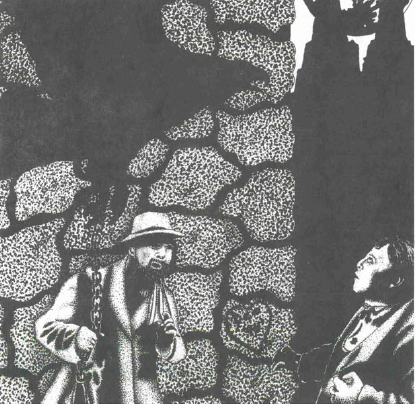
Edward Gorey’s drunk sketches.
Do you miss those ongoing glossary entries? Of course you do!
Submerge : When one avatar recedes in favour of letting another avatar control the body.
Sunedrion : A network of plants whose roots stretch into the Crucible. Originally a vast forest, now a “council” of singular trees known as wealds, revered by the Tautha pride. They are found in isolated locations such as the deep jungle and even Antarctica.
Superstitions : Another word for religarum.
Sussura : A mysterious entity, neither immortal nor natural. It memorized the ravings of the Abzulim Samiel after it traveled into the Crucible and back.
Taboos : Curses that result from stealing a mortal’s immaculum.
Next time, on Immortal : “Nivalea,” a sample adventure.
Nivalea, or, What To Do With This Mess
Original SA post
Immortal: The Invisible War, Part 15: Nivalea, or, What To Do With This Mess
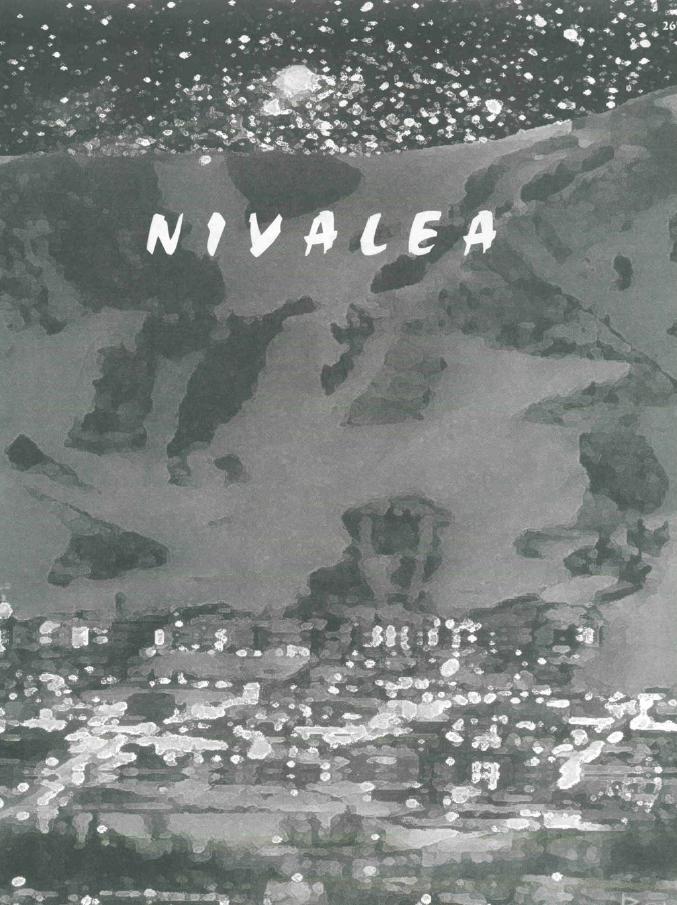
In the “southerly reaches of the Arctic Circle,” the Perpetual Society maintains a mantle that doesn’t belong to any one pride--Nivalea, also known as Infinity City. Within the mantle, the city is a many-leveled network of cavernous passages carved into an active volcano, which stands between two vast icy mountains. Every pride has a sort of embassy in Nivalea, and unlike most mantles, Nivalea preserves many cultural eras of Earth’s history--the Dark Age and Renaissance quarters are the most popular. Nivalea’s greatest importance is as a political capitol of the Perpetual Society, and as the last haven for the fragments of the immortals’ own culture that survived the exodus from the dominions. To hear some immortals tell it, the real power in Nivalea is D’arcade, the immortal crime syndicate.
(Nivalea is actually in Antarctica. The authors think the southern Arctic Circle is Antarctica.)
Now we are introduced to “The Cast!” I don’t know why these immortals are important.
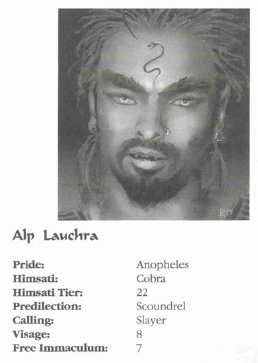
Didn’t I see this guy on Pirates of Dark Water?
Lauchra is a bigwig among the Anopheles, a “darkly tanned Negroid” with a cobra himsati. He is a cautious, methodical assassin and a general in service to the Cadra Raga, the three leaders of the Anopheles. He’s on the verge of increasing his Visage to 9, which will make him one of the most respected and influential immortals in the Perpetual Society.
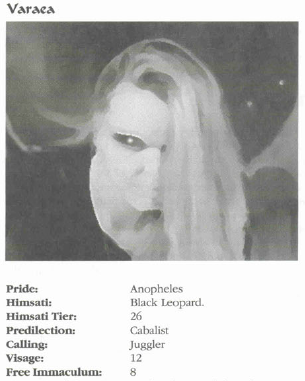
A velvet painting of Belinda Carlisle?
Varaea is one of the aforementioned Cadra Raga. She’s the least powerful of the three, and primarily executes the policy of the older two. She comes across as more human than they, making her an effective liaison. Her interpersonal style is to speak softly (and seductively) but carry a big stick. When traveling on Earth, she keeps her free immaculum low to avoid attracting attention. This is another peculiar example of the book talking about characters in terms of game mechanics.
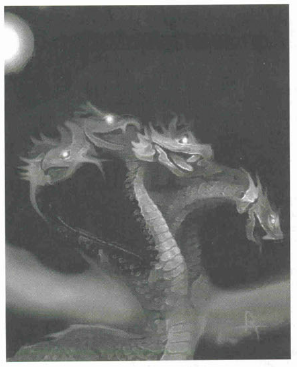
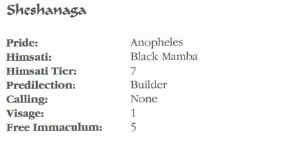
They turned him into the guy who beat up Godzilla. That’s nothing to sneeze at.
Sheshanga is an immortal who was captured by a Quiet Culture called the Nagas, who used religarum rituals to transform him into the image of an ancient many-headed serpentine god. Varaea freed him, then spread the rumour that he had information about the Banjax which would be useful to the Anopheles. Sheshanga is recuperating in Nivalea as a guest of the Anopheles, waiting for his body to heal and regain its original form. He’s under a powerful Taboo--he can only speak through his shadow, under the light of the moon.
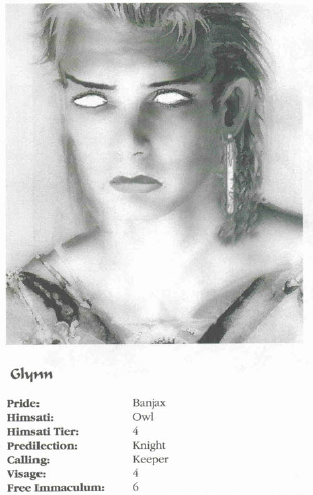
Banjax: Strongest, bravest, also the prettiest. Deal w/it.
Glynn is a Banjax agent tasked with “rescuing” Sheshanga. The goal of the mission is to embarrass the Anopheles, destroy their control of the Nagas through Sheshanga, and find out what it is Sheshanga knows about the Banjax. Glynn is a True Believer in her pride, and will approach the PCs to assist her mission, promising them protection and a share of the spoils after coup is counted. She’s completely unaware that Sheshanga is himself an Anophele and that Varaea is setting her up.
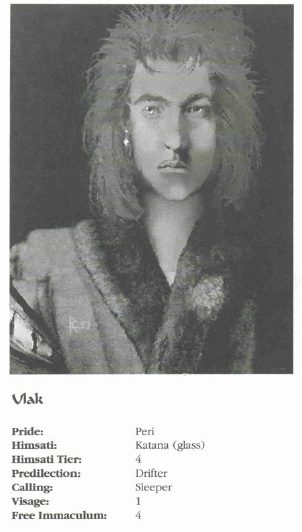
Bathrobe Goblins pinup calendar, 1986 edition
Ulak is a scrub Peri whose Visage is low because he doesn’t work well with others or tolerate authority. He remains a member of his pride because he’s unfailingly loyal and has conducted several successful missions against the Sanguinary’s minions in the Morpheum. In his himsati form, he appears to be a stone gargoyle with a row of glass katanas running down his back like spines
 Like all Peri, he can transform into a weapon; his is a glass-handled katana. The Anopheles are using him as a pawn; he thinks he can outsmart them. He’s wrong.
Like all Peri, he can transform into a weapon; his is a glass-handled katana. The Anopheles are using him as a pawn; he thinks he can outsmart them. He’s wrong.
The chapter explains that the action of the story will take place in three places: Nivalea, the Morpheum, and Earth. It goes on to explain that the progression of the adventure should go Prologue, Building the Story, Hook, Climax, and Epilogue, in case you were sleeping in your high school class on how stories work, but it doesn’t explain how that applies to this adventure specifically--yet.

You laugh because I’m different, I laugh because the inchworm in my nose really tickles.
Prologue : The setup is complicated and, I must admit, I’m impressed. Ulak has been spying on the PCs for Glynn. Glynn wants to recruit them into pride Banjax, if they can prove their worth and commitment by helping her mission. Ulak has secretly contacted the Anopheles to warn them about the attack--if his plan works, he’ll count coup on both the Banjax and the Anopheles, by fouling up the Banjax’s mission and by keeping the ingenues out of the Anopheles’ hands. It’s not personal; if he doesn’t manipulate them, someone else will, and either way the PCs won’t be coopted by the Sanguinary.
Part 2, Scene 1 : In the first scene, one of the PCs has a vision of Ulak in a dream. If he confronts him, Ulak will try to arrange a meeting; otherwise he leaves.
Part 2, Scene 2 : If the PC hasn’t talked to Ulak, all the PCs will have dreams of swirling faces, music, the screech of an owl, and remembrances of conversations about plotting to free a prisoner of war.
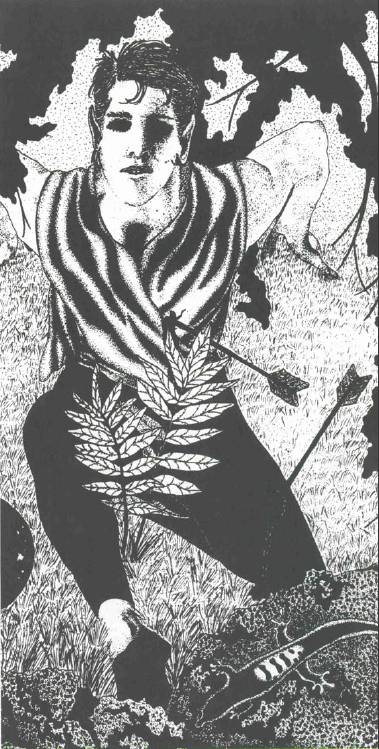
Fern-humpers will be shot. Survivors will be shot again.
Part 3, Scene 1 : Ulak and Glynn will approach the PCs to persuade (or kidnap) them to take them to Nivalea. The Nagas will spring an ambush, and Glynn will implore the PCs to follow her to safety. If they refuse, they might be overwhelmed by the human cultists, who will then try to recruit them to free Sheshanga for them.
Part 3, Scene 2 : Glynn and Ulak will reveal themselves to the PCs as immortal beings who have taken on human form to escape the tyrannical Anopheles. (It’s implied here and elsewhere that at this point, the PCs don’t know much about their own immortal nature and haven’t identified themselves with a pride yet, although such things are part of character creation.) They’ll try to sell the PCs a sob-story that Sheshanga is being mistreated by the Anopheles and resents the Anopheles using him to control “his” cult of followers.
Part 3, Scene 3 : Assuming the PCs go along with the plan, their job is to walk right into the Anopheles’ citadel and present themselves as newly-awakened ingenue seeking asylum from the Banjax. He’s already told the Anopheles that he’s found a ripe crop of ingenue.
Part 3, Scene 4 : Glynn can use Ley Line to get them close to Nivalea, but the city is warded, so they’ll have to trudge through two miles of Antarctic weather. The only point of this is that one of the PCs will manifest a serenade like Ember or Welkin by accident, to create warmth, and show the PCs that they are immortal.
Part 3, Scene 5 : The PCs enter the Anopheles citadel and find that it’s some sort of Oriental kinky pleasure dome where everyone is pretty and the immortals are leading their mortal pets around on leashes. They meet Al Plancha, who warns them to behave themselves. This is Immortal’s “Here’s an Impressive Big Deal NPC, you should talk to each other about how impressive he is and what a big deal he is.”
Then the PCs, I shit you not, watch an immortal named Medusa do an exotic dance. They have to roll not to be washed over with a tide of pure ecstasy. At the end of the dance, they notice that some of the audience have been turned to stone and are being carted out by janitors.
There’s a “production note” here advising you to find an “insidious, rousing song” for Medusa’s dance. They recommend "The Namya’s Teacher” from this album . I listened to a ten-second preview on Amazon and managed not to come in my pants from the aural stimulation of early 90s New Agey Indian instrumental pop.
Part 3, Scene 6 : The Anopheles provide the PCs with lodging, and introduce them to Varaea. Ulak is there, insisting on payment in immaculum, to which Varaea agrees. She receives the PCs warmly and may try to seduce one of them as a lead-in to asking them why they’re really there.
Part 4, Scene 1 : In the middle of the night, one of the PCs will be
Part 4, Scene 2 : The PCs are going to want to sneak out of the embassy. Alf Lapdance will try to stop them, if he’s around. Once they leave the citadel, they’re on neutral ground and therefore safe. The Anopheles have caught Glynn.
Conclusion : The adventure can end in several ways. Ulak’s plan may have succeeded. Glynn might escape from her prison and deliver stolen goods to the PCs. If the PCs are captured, the Anopheles will try to figure out what the fuck is going on with them, and ransom them back to whatever prides they identify with unless they decide to join the Anopheles. The only nod to the presupposed “Morpheum” aspect of the adventure is that the whole thing could have taken place in a dream-construct, so Ulak will be humiliated for being shafted on his own territory.
This is an adventure that makes a pretense of acknowledging the PCs choices, but then assumes they will go along a predetermined path--there’s no guidance for what happens if they decide to join the Nagas, the Anopheles, or no one. The entire adventure also sees the PCs being used as pawns; there’s no backdoor option for them to turn the situation around and gain some notoriety in the Perpetual Society they’ve just been drawn into, which is how a better module writer would have arranged the plot threads.
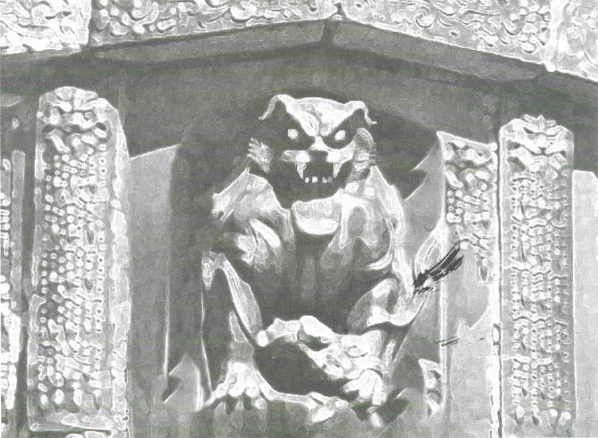
A KISS dragon approaches! Command?
The adventure chapter concludes with an infodump of lexicon terms which says “Here are the rest of the Jargonisms we didn’t have room to conspicuously cram into the margins of the previous pages.” Mind you, we’re 270 pages into this sucker.
Teind : A tithe of immaculum collected by prides as a reserve for the final battle with the Sanguinary. Not mentioned anywhere else.
Taint : Impure immaculum, created by screwing up a serenade.
Tautha : A mammalian pride, caretakers of the Sunedrion.
Terat : A drove pride who broke away from the Sanguinary and joined the Perpetual Society. Mistrusted, they believe in embracing their himsati form.
Torques of Almandia : Artifacts created by the Abzulim, they’re magic gorgets to protect against beheading.
The Transfer : The ability of an immortal to possess a scion he creates.
Triad : A team of Nimrod, always including one gossamer.
Pride : Political factions of immortals. Oh, and I have to share this: “The prides are protected under the Pandect, working to maintain the Silence while vying for Visage sufficient to lead the others against the Sanguinary during the Rapture.” Why is this in the “T” section? I think someone fucked up the layout and then caught their mistake.
Trine : As we’ve already been told halfa dozen times, they’re three powerful entities the Anopheles summoned forth from the Crucible. Also called the Lost Trinity.
True Name : “The sound made by the himsati in its natural state.” I have no idea what this means. I like to think it means immortals are like Pokemon.
Tryst : The rare child of an immortal and a mortal, blessed with superior talents, a long lifespan, the power to play serenades, and the unique ability to create mantles.
Tumuli : Places where solitaires collect immaculum to prepare for the Rapture. Not mentioned anywhere else.
Twilight : What immortals call mortals.
Unmen : The avatars of the Sanguinary. (The Rime, the Dust, the Crone, and the current avatar, the Silhouette.)
Vail : A unit of immortal currency, measuring immaculum.
The Venery : An inward spiritual journey to weaken/destroy one’s avatars to gain immaculum.
Vetala : An Anopheles Quiet Culture in India, considered to be vampires.
Visage : An explicit ranking of immortal reputation, tracked and awarded by the Jury. In the Perpetual Society, the pride with the most collective visage is the Scepter, in line to lead the prides when the Rapture comes.
Vogues : Commonly known serenades.
Vow of Humanity : The principle of the Apocrypha, to oppose immortals and all their works.
Vox : The crystalline vocal cords of immortals, which allow them to manipulate reality and play serenades.
Weald : Any of the plants that are part of the Sunedrion.
Whacked : Immortal slang for killed.
Ys : The realm of mantles under the oceans.
Zamzumim : The ruling pride of the Abzulim. Not mentioned anywhere else.
Zuzog : An anti-Sunedrion planted by the droves, so that the Sanguinary can spread its consciousness through plant life.
Next time, on Immortal : Guns. Lots of guns.
Weapon Appendicitis
Original SA post
Immortal: The Invisible War, Part 16: Weapon Appendicitis
Immortal provides an appendix with stats for about a zillion weapons. This is patently silly--aside from the fact that this is a game about superskilled ancient immortals, the only stats that weapons have in Immortal are Base Damage, Strength Minimum, and Recoil. They think that the difference between a .357 handgun and a .45 handgun is meaningful, but don’t list ammo capacity or concealability as stats.
These several weapon charts reveal something very important about Immortal’s combat system: the people who wrote it don’t fucking understand it. Because Immortal’s task resolution system is weird, let’s recap it briefly: When the thing you’re trying to accomplish has some complication, you don’t just get, say, a -2 penalty to the skill check. You have to make a second check (“hostile”), possibly at a separate difficulty and using a different Characteristic+Skill. You have to succeed against every hostile to succeed at the task. Every roll autofails on a 1.
So if you’re trying to shoot someone with your rifle, and they’re behind cover, you’re rolling Expertise + Pistols (total opposed by enemy’s Dodge total) and Movement + Gamut* (difficulty based on amount of cover, provided by a chart) and have to succeed on both rolls. Since every roll fails on a 1, every skill check in this game has a 10% chance to automatically fail , which increases to 19% on two hostiles, 27% on three, 37% on four, and 41% on five. If you actually play by the book, this is something that can happen easily--there are hostiles for bulky weapons, called shots, multiple shots, being wounded, bad weather, poor visibility, long range, cover, and several more written into the rules. You might have to make four separate skill checks--different Stat+Skill, different difficulty for each one--to shoot a guy. Then he rolls to dodge.
* “Gamut” is one of the Legacies, special mystic Talents that only immortals can have, which are very expensive and are used in rolls against situational hostiles. This means that mortals are making unmodified Characteristic rolls against all their secondary hostiles--this game accidentally models the reality of most bullets missing their targets.
Why am I bringing this up again? First, because Immortal is so scattered that I sometimes come to a full understanding about an aspect of the system only after I’ve already reviewed that chapter. Second, the stats of the weapons don’t make sense according to the combat system. To break it down simply:
Melee weapons (and primitive ranged weapons) have a “minimum Strength to avoid Bulk hostile,” but they don’t tell you what difficulty to use if you do run afoul of it. The “Bulk hostile” entry in the combat chapter tells you to refer to this one, which doesn’t have the information.
Firearms have a listing for “Recoil Hostile Value” and don’t say anything about not having to roll it if you have enough Strength. However, the “Firearm Recoil” entry in the combat chapter a) says it only applies to automatic weapons firing multiple shots per round, and b) bases the difficulty on the number of extra shots, not the size of the gun. These charts list a Recoil value for each gun--I’m thinking that means you always have to roll a Recoil hostile when you fire a gun, and you need to be a hulking he-man in order to fire a big game rifle without the shot going wild.
Still, assuming you can find some way to deal with the weapon rules, your transcendant alternative personality role-playing experience can include chopping your enemies up with...
...Wavy-bladed Arabian daggers!
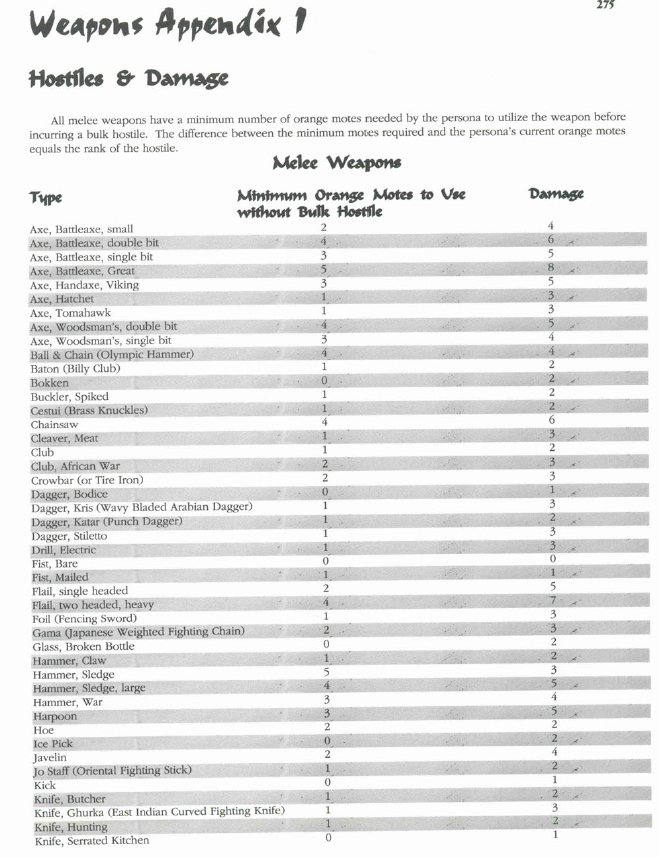
Archaeologist’s picks!

Fishing spears!
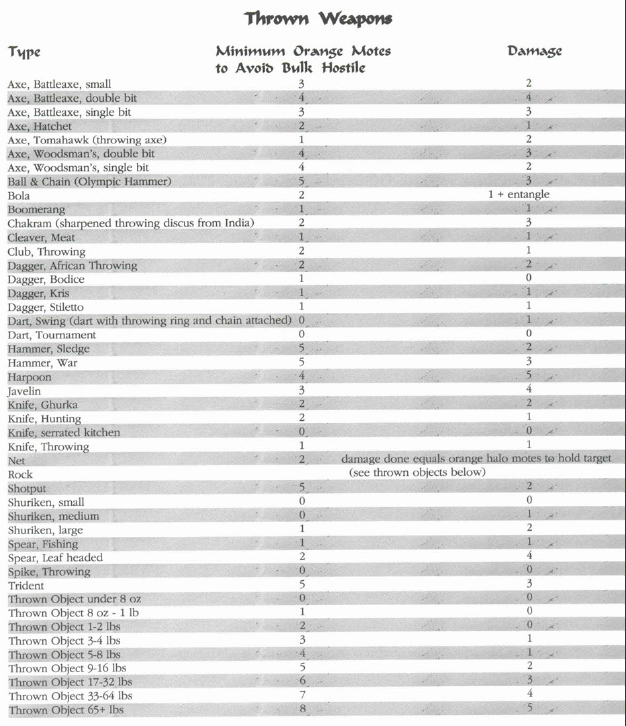
Frog crotch arrows!
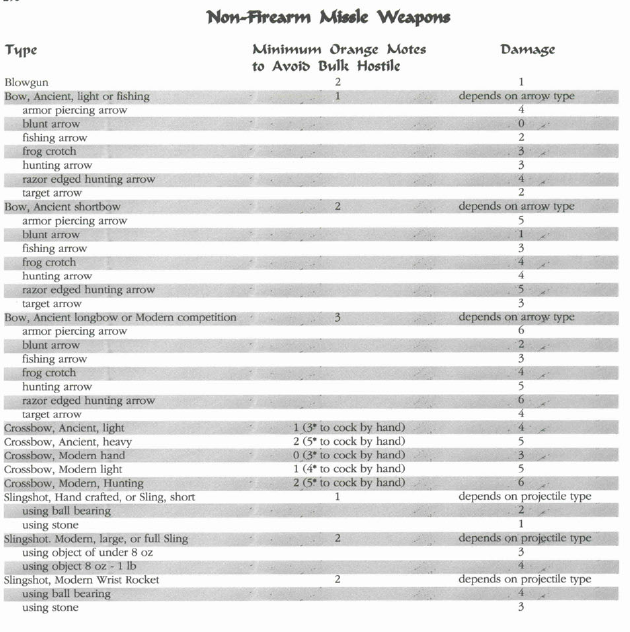
Mausers!

Weatherby rifles!
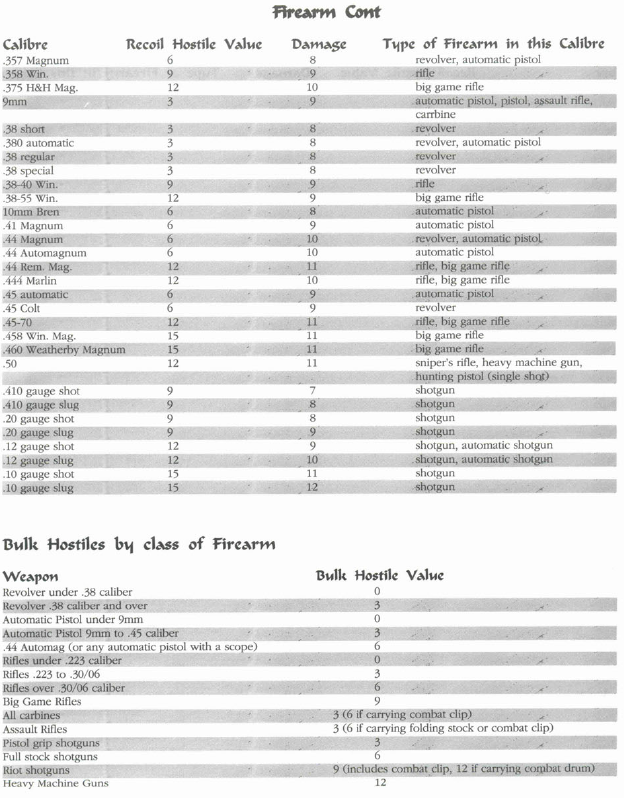
Shot put!
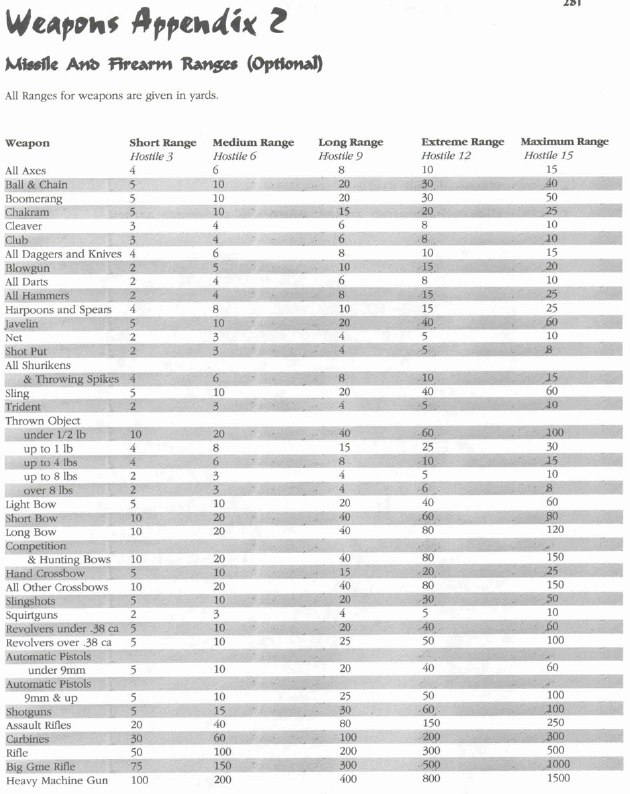
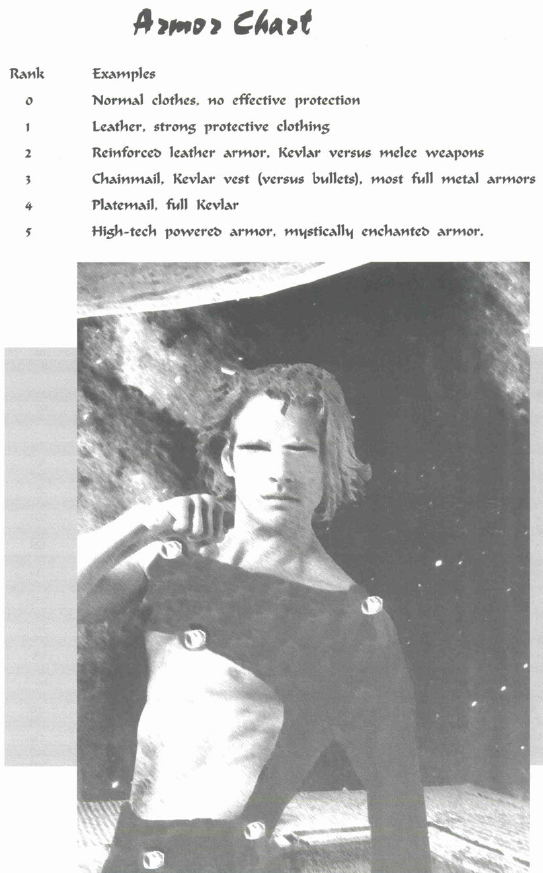
Armor? Why, yes, I wouldn’t want my enemies to shred THESE ABS.
The last piece of actual content in the book is a quick-start guide that actually explains character creation and setup in a concise, sensible manner; it’s much better than the full chapter on character creation. In between the weapon appendix and the quick start guide, however, are advertisements for current and “future” (read: nonexistent) Immortal products, designed to explain things like “How you actually run a campaign in this setting” and expand on all of the ideas like “running your whole game in a cyberpunk pocket dimension, a time travel journey, or in the realm of dreams” that the book casually throws out but for which it provides no guidance. In case you’re wondering, yes, the rest of this review is mainly copypastes that I find hilarious.
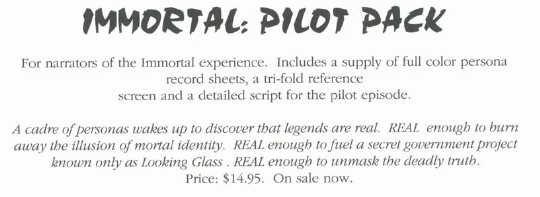
REAL enough to actually be released!

You only need a few dozen dice to play this game. Pre-inked for maximum classiness.

Can’t these assholes just write “campaign guide?” A series of adventures about a dragon ghost, a sea monster, and a brain-damaged giant queen bee thing.
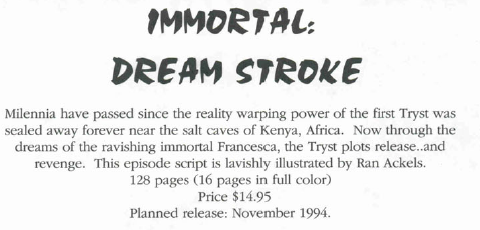
In November 1994, Gingrich seized control of Congress, Bush became governor of Texas, and Reagan revealed his Alzheimer’s Disease. Coincidence? I don’t think so.
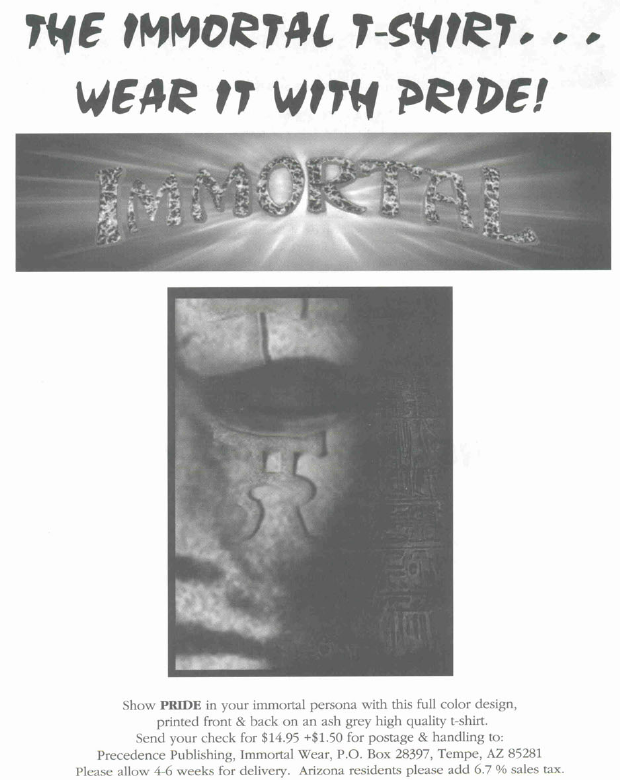
I’m sure everyone who wore this t-shirt was forever associated with Pride.
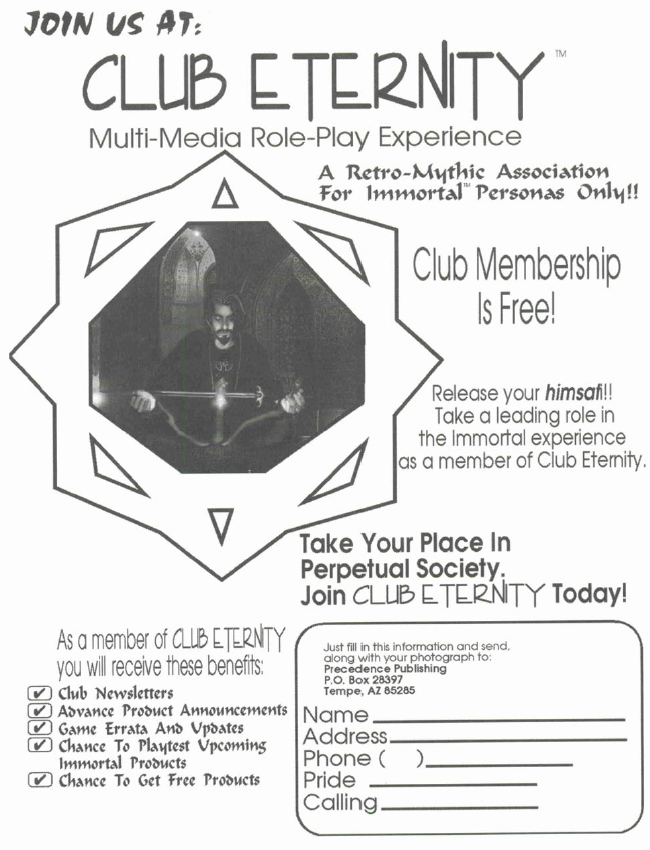
Why not just call it the Retro-mythic Association for Immortal Personas (RAIP)?
Next time, on Immortal : A brief review of the Quick-Start Guide.
Personas will begin with 15 motes of immaculum (points useable to develop the persona). Persona creation involves allocating immaculum into six different areas of ability (called the halo colors) and choosing skills (called talents and attentions).
Original SA post
Immortal: The Invisible War, Part 17: Personas will begin with 15 motes of immaculum (points useable to develop the persona). Persona creation involves allocating immaculum into six different areas of ability (called the halo colors) and choosing skills (called talents and attentions).
Immortal has a quick-start guide that does a shit-ton better at explaining the basic setup of the game than the character creation chapter. The part about being a millions-year-old animal uplifted to a human who has human past lives is still as weird and shaky as ever, but at least they explain how to spend your points and what the attributes are. They give brief advice on creating yourself as your character, but also say that you hardly need to create an identity for your character before you assign the stats--after all, in the course of the game you’re going to discover past lives and shit like that, so you can develop whatever personality traits you want as you go along.
The guide explains that you spend your immaculum motes on your Characteristics, and that for memory points you can buy free immaculum points that shift around as you desire.
After buying your Characteristics, Talents, and Attentions, the guide only spends a couple sentences suggesting that you can choose a pride, a calling, and a himsati form--these are apparently way less important at character creation than their equivalents would be in a White Wolf game, and it’s assumed you can decide or discover all of that in the course of play.
You wanted an example of play? The game provides one itself. Although I wouldn’t go so far as to say the designers understand their own writing, they seem to recognize how damned complicated it is and are at peace with that:
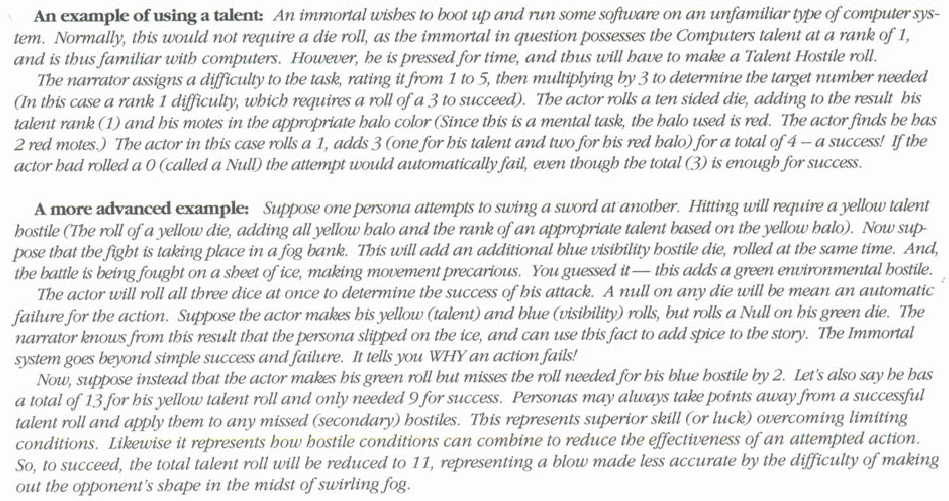
The Quick Start guide concludes with a few paragraphs explaining What is your game aboouut better than most of the rest of the book. To sum up: You’re immortal. You’ll be drawn into the Stratagem, the intrigue of immortal politics. Open violence is forbidden, so you’ll be locked into a game of outwitting and humiliating your opponents to earn respect. You’ll begin the game having emerged from Lethe, a state where you forgot your immortal past, so all the prides are looking at you as a potential recruit or pawn.
The prides are immortal tribes, united according to political beliefs and common heritage. Most immortals will align themselves with a pride and a Calling, an official job within immortal society. You’ll also discover your himsati, a primal animal or elemental form you can assume when in danger. By earning respect in Perpetual Society, you earn Visage, a psychic presence that allows you to dominate lesser immortals. You earn Visage by exposing your political enemies’ weaknesses; this called “counting coup.” All the prides are out to count coup on each other, and there are always plots about to come to fruition, some of which may have been hatching for decades or centuries.
There are lots of things out there to interact with besides fellow scheming immortals: The Sanguinary is an ever-present force that wants to destroy all immortals. The Solitaires are immortals who reject the Stratagem and the Jury which governs it. The Apocrypha are a human cult who have always opposed immortals. D’arcade is an immortal Mafia, running a powerful black market. The Droves are thralls of the Sanguinary and the enemies of all immortals. The Outlanders are very powerful Solitaires; everyone knows they’re up to something, but nobody knows what.
So that’s Immortal. Brimming with ideas, isn’t it? It’s too bad that most of them were critically undeveloped. The game fails to back up its setting assumptions with clear rules--a prominent example is the Ripple, the reason immortals don’t throw their magic powers around on Earth for fear that the Sanguinary will notice them. What determines if It notices? What happens if It does? Oh, and about going into the Morpheum to fight the Sanguinary in the dream-realm...how do you actually “fight” it? What can you do to it or its minions in dreams? What adventures are to be had there?
Putting aside the rules and taking a hard look at the setting itself, Immortal’s problem is clear: It’s a poorly-laid-out setting bible for a game line that ultimately was not developed, instead of a tight, focused game with room to grow in supplements. The basic premise of this game asks you to accept that an alien space god crash-landed onto Earth, fragments of it uplifted animals and plants to immortality, and at some point those immortals forgot their immortality to lead a series of mortal lives, which are still kicking around in your immortal character’s head. If that’s the jumping-off point, does the corebook really need to mention things like specific mortal cults and magical artifacts, especially when it doesn’t have room to expand on them? My understanding is that Ran Ackels conducted Immortal as a successful homebrew for years before publishing--he should have given us a good game and left us wanting more, instead of opening his head and indiscriminately pouring its contents into his book.
Two random questions: One, opening fiction implies that immortals who underwent lethe are just a fraction of the immortal community. Does that mean that most of the immortals the PCs meet are millions of years old, and have all those memories and all that experience? How can they ever measure up?
Two, did they actually playtest this thing?
Immortal ends, not with a clash, but with an index. A one-page index. For all of this...this.
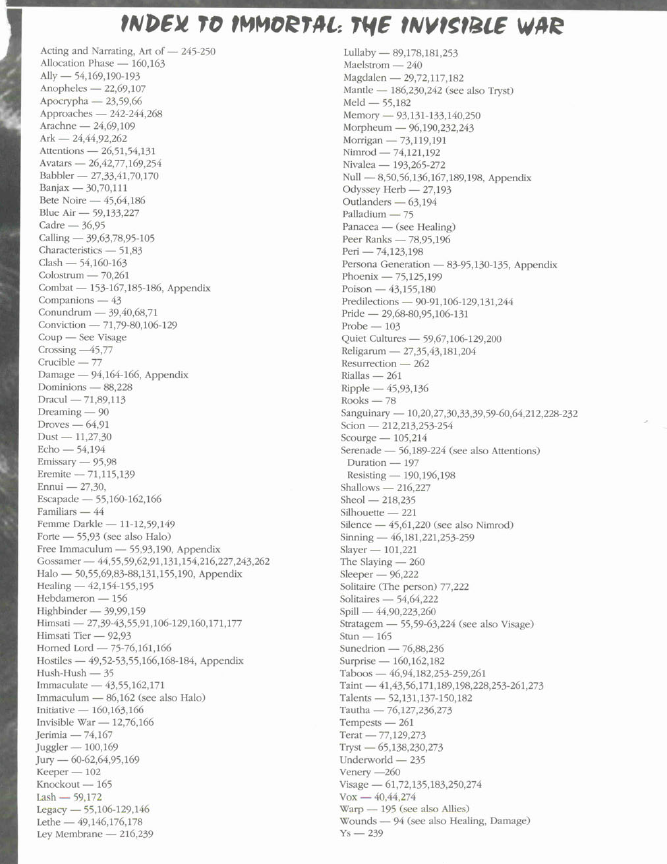
*~No Sanctuary Is Eternal~*
Next time, on Immortal : I eventually review the revised version of this turgid, shambling beast.